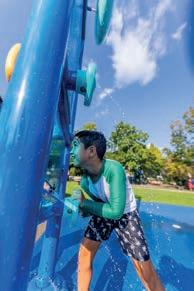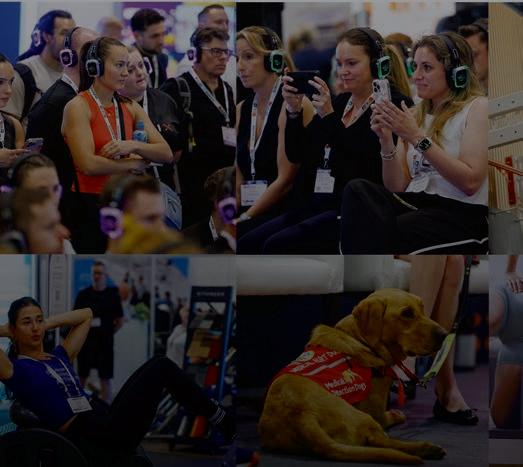The
GEOFF WEBB

Two decades at the helm of GMA

FUNDING the
GRASSROOTS

How should the government’s £400m investment be spent?


The

Two decades at the helm of GMA

FUNDING the

How should the government’s £400m investment be spent?

Could it challenge padel?






A passion for creating the ultimate quality turf for a wide range of sports applications
Backed

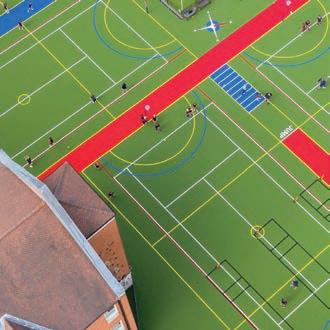




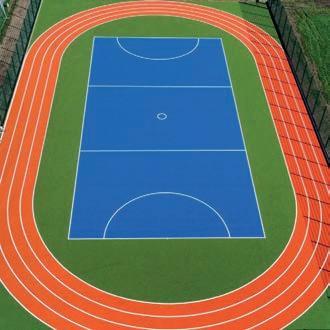





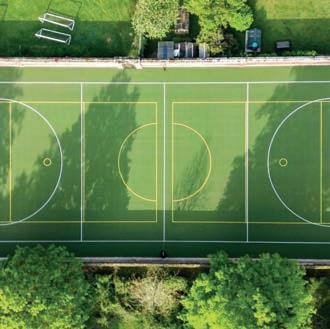


















































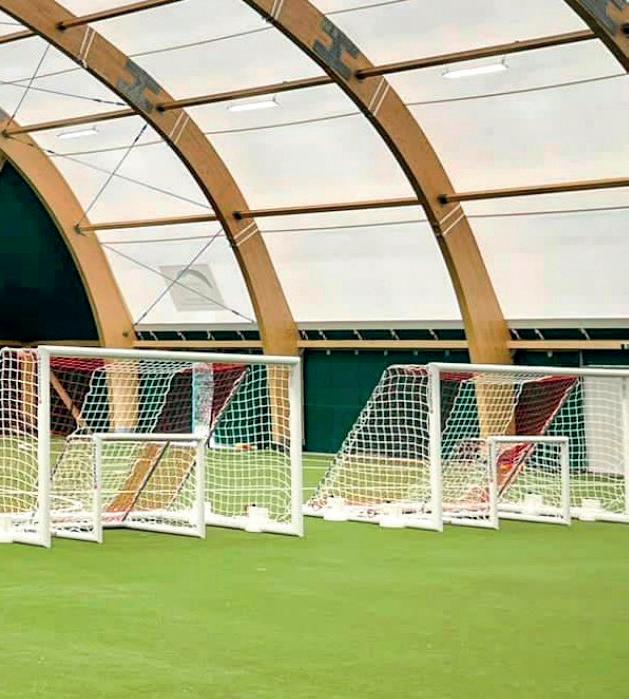
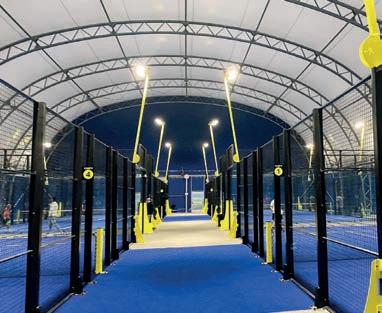


Th e Government’s announcement of a £900m package for sport and physical activity – including £400m earmarked for grassroots facilities – earlier this year has been heralded as a “gamechanger”. On paper, the commitment is hugely welcome. More investment means more opportunities to get people active.

The work of Will Watt and State of Life points to a possible answer – as those who attended the CIMSPA Conference in September will know (where Will was one of the speakers). By using a “wellbeing value” metric, State of Life demonstrates not just the economic but the social return of physical activity. If this latest injection of funding is to be truly transformative, measuring what matters will be key.
The real question is, however, where and how this money will be invested. Past experience shows that funding can too easily flow into projects, programmes and initiatives that look good in press releases but fail to shift the needle on participation. If the goal is to get more people moving, we must avoid repeating the mistakes of the past.
That also raises another challenge: how do we know if the investment has actually worked? Counting pitches, gyms, or refurbished clubhouses is one thing – but what if the true measure of success is broader?
Speaking of CIMSPA, I would like to congratulate CEO Tara Dillon and the entire CIMSPA team for introducing professional status to sport and physical activity professionals. It is a historic moment. For a long time, employers have asked for a way to recognise not just the qualifications that people hold, but the real skills, knowledge, competencies and experience they bring to their roles. That recognition now exists, providing confidence and consistent benchmark.
Tom Walker, Editor
The o cial magazine of
Tom Walker
Editor
T: +44 (0)7796 512769
E: tom@nationmedia.uk
John Challinor
Publisher
T: +44 (0)7971 043396
E: john@nationmedia.uk
Register for your free subscription at www.sportsnation.uk






05 From the editor Where is the action?
09 News
The latest industry news from around the sports and physical activity sector
24 Column: Richard Shaw (SAPCA) Pickleball’s DIY spirit
26 Column: Rachel Williams (Women in Sport)
Is it time for school sport 2.0?
28 Column: Huw Edwards (ukactive) The key to improving mental health 30 SAPCA Technical Conference 2025 A look ahead at the November event

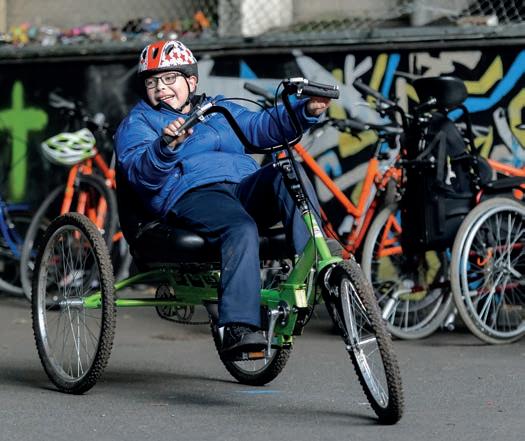
32 Uniting Voices
The SRA has published its 2025-30 strategy
34 Interview: Geoff Webb
The Grounds Management Association CEO looks back at his two decades in the role
40 Together we move How a council is using running to deliver its strategy
48 Breaking barriers Report charts disabled people’s experiences with sport
52 Promoting excellence in facilities Report from a special one-day conference in Belfast
56 Creating value Highlights from this year’s active-net Scotland event








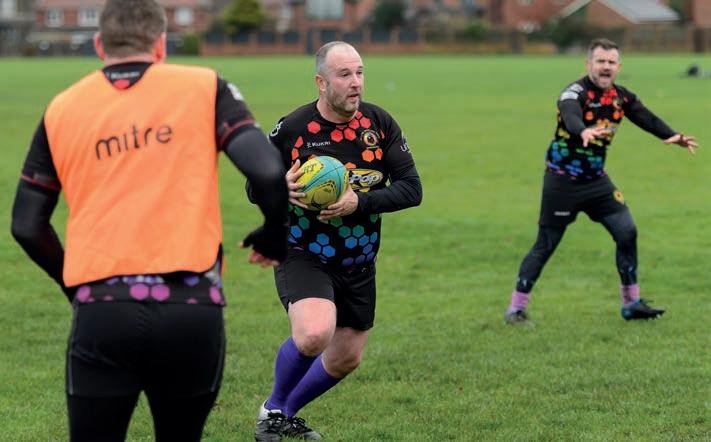


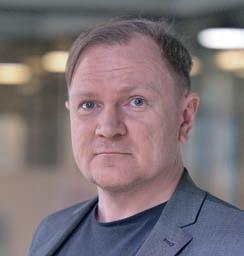
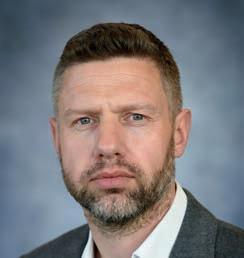
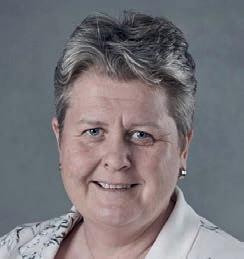
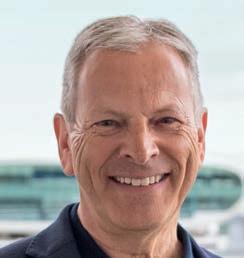

SportsNation is the single, authoritative voice for the provision, delivery, maintenance and management of sports and physical activity facilities. Published bi-monthly, the magazine focuses on the people, places, policies and products that help to build active communities throughout the UK. Subscribe now and we will email you a complimentary copy of the magazine every two months.
As the official magazine of SAPCA (the Sports and Play Construction Association), every issue of the magazine will also include information about technical guidance, funding, standards and product innovations.
SportsNation is
by
Ltd in
with the Sports And Play Construction Association (SAPCA). www.sapca.org.uk This publication is protected by copyright and no part may be reproduced, transmitted or stored in any print or electronic format without the written permission of the publisher. Every effort has been made to ensure the accuracy of the contents of this publication and SportsNation accepts no responsibility for any error or misrepresentation. Opinions expressed by the contributors and advertisers are not necessarily those of the publisher and we do not accept responsibility of losses or damages arising from them.
The government has set a target of “more than doubling” priority access to grassroots football pitches for women and girls, as part of a series of plans announced following the Lionesses winning this year’s Euro championship.
As part of its Plan for Change, the measures will dramatically increase the share of primetime slots for female teams at governmentfunded facilities across England over the next five years, with a long-term target of reaching equal access as demand grows.
In partnership with the Premier League and The Football Association, the Government will be launching a new grants scheme to be delivered by the Football Foundation, which will focus on creating welcoming, safe and accessible facilities for women and girls at existing grassroots sports sites. There will also be a new approach to school


sport, which will see schools and national governing bodies of sport work together to make sure that all children have access to high quality sport. By working to connect local sports clubs, national bodies and schools, a new national network
will be created, with the aim of “making sure girls have the same opportunities as boys to play sport at school”. It follows recently announced plans by the Prime Minister to reform school sport to deliver equal access for girls alongside boys.
The SAPCA Code of Practice for the Construction of Padel Courts has been updated and can be downloaded (alongside all other codes) for free from the SAPCA website.
The code has been produced in consultation with padel’s national governing body, the LTA, and is recognised and
supported by the LTA for the construction of courts in the UK.
The code has a new section on maintenance and enhancements to guidance regarding the design and construction of suitable base works for the UK market.
This is the second update to the code this year.
An all-party parliamentary group (APPG) roundtable has discussed the importance of protecting community sport and recreation spaces within the planning system.
Hosted in the House of Commons by the Sport and Recreation Alliance (SRA) and attended by by MPs, peers and sport and physical activity sector representatives, the panel discussion featured contributions from Sport England, the LTA, The FA and the England and Wales Cricket Board (ECB).
The session was chaired by APPG Co-Chair, Baroness Amanda Sater, with input from several NGBs, as well as Fields in Trust and ukactive.
The roundtable was organised in light of Government proposals to remove a number of statutory consultees in the planning system, including Sport England. This has led to significant concerns amongst the sport and recreation sector that this
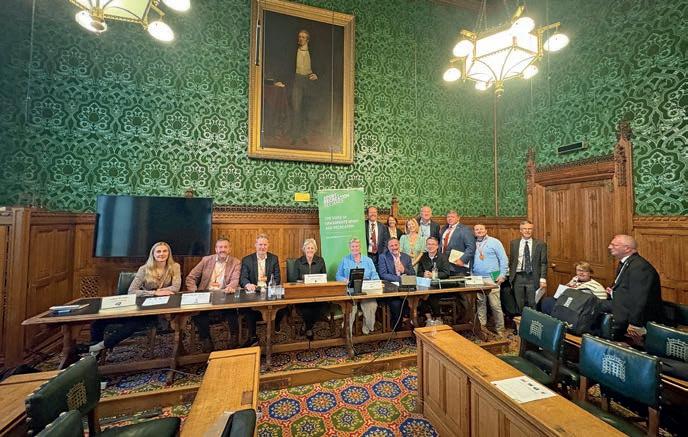
would remove vital safeguards which protect playing fields and sports facilities from development and ensure continued community use.
Speaking on the panel, SRA Chief Executive, Lisa Wainwright MBE, said: “While we understand the government’s ambition to build more
The roundtable was organised due to Government proposals to remove statutory consultees in the planning system, including Sport England
houses, we are deeply concerned the proposed changes to Sport England’s statutory role will neither significantly increase the pace of development nor lead to better outcomes for local communities.
“This is why the SRA launched the Protect Where We Play campaign.”
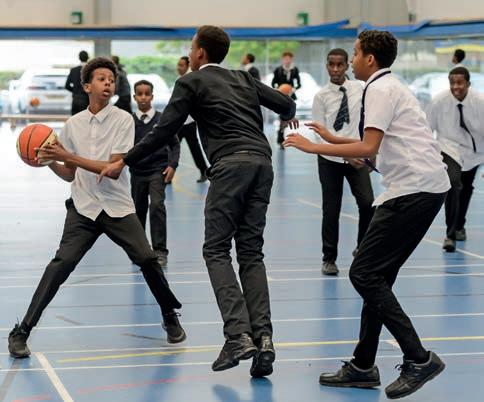
The UK Government and the US-based National Basketball Association (NBA) have revealed plans to collaborate on a variety of initiatives to grow basketball across the UK.
As part of the partnership, the NBA will invest £5m into grassroots development and fan engagement programmes through 2028, expanding the NBA’s existing programming that reaches more than 50,000 youth players across the UK annually.
This will be matched by £5m of government funding, earmarked for basketball by the DCMS as part of a wider £400m investment in grassroots announced earlier this year. It is hoped that the £10m investment will begin delivering on the potential of basketball – which is often described as “the secondmost-popular team sport for young people”.







In an industry where cost is often the focus, Active IQ stands apart by delivering more - more quality, more support, more value. We know that price matters, but when it comes to qualifications, reliability, and long-term success, quality is non-negotiable. That’s why we offer:
Industry-leading qualifications – Designed with employers to meet workforce demands



Comprehensive support – A dedicated team invested in your success
Added value – Free CPD, FitPro membership with eLearning purchases, and extra resources at no cost
A trusted partner – Transparent pricing, no hidden fees, and a gold-standard reputation.


Why settle for less?
Begin with better. Choose Active IQ. Find out more
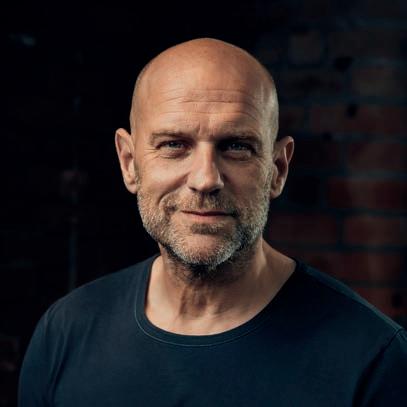
In gyms and studios, music is often the driving force that gets people moving. But in sport, whether at grassroots or elite level, it takes on an even sharper edge. It’s not just about motivation. Music can influence speed, focus, coordination, and even recovery. With over 30 years in music and now leading Pure Energy Music, I’ve seen first-hand how the right track can turn training from a routine session into a performance booster.
So how does music affect sports training compared to general fitness? The key difference is purpose. In fitness, music keeps members engaged and energised. In sport, it’s about performance outcomes. Athletes

use music tactically - whether that’s faster tempos to sharpen reaction time, steady beats to improve coordination, or calming soundscapes to aid recovery. And science backs this up. Synchronising movement with rhythm improves efficiency, helping athletes move more economically. Up-tempo tracks can trigger adrenaline responses that sharpen speed and power output. Just as importantly, low-BPM music helps reduce cortisol, speeding up posttraining recovery. It’s why music isn’t just “nice to have” in sport - it’s a performance tool.
Not every training session calls for the same soundtrack. Technical skill drills often work best with lower-BPM, rhythmically consistent tracks that keep athletes steady without overstimulation. High-intensity conditioning, by contrast, thrives on fast, driving beats that help players push harder for longer.
Many professional and semi-professional athletes take this further, building personalised music strategies into their training cycles. They’ll shift playlists depending on whether they’re in heavy training, tapering before competition, or recovering after an event. Music becomes part of the programme - as deliberate and essential as nutrition, recovery, or sleep.
The role of music in mental preparation is massive. Prematch playlists aren’t just about hype; they’re about mindset. Some athletes want aggressive, high-BPM


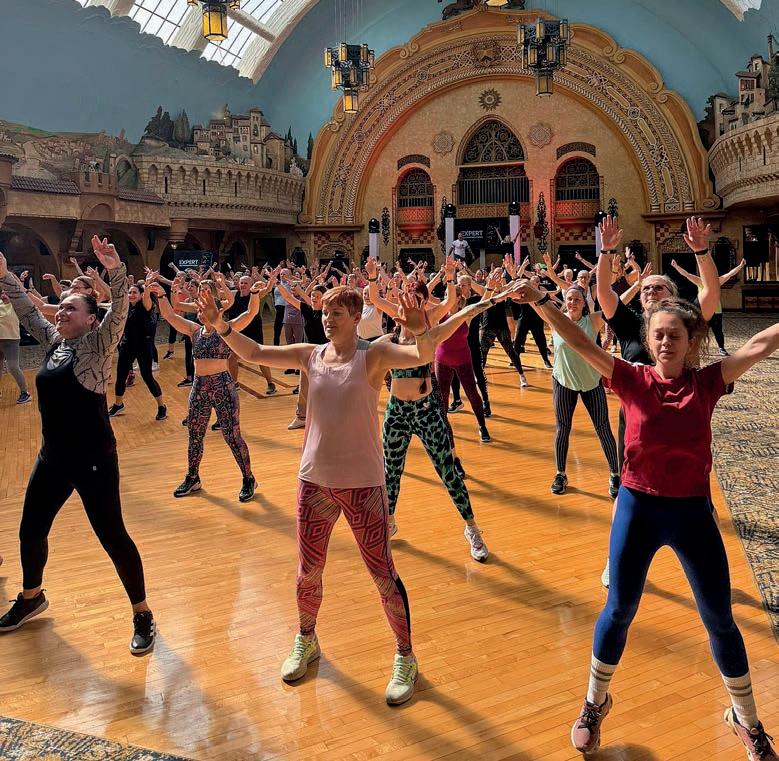
tracks to get “in the zone,” while others prefer steady, confident rhythms that calm nerves and sharpen focus. Used well, music builds focus, confidence, and competitive mindset. It helps athletes manage nerves, tune out distractions, and lock into the mental state that makes performance possible.
Personal preference matters more in sport than in general fitness. An athlete’s playlist can feel almost like part of their kit bag; tailored to them, fine-tuned over time. But music isn’t just personal. In team environments, it also builds cohesion. Shared playlists in the changing room or during group sessions create a sense of identity. When a squad warms up to the same soundtrack, the rhythm becomes collective, helping to foster team spirit. Striking the balance is key: the music should motivate without distracting and unify without overwhelming.
One thing I’ve learned is that the same playlist loses impact if it’s played on repeat. Just as athletes periodise training, music should be refreshed regularly to prevent mental fatigue.
That might mean introducing new sub-genres, shifting tempos to reflect training cycles, or tailoring playlists around competition calendars. There are also proven sweet spots: fast, high-BPM tracks for explosive drills. Mid-tempo rhythms for coordination and flow. Slower, calming soundscapes for recovery and regeneration. Keeping this balance ensures music works across the full spectrum of sporting demands.
At every level of sport, athletes look for marginal gains. Music delivers those gains in performance, mindset, and recovery. It can lift a player from tired to energised, sharpen reactions, or calm the nerves before stepping onto the field. And when shared, it builds cohesion, turning a group into a team.
For me, after three decades in the music industry producing, DJing, and now shaping music specifically for fitness and sport, the conclusion is clear: the right track is never just background noise. It’s a performance tool, as critical as the training plan itself. In sport, as in music, sometimes the difference between good and great comes down to finding the perfect rhythm.
For further info, visit pureenergymusic.com

Out of the three new appointments, Sarah Massey has the most experience working in sport
Tom Gribbin, Vaughan Lindsay and Sarah Massey have joined the board of Sport England.
The three new members were appointed by the Secretary of State for Sport and each will serve a term of three years.
Massey has more than three decades of experience in sports leadership, global event strategy, and planning. She is currently the managing director of the Women’s Rugby World Cup England 2025, set to be a landmark event for
John Gillespie has been named as the new CEO of Powerleague, following the retirement of Christian Rose, who has held the role for the past seven years.
Gillespie, the company’s current Chief Commercial, Customer and Marketing Officer, will be tasked with overseeing the company’s transformation from a smallsided football centre operator into a multi-sport operator.
This will see Powerleague making a major investment into padel, which will see it introducing padel courts at nearly half of its clubs nationwide.
Powerleague currently operates 43 clubs across the UK, welcoming more than 9 million customers annually. In addition to its core football offering, the business manages over 250 third-party venues that provide both football and netball.
Gillespie will now oversee a £14 million UK-wide rollout, delivering 76 courts across 18 clubs by
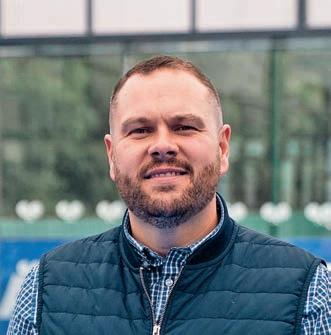
2026. The new club is aimed at making the sport accessible to over 200,000 players annually, and cement Powerleague’s ambition to become the nation’s leading provider of urban sport. Powerleague Group was recently acquired by Broadsword Investment Management Ltd (BIM), a UK-based private equity firm focused on real estate-backed growth opportunities.
women’s sport. Prior to this, she was the CEO of the 2022 World Athletics Championships in Oregon, USA and her career spans various roles across Olympic and Commonwealth Games, as well as Cricket and Hockey World Cups.
Gribbin is the founder of Planet League, a platform that mobilises sports fans to live greener, while Lindsay is a former CEO at Climate Impact Partners and advisor to a businesses interested in the carbon markets.

David Leed joins Blakedown to drive growth
SAPCA member company
Blakedown Sport & Play has appointed David Leed as its new Business Growth and Commercial Director.
Leed has more than 25 years of experience in the sports and construction industry, spanning consultancy, clientside and contracting. In his new role, he will focus on strategic growth, client partnerships, sustainability and innovation.
Ready to smash your goals with a team that’s at the top of their game?
Working with Fordingbridge was a breath of fresh air! One of the most professional, respectful and diligent contractors we’ve ever worked with. Would highly recommend and certainly use them again.
Steve Mills, General Manager, Nottingham Tennis Centre
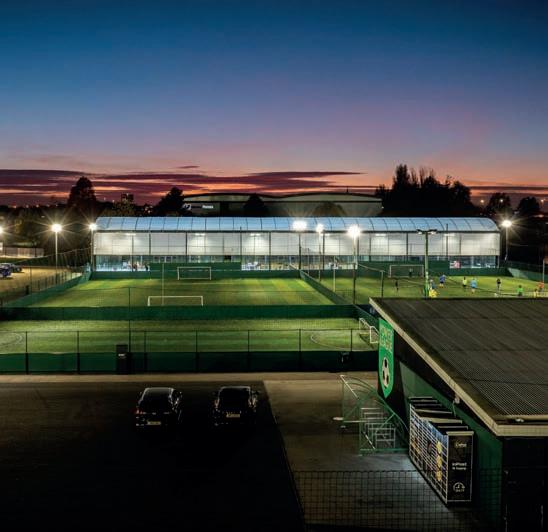
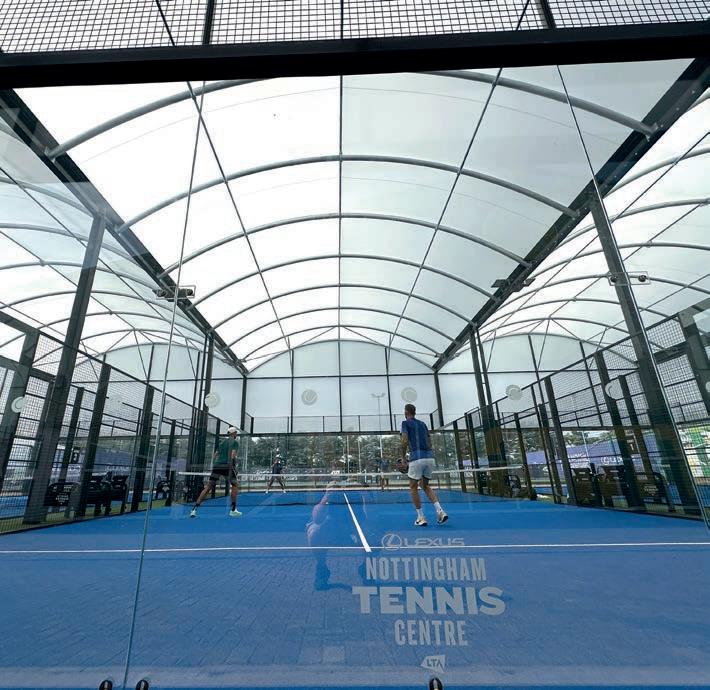
5 benefits of working with the UK’s leading padel court canopy provider:
✔ Bespoke solutions to meet your exact needs
✔ Expert teams looking after your build from design to installation
✔ All canopies fully compliant with SAPCA’s code of practice
✔ All projects meet the highest sustainability standards
✔ Industry leading 25-year guarantees on every structure
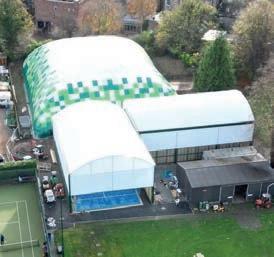
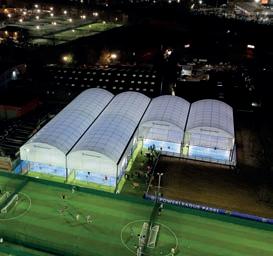
Nearly four in five women (78%) working in football have experienced discrimination in the last 12 months, while nearly two thirds (63.5%) experienced sexist banter or jokes.
The findings come from the latest industry workforce survey by Women In Football (WIF), which highlights the “bleak reality” faced by females working in the sport.
Now in its fifth year, the WIF survey highlights three “indisputable realities” for women in football. These are that discrimination is persistent and widespread, the systems for reporting discrimination are ineffective and that workplace culture itself can be a significant barrier.
WIF Chief Executive, Yvonne Harrison, said: “The headline data from the 2025 survey remains relatively static and, in many areas, bleak. These are not just numbers: they are the lived experiences
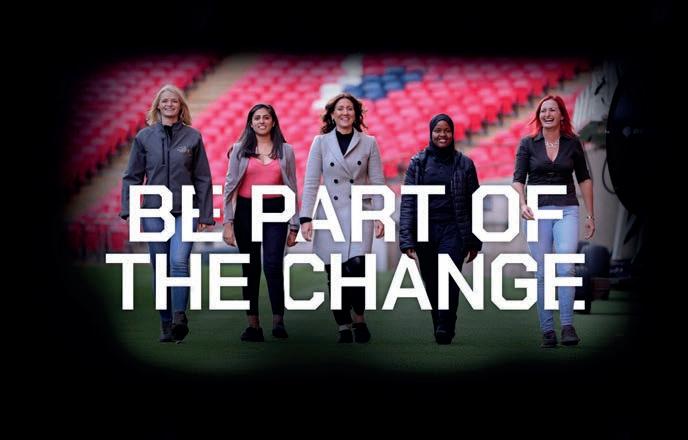
of people working in the game, and they deserve better.
“We can safely assume that the real levels of discrimination are even higher, with a third of female respondents stating they had not reported incidents due to a lack of trust in workforce processes.”
While the survey highlights the challenges, respondents did express hope for the future – 77% of women are optimistic about the prospects for women in the football industry, while 55% of women said the football sector is one where women can excel.
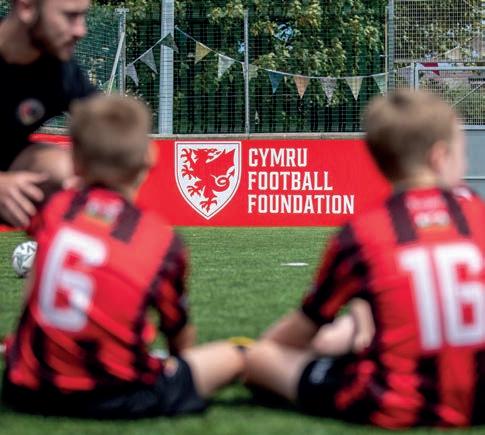
Cymru Football Foundation’s (CFF) investment in facility projects across Wales has reached £20m. Launched in October 2022, the CFF has allocated more than £6m in 2025 alone, supporting 30 projects nationwide.
Since 2022, the investment has resulted in 41 new or upgraded artificial pitches, 19 new grass pitches and 34 clubhouses and changing rooms. £8.5million has also been invested into deprived communities across Cymru while over £9million has also gone into multi-sport venues.
The CFF’s mission is to support the development of football facilities through investment, assistance and guidance, supporting The Football Association of Wales’ commitment to create “inspirational and fit-for-future facilities” on and off the pitch.



Musco’s




























The invisible strength beneath every game. Whether it's professional or community pitch –with ProGame Shock Pads, every match is safe, comfortable and sustainable.
Trusted for over 15 years on thousands of artificial turf pitches worldwide.
Top-level performance for football, hockey, rugby & more – compliant with FIFA, FIH, and WR standards.
Extremely durable & reusable – for a consistently great playing experience.
Efficient drainage & dimensional stability –even under heat, moisture, or heavy use.
Designed with sustainability in mind – from raw materials to eco-friendly design.
Installed at Kilmarnock FC and Hyde FC – ready for your pitch!















Durability
Constant performance for the entire service life.
Impact protection
Optimizied shock absorption and vertical deformation.
Resilience
Excellent recovery properties.
Weather resistance
Excellent drainage, high temperature stability, no water absorbtion.
Easy installation
Quick and easy installation.
Sustainability
Reusable for many installations.


The study forms part of Women’s Rugby World Cup 2025’s ‘Where We Belong’ campaign
The UK sports sector is missing out on female job applicants due to perceptions of ease of accessing careers.
According to research commissioned by Women’s Rugby World Cup England 2025, there is widespread interest in sports careers, with nearly three in five (59%) adults in Great Britain willing to apply for a job in the sector. However, there are particular challenges faced by women and individuals from lower socioeconomic backgrounds.
Just under half (48%) of women say they would apply for a role
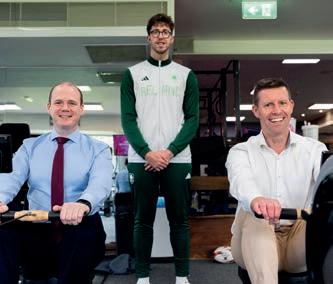
in sport, compared with over seven in 10 men (72%). There is a significant gender divide in perceptions of comfort being themselves in a sports workplace (49% of women versus 72% of men) and confidence in having the right qualifications to apply (44% of women versus 63% of men).
Men are also more likely to have taken part in initiatives designed to open up sports industry careers (38% versus 20%), highlighting access issues across the sector.
The study forms part of Women’s Rugby World Cup 2025’s ‘Where We Belong’ campaign.
SAPCA member, Copri Systems, has played a crucial role in transforming Killaloe Ballina Tennis Club in County Clare, Ireland into a modern, multi-surface venue – and making it perhaps the most sophisticated indoor facility in Munster, if not Ireland.
The venue used to be a two-court outpost on the banks of the River Shannon.
However, as playing numbers increased and demand for playing slots rose, new courts and facilities become a necessity.
With the help of Copri, the courts at the club have now been covered and fitted with LED lighting.
David Ryan, KBTC treasurer, said: “We are now an all-weather, all-times club. There’s LED floodlights in it so it can be used at night. It just opens up a huge amount of possibilities.
“People will want to come and experience playing indoors. And then the primary schools can use it.”
Sport Northern Ireland (Sport NI) has launched the Olympic Legacy Fund, which will see £1m being invested in modernising facilities and equipment owned by sports clubs and community groups.
The fund has been designed to maximise the support and involvement of local communities
through a crowdfunding model, delivered in partnership by Sport NI and fundraising platform, Crowdfunder UK. Organisations can apply for grants from £1,000 up to £50,000 with 65% provided as a grant and the remaining 35% expected to be raised through community crowd funding.
Work is underway on a new padel and pickleball centre in Farnham, Surrey, following a lease agreement between Rainier Developments and Hurlands Pickleball + Padel Club.
The £2.75m project will provide 13 indoor courts – 10 for pickleball and three for padel – at the Farnham Trading Estate.
Set to open in January 2026, the plans also include social spaces, yoga, Pilates studios, treatment rooms, changing facilities and a club shop.
Waverley Borough Council granted planning permission to Hurlands Pickleball + Padel Club in 2024. The council owns the building at the Farnham Trading Estate, with Rainier leasing the site on a long-term basis.
Councillor Mark Merryweather, Waverley Borough Council’s portfolio holder for property, said: “This is an exciting new investment for the borough, bringing fresh

The £2.75m project will provide 10 pickleball and three padel courts
opportunities for residents and local businesses, while supporting health, wellbeing, and active lifestyles.
“Once completed, the centre will offer residents the chance to try two increasingly popular sports, connect with others, and stay active in a modern, welcoming space.
We’ll continue working closely with Rainier Developments and Hurlands to support this fantastic project.”
The club will be open to players of all ages and abilities, with ‘pay and play’ sessions for newcomers and competitive facilities for more experienced players.

The government has announced funding for the construction of two new indoor cricket domes.
The investment will see domes being built in Luton and Lancashire and is part of a £1.5m commitment to help the England and Wales Cricket Board (ECB) build facilities in areas that are “desperately lacking” suitable places to play the sport. In sync with ECB’s Plan for Change strategy for 2025-2028 – a game-wide initiative focused on making cricket a more inclusive, diverse, and accessible sport for all – the two indoor venues will look to make the most of cricket’s diverse reach, opening up sport to people of all backgrounds.
The funding was announced as England’s second all-weather cricket dome was officially opened in Darwen, Lancashire. The facility is able to host cricket year-round, regardless of weather.

REGUPOL TURFPAD SP: NEWLY CERTIFIED ACCORDING TO EN 15330-4

Our sustainable prefabricated elastic layer REGUPOLturfpad SP is certified according to the European standard EN 15330-4, which defines the requirements for elastic layers. It is characterised by high durability, uniform physical properties, easy installation and water permeability.
sports.regupol.com



Cut your energy costs by up to 75% with Earlsmann’s highefficiency LED lighting solutions. Our experienced design team ensures every installation meets sports and environmental standards without compromising on performance. Speak to our expert team today and discover the best solution for your project. 01884 259917 www.earlsmann.co.uk sales@earlsmann.co.uk Why pay more to light your sports ground?

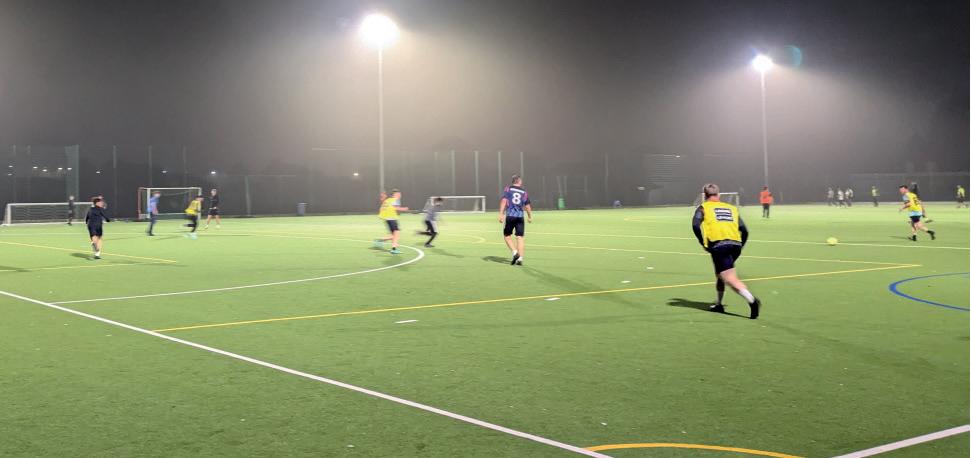





A new athletics track has opened at Palmer Park Leisure Centre & Stadium in Reading. Funded by Reading Borough Council and its leisure partner, GLL, the new track replaces an ageing surface.
The £500,000 track features a Polytan Rekortan PUR system – supplied by SAPCA member, Polytan. The surface has been designed to provide a smoother and flatter running surface and a consistent rebound and impact absorption, which will both help runners achieve faster times as well as prevent injuries and reduce stress on joints.
“Rekortan PUR’s high abrasion resistance, due to embedded EPDM granules in the wear layer, means it is excellently suited for running shoes with spikes and has an especially long lifespan,” Polytan said.
“It is the ideal surface for records and international
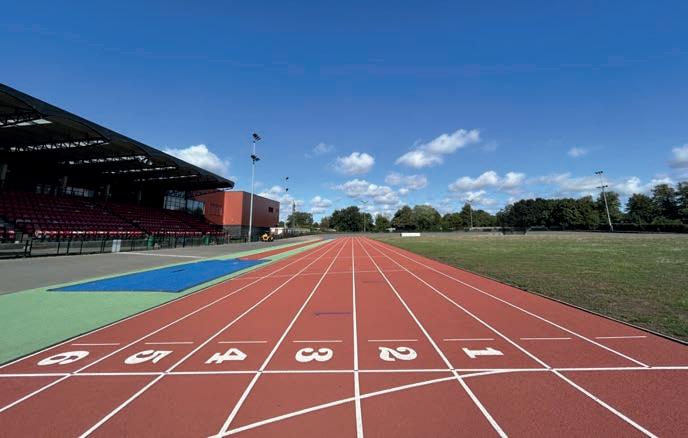
elite sports. Its special solid construction allows for optimal acceleration and performance.”
The new track also features Polytan SMART technology, a system which integrates precision timing gates directly into the track surface. This allows athletes

Funded by Reading Borough Council and GLL, the new track replaces an ageing surface
to monitor performance in real time, enabling data-driven training and diagnostics. Palmer Park’s athletics track has been designed with longevity in mind and should last for 30 years. It is home to Reading Athletics Club and Reading Roadrunners, plus other groups.
Work has been completed on an upgrade to the 3G pitch at Sport Lancaster – the sports hub of Lancaster University. The project included the removal and replacement of the existing pitch carpet, which has been fully recycled and reused. Security around the area has also been improved, including changes to the way users access the pitch.
The height of the existing perimeter fence has also been increased from three to six metres to prevent unauthorised access.
The improvements ensure the pitch continues to meet the specifications required for World Rugby and FIFA accreditation. The project was the result of a partnership between several SAPCA members, including A S Sports Systems, Lano Sports, EnviroStik, Sportslabs and Sportex Recycling.





Richard Shaw CEO SAPCA
All sports have a culture beyond the rules of the game, an agreed acceptance of what is or isn’t part of how those rules are interpreted. Ultimate frisbee is a sport where, even at international level, there are no referees, while in football “I’m not the referee” is a common term used by players and managers in an effort to make as much advantage as possible from a situation. Both say a lot about the culture of the two sports, the products of the origins of the games and their development.
At the recent Pickleball English Open at Telford I saw a culture of a sport for the first time – and it wasn’t necessarily the one I was expecting. Having seen the rise of padel within the UK for the past four years, I was expecting a similar culture, where private investment looks for opportunities to invest in – and gain a return from – private padel/lifestyle clubs.

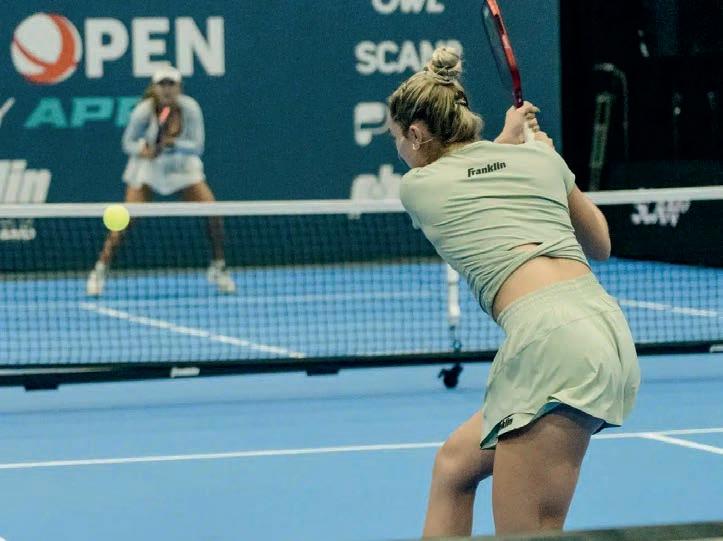
From family game to a sport attracting huge numbers, the future of pickleball looks bright
Instead, I witnessed a culture that was much closer to a “DIY” attitude. It seems that the development of pickleball has been reliant upon committed individuals that have progressed the game forward – building their own courts and facilities largely outside of the mainstream sports construction industry, while utilising existing facilities, such as badminton and tennis.
I couldn’t help but detect a wind of change, however. As the sport continues to grow and develop, the need for regularity and reliable performance will increase, as players look for consistency. Like with padel, the sport
will no doubt be influenced by countries further down the pickleball development journey. I note that there are already plans for high-end pickleball clubs, for example. Nevertheless, I walked away from the Telford International Centre in awe of people who had taken disused tennis courts and turned them into a place to play the game they love, as well as those who had painted their own courts without lines. It is individuals like that who have taken pickleball from a family game to a sport attracting the large numbers seen at Telford. With that culture of making it work, the future of pickleball seems very bright indeed.












schmitzfoam.com/pro


















e all know the power of PE to be the first building block in a lifelong love of sport. For many children, it’s the first experience they have of experiencing the joy of physical activity.
Over a third of girls only play sport in school – a far higher proportion than boys



WBut that’s not the case for everyone; because whilst school sport can inspire love for some, for others it can do the opposite. And at the moment, too many girls are falling into the latter category.





Yet school sport is also disproportionately
Yet school sport is also disproportionately important for girls. Over a third of girls only play sport in school, a far higher proportion than boys. Teenage girls are facing a mental health crisis that sport could be helping to ease.


and an Enrichment Framework

The good news is change is in the air. The UK Government has announced an overhaul of PE and school sport in England. Sitting alongside the Curriculum and Assessment Review, which will aim to ensure all pupils have access to a broad and balanced curriculum, including sport, a proposed new approach will include new School Sports Partnerships and an Enrichment Framework to ensure everyone has access to high quality sport. It has a particular focus on girls, as does the Curriculum Review.



Women in Sport welcomes this potential for major change, with its unapologetic focus on supporting girls to find their love of sport. It is, frankly, about time.


So what comes next? How can we make PE and school sport works better for girls? Whilst details on the new initiatives are scarce, there are some big principles that we believe should be at the heart of PE and school sport 2.0.









● More training and support for teachers
Teachers simply don’t get enough training in PE. All teachers who are involved in school sport should be specifically trained to recognise how stereotypes and biology interact in the PE setting and how to plan lessons that support girls and boys.


Better teaching about female puberty


Nearly three quarters (71%) of girls (even sporty girls) avoid sport when on their period. We want to see compulsory, well-structured teaching about puberty across the curriculum, including in PE.




● Single-sex opportunities
Early gender stereotyping means girls start school less skilled in key movement skills. Whilst mixed sex sport is important for building respect between boys and girls, it’s also vital that girls have some space and time of their own.
Uniforms matter

Schools should introduce active uniform policies to remove barriers to movement. For girls, dresses, skirts and shoes can hinder running and free play whilst some parts of PE kit can make them feel uncomfortable.


We have what could prove to be a generational opportunity to transform school sport for girls. Women in Sport are determined to make sure we take it.
















National Fitness Day, which took place on Wednesday 24 September, is the country’s biggest celebration of how physical activity helps our physical, mental and social wellbeing. Each year, thousands of events take place during the day in gyms, sports clubs, leisure centres, schools, workplaces and community centres, encouraging millions of people to enjoy movement, irrespective of their age, ability or background.
While it is just one day, the most powerful outcome is that it inspires change. It provides an opportunity to showcase the strength and diversity of the sports and physical activity sector, which is making improvements in public health that match many other services.
This year’s National Fitness Day coincided with the publication of the Mental Health in Motion report – a study on the role of physical activity in supporting mental health. The report, taken from ukactive’s quarterly consumer polling, identifies the value that those with mental health conditions place on being active and helping them to avoid sickness and time off from work.
Our data found that 85% of those living with mental health conditions say that the main reason for joining their gym, fitness or leisure facility was to improve their mental health and wellbeing. Furthermore, nearly three quarters (72%) of adults surveyed with a mental health condition say being physically active has helped them to stay well and be less likely to take time off work. However, just 16% of
85% of people with mental health conditions join gyms primarily to improve wellbeing
people with a mental health condition surveyed feel able to meet the recommended levels of physical activity (150 minutes a week).
We want this report to be a catalyst for change and for more urgent work between the Government and our industry on the issue of economic inactivity and long-term sickness, especially around mental health – a known priority for the Government. Gyms, pools and leisure centres remain the main drivers of physical activity across the nation, with a record 11.5 million people now members of a health and fitness club, so they can crucially help the Government on this issue.
The big opportunity here is for greater partnership between these facilities and the Government so the sector can help more people stay in work or return back to work. In fact, more than three in five people surveyed in our report (61%) say they would join a gym if it was offered as a benefit or at a discounted rate through their employer.
The Government has a real opportunity to build on its commitments in its 10-Year Health Plan and its Keep Britain Working review and work in partnership with our sector. Doing so will demonstrate that it is serious about supporting all British workers in improving their physical activity levels that can aid their physical and mental wellbeing and help them back to work.

Sustainability, padel and research will be among the topics covered at this year’s SAPCA Technical Conference in Nottingham
The 2025 SAPCA Technical Conference, one of the sports facility construction industry’s most popular events of the year, will take place at Nottingham’s East Midland’s Conference Centre (EMCC) on Thursday 27 November. The one-day event is open to anyone working in the sports and play sector and is again expected to attract a bumper crowd. The annual event brings the sports and play construction sector together, offering a platform to discuss the latest standards, research and trends across the industry. It offers opportunities to learn about innovations within the sector and discuss the latest developments.
In 2024, the event attracted a record number of 220+ delegates, who benefited from an educational programme featuring a wide range of topics, from
an inspiring keynote on future-ready mindset – delivered by a former Microsoft technology leader – to a detailed look at the latest standards in shock pads used in artificial sports pitches. Due to the continuing growth of the event, the 2024 edition moved to the EMCC for the first time. The modern, spacious venue proved a success and very popular among delegates, so it will play host this year too.
This year’s educational programme offers will feature a number of key topics for the sports and play sector. Among the highlights will be a detailed look at the ongoing work to develop organic alternatives to rubber crumb infill used in 3G pitch systems and a look at the latest standards in padel


court construction. There will also be a talk on how excellence in facilities breeds excellence on the pitch, outlining the importance of developing high-quality facilities for high performance sports and athletes.
Another hugely popular session, charting the latest in sports surfacing research, will also return and will again include a number of innovative research topics. Sustainability is among the threads that will feature heavily during the day, while SAPCA’s ongoing work on its Codes of Practice – the guides which provide the cornerstone for high-quality sports construction in the UK – will also be on the agenda.
The SAPCA Technical Conference not only provides a comprehensive programme of seminars and workshops. It is an invaluable platform for networking with professionals from across the sports and play industry, as well as with those working for national governing bodies, sports councils and research institutes. The conference will be followed by a well-attended, informal dinner, offering a great opportunity for delegates to meet over great food and drink.
“Since its launch in 2010, the SAPCA Technical Meeting has grown to become a crucial date on the industry calendar, providing an unparalleled programme of seminars and workshops on the most important technical topics of the day,” says Colin Corline, SAPCA’s Technical Lead.
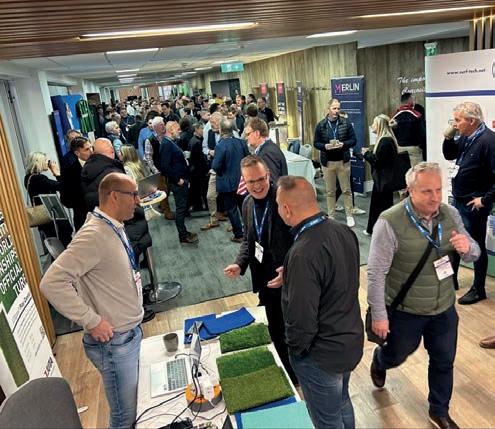
“Networking is also a big part of the event and it is always great to see colleagues from across the sports and play industry, representing national governing bodies of sport and other key sector organisations.”
The cost of attending the event are as follows:
DAY EVENT:
SAPCA members – £150 (plus VAT)
Non-SAPCA members – £300 (plus VAT)
DINNER:
Standard price – £60 (plus VAT)
HOTEL: B&B - £115 (plus VAT)
For more information on the Technical Meeting and to book your space, visit: https://sapca.org.uk/events/sapca-technical-confernce-2025/
The Sport and Recreation Alliance has published its 2025-30 strategy. SportsNation takes a closer look
The Sport and Recreation Alliance (SRA) has unveiled its fiveyear strategy, A United Voice for Sport and Recreation, setting out priorities for the sector from 2025 to 2030. Developed over an 18-month period of consultation, including a comprehensive Member Review and the On the Move roadshow series, the strategy reflects both the pressures and opportunities facing sport and recreation in the UK.
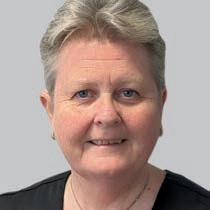
Lisa Wainwright MBE
Throughout this new strategy cycle, our unwavering focus will be to deliver with and for our members
For those working in sport — from national governing bodies (NGBs) to grassroots clubs — the strategy offers a clear signal of how the Alliance intends to support members, influence policy and strengthen the case for investment. At its heart are three core objectives: protecting sport and recreation with key decision makers, providing services and solutions that lighten the administrative load, and promoting the positive power of sport and recreation to create conditions for success.
The SRA’s strategic refresh comes at a critical moment. Rising facility costs, tightening public funding, and growing regulatory requirements are stretching organisations’ capacity. Local authority leisure provision has fallen sharply over the last decade, with more than 500 swimming pools being lost since 2010, while energy costs continue to put pressure on facility operators. Meanwhile, many voluntary-led clubs, in addition to financial difficulties, still struggle with governance compliance and safeguarding duties
that require professional-level expertise. Participation data underscores the urgency. While around 30 million adults in England (63%) take part in some form of sport or recreation each week (according to Sport England), inequalities persist. Disabled people remain twice as likely to be inactive as non-disabled people, and participation rates among lower socio-economic groups continue to lag. Addressing these disparities is central to both government health policy and the SRA’s own advocacy.
The strategy’s first objective positions SRA as a shield and advocate for members in policy arenas. Over the next five years, the SRA aims to strengthen relationships with government departments, regulators and funders, ensuring that sport and recreation’s collective voice is heard. That advocacy is expected to focus on several areas: sustainable funding, taxation, regulation, access to facilities and the integration of sport into health and education policy. At a time when the government is under pressure to reduce NHS waiting lists and improve population health, sport and recreation organisations have a strong case to be considered partners in preventative health. The SRA’s role will be to frame that case convincingly, backed by robust evidence.

The second pillar is about reducing the day-to-day burden on members. Many small and medium-sized

organisations operate with limited paid staff and rely heavily on volunteers. Administrative tasks, such as compliance, governance, safeguarding checks and financial reporting consume valuable capacity.
To address this, SRA plans to expand its support services. Members can expect new templates, toolkits and advisory resources covering governance, legal compliance, equality and diversity, and environmental sustainability. Networking and peer-learning opportunities will also be scaled up, recognising that shared solutions often save time and money.
By creating a stronger service offer, the SRA aims to allow organisations to focus on what they do best: delivering activity to participants. Importantly, this support will not be generic but shaped by ongoing consultation, ensuring that tools meet real-world needs.
The third objective is arguably the most outwardfacing. The SRA wants to champion the benefits of sport and recreation across health, community cohesion, economic development, and the environment. To do this, the Alliance is investing in data and research. Establishing robust baselines in 2025 will enable progress to be measured across the strategy cycle. This will include tracking participation, diversity, and facility access, as well as monitoring the impact of sport on wellbeing and local economies.
Evidence will underpin campaigns aimed at shifting public and political narratives. Whether highlighting the role of community sport in tackling loneliness, or demonstrating the carbon savings from active travel, the Alliance intends to build a portfolio of stories and statistics that policymakers cannot ignore.
The strategy emphasises accountability. Each core objective will be monitored against high-level measures, including both quantitative and qualitative indicators. Member satisfaction, uptake of support services, influence on policy decisions, and growth in participation among under-represented groups will form part of the evaluation framework.
While not all metrics are finalised, the commitment to data-driven assessment marks a step forward from previous strategies. It reflects the sector’s growing maturity in evidencing impact — a necessary evolution given the competition for public funds.
Lisa Wainwright, SRA CEO, said: “Throughout this new strategy cycle, our unwavering focus will be to deliver with and for our members – and in particular our national governing body members who play a foundational role in engaging and keeping people in sport and recreation.
“We are confident this strategy builds on our rich history but also demonstrates a willingness to change to remain modern and relevant.”

Geo Webb was appointed the CEO of Grounds Management Association (then called The Institute of Groundsmanship) in November 2005. As he reaches the 20-year milestone in the role, he sat down with SportsNation to share his views on how the groundscare and sports turf sector has changed – and what lies ahead for it
As CEO of GMA, you’ve had a unique vantage point on the sector. How has the groundscare and sports turf sector changed and developed in the past two decades?
The sector has undergone significant changes since 2005, driven by greater exposure of sport through TV and streaming channels, awareness through the rise of social media, technological advancements, increased focus on sustainability and the challenges of climate change. These factors have led to improved playing surfaces, more efficient maintenance practices and a greater emphasis on environmental responsibility. Grounds management has proven itself to be versatile, adaptable and resilient to all these changes.
How has GMA changed, if you compare the current organisation to the IOG (as it was then) you joined 20 years ago? It has evolved significantly, focusing on professionalising the sector, enhancing pitch quality and attracting new talent. There have been some major developments, such as the creation of the Grounds Management Framework, the Pitch Advisory Service, increased investment in digital resources and initiatives like #GroundsWeek, Schools into Stadia, GMA NextGen and the GMA awards. All of which have helped to raise the profile of the profession that makes sport possible.
We have spent years moving the dial on the understanding of the profession within governing bodies of sport
For those who might be unfamiliar with the organisation, what is GMA and what does it do (in your own words)?
In short, the GMA is a not-for-profit association that champions both professional and volunteer ground staff and the businesses that support them to make sport possible. We have a range of products and services designed to elevate career development which includes a range of training and education courses, turf care advice and guidance, events and trade exhibitions for our membership and beyond. We have spent years moving the dial of understanding of the profession within governing bodies of sport and professional leagues when it comes to the management of sports turf.
What are the main areas of work for the GMA at the moment?
We have been investing in our workforce, as well as looking to the future with the integration of new Board members - all of whom are invested and working together to enhance our membership offer, how we represent our membership to employers and stakeholders and raise the sector’s profile
The Grounds Management Framework is at the heart of a lot of your work. What it is and what does it do? In essence, the GMF provides a clear pathway

for individuals and organisations to improve the quality of their sports surfaces by guiding them through a structured process of self-assessment, skill development and resource management.
The GMF has five distinct levels: basic, good, advanced, high and elite. Each level corresponds to a specific standard of playing surface and the associated expertise and resources needed to maintain it.
It is adaptable through sport and was brought about to simplify understanding of ‘how to maintain a surface’ for practitioners and nonpractitioners, from professionals to volunteers.
What is the Pitch Advisory Service (PAS) and how can grassroots clubs/ organisations utilise and benefit from it?
It is a key part of our service to help improve the quality of sports pitches, particularly at the grassroots level. The Pitch Advisory Service (PAS) offers expert advice and support to clubs, local authorities and other organisations involved in maintaining sports surfaces. Through our network of Regional Pitch Advisors, the service aims to raise the standards of sports surfaces and enhance understanding of sports turf management practices. We do this with our working relationship with the sports bodies, in-line with a co-ordinated plan of action which is led by their individual and collective strategic facilities plans.

The role of sports turf managers has evolved to fit the modern-day sports environment
How does the GMA’s work supporting grassroots differ from the work it does with elite and professional organisations and individuals?
Our focus with the volunteer network is to encourage best practice by taking up our online courses which, rather like coaching qualifications, enable progressive steps to learning and development. The common factor between professionals and volunteers is developing knowledge, skills and behaviours. For professionals there are clear pressures, and we lobby and advocate as well as research what these drivers are.
For example, historically the profession has been a low paid profession and, with the development of things like the Grounds Management Framework, we can start to address the disparities that exist. Training is in our DNA and, as sport has evolved, so has our profession - and we are working hard to elevate careers and move away from the ‘accidental manager’ of the past to a well-rounded set of skills that have greater emphasis on management in general. This will enable the grounds teams to be heard, backed and supported in the workplace by their employers.
Training is a big part of what GMA does.
How can those working or volunteering at community clubs and organisations benefit?
We actually have a portfolio of 53 courses; these range from entry level online courses for volunteers to foundation degree level courses. We are proud to have matrix Standard accreditation (owned by the Department for Education). In fact, we are the
only industry association to be accredited. We’re invested in an annual continuous improvement check to ensure we can improve our customer journey.
It also helps our staff improve their soft skills. As we are industry specific, we tend to use a lot of technical languages which can exclude those who are not used to it.
To widen the appeal, we have included more of an inclusive tone, allowing our messages to have a wider reach. Engaging in these courses will help both volunteers and professionals to enhance their skills, knowledge and behaviours which ultimately will improve the surfaces for players.

At grassroots level, the key differential is having less cancellations and more income generated as a result.
What do you see as the biggest challenges and threats the sector faces?
There are ongoing threats to our profession – the ageing workforce, lack of adequate budgets and the lack of new entrants is a constant threat. The fact is: we have an ageing population, and we compete as a niche sector for a decreasing pool of 16-year-old talent, so incorporating this into critical thinking means widening the scope and influence of how we promote the sports turf sector in general as an option for school leavers. We can also promote a ‘healthy lifestyle’ approach to volunteering, especially the 50 plus age demographic. Too often, sport forgets to make the link with the fact that helping turn a pitch around is as valuable as being the coach or the referee, so we need to work on that.
There is a need to inspire the next generation of grounds management professionals
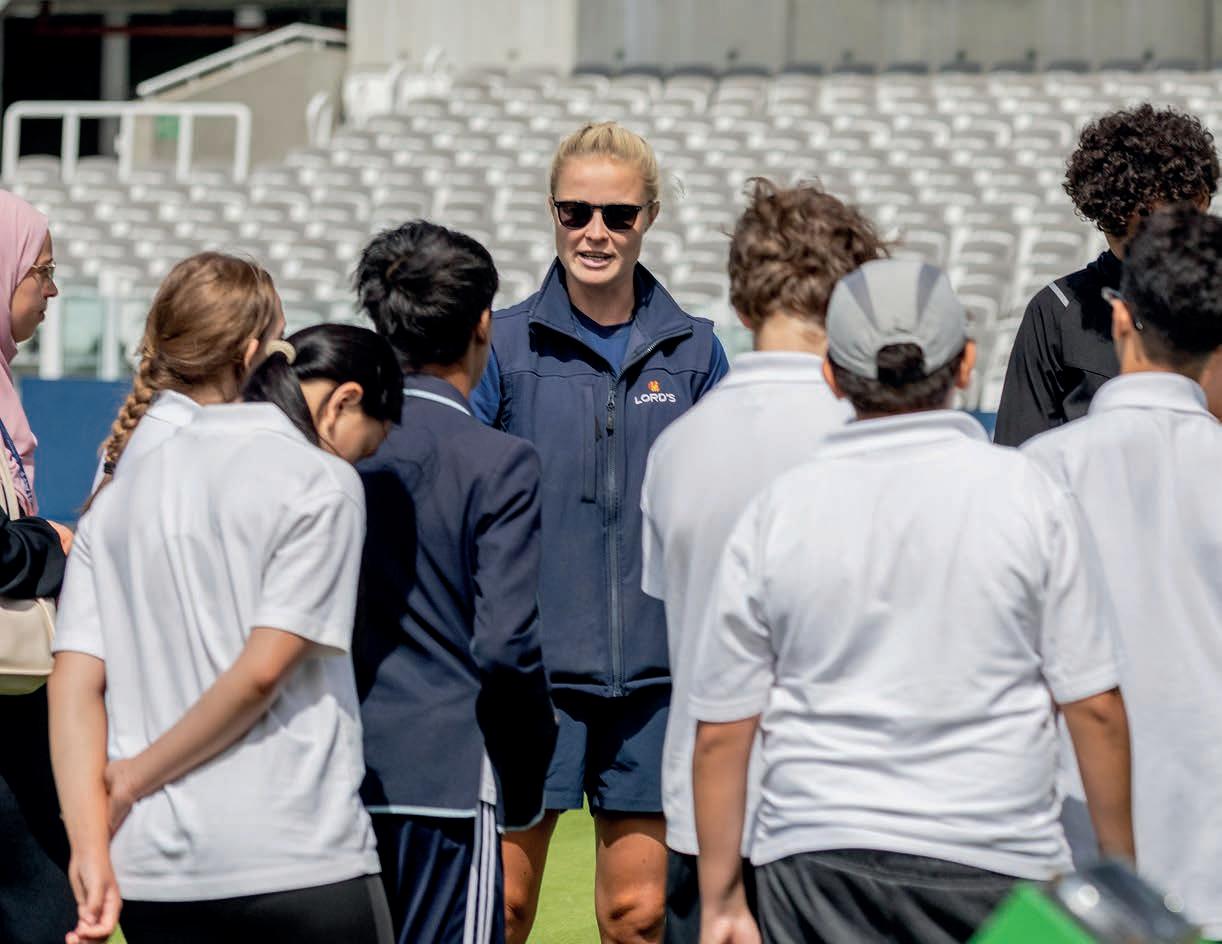
For professionals, as I have said already, it’s recognising the evolution of the role of the sports turf manager in the modern-day sports environment. Employers cannot keep getting away with underresourcing this vital area of responsibility within a sports facility. Whether that’s budgets for capital equipment and supplies or investing in staff and staff development. Hours worked, and pay, are all factors in creating good or poor working conditions.
There is lots of room for improvement, and it’s how we encourage and support wider understanding of the role with all employers and key stakeholders to improve opportunities and working conditions for our sector. We also have to accept that to be heard and recognised we have to build standards and maintain a professional approach as well.
We also have to face into the new digital age the advancement of AI and how that will shape the role of the future turf manager. We have seen the advancement of robotic technology and with good results, but facing away from these advancements won’t serve anyone’s interests
Training is in our DNA and, as sport has evolved, so has our profession
Climate change is increasingly having an impact on sports facilities. Have you witnessed that impact within your membership?
Yes, definitely. Overall, like every sector, how we approach the environmental challenges we face will be very interesting. We are already into sustainability management and especially prevalent will be water use over the next decade. We have been working with others through adopting ‘The Leisure Association Water Charter’. We have committed to providing information and education to our members/stakeholders, highlighting the urgent need to move towards sustainable water sources for irrigation to safeguard the future of our industry - amongst a range of pledges, as an example. So yes, climate change and its impacts will definitely shape thinking of our sector in the future. Linked to this are new variants of turf disease that we are seeing in the UK. We have to, though, move from symptom management to cure. This is another challenge for us as we use treatments to manage through a challenging surface – however, like humans, the grass plant is a living organism and
We have some excellent people who are changing the face of the old cloth cap view of what is now a progressive and exciting role in sport
how we approach treatment of a new virus or variant rather like we face as humans with COVID means we must invest in science and research so that our agronomists have a fighting chance of coming up with solutions to overcome such challenges. Whilst we have relied on chemical solutions for decades, with more restrictions in place, we are going to have to be agile in attitude and outlook to problem solving.
What will GMA’s priorities be over the next 12 months?
We have a real mix of projects on the go, ranging from our annual sector show SALTEX in November to a wider mix of engagement opportunities like the recent pilot series of GMA Connect which is designed to engage groundspeople, organisations and suppliers at a more regional level. We have our annual GMA Industry Awards next year in March at Edgbaston Cricket Club, shortly followed by the return of #GroundsWeek, our week-long awareness campaign. Our GMA NextGen group are keen to roll out further Schools into Stadia events which allow students full behind-the-scenes access to the life of a groundsperson, most recently held at Lord’s.
Our most-recent campaign was the brand new 35 under 35. Again, following the celebratory theme, it’s designed to shine a spotlight on those under the age of 35 in the grounds management industry.
We’re reviewing our approach to policy and research to ensure we have the key data and statistics to take to those we need to reach out to and influence. So, in short, a real mix of activities hence the need to invest in our own workforce and succession plan.
But supporting all of this is our membership proposition. We’ve worked incredibly hard over the past few years to revise our membership offering, and we’re
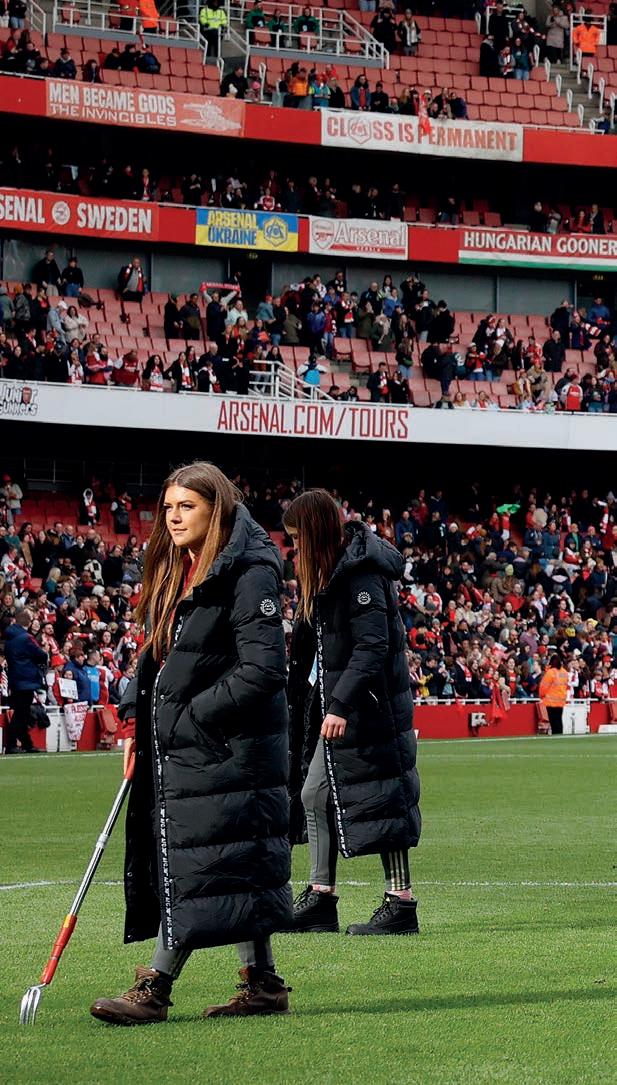
now starting to see the fruits of our labour through an increased, and more engaged membership base. Looking to the future, we want to open our sector up in terms of a representative workforce. For example, there’s a team of 15 all-female grounds staff at the Women’s Rugby World Cup final and bronze final, who will take on the preparation of the pitch at Twickenham. This follows on from similar events in cricket at The Ashes, and in football we had an all-female team work on the WSL match between Arsenal and Tottenham. These help to clearly identify that, although we are a male dominated profession, it is a profession for all regardless of age, gender or background. We have some excellent people who are changing the face of the old cloth cap view of what is now a progressive and exciting role in sport on a par with any other role.
Arsenal’s derby game with Spurs in March 2025 made history as the first WSL fixture to have an all-female grounds team
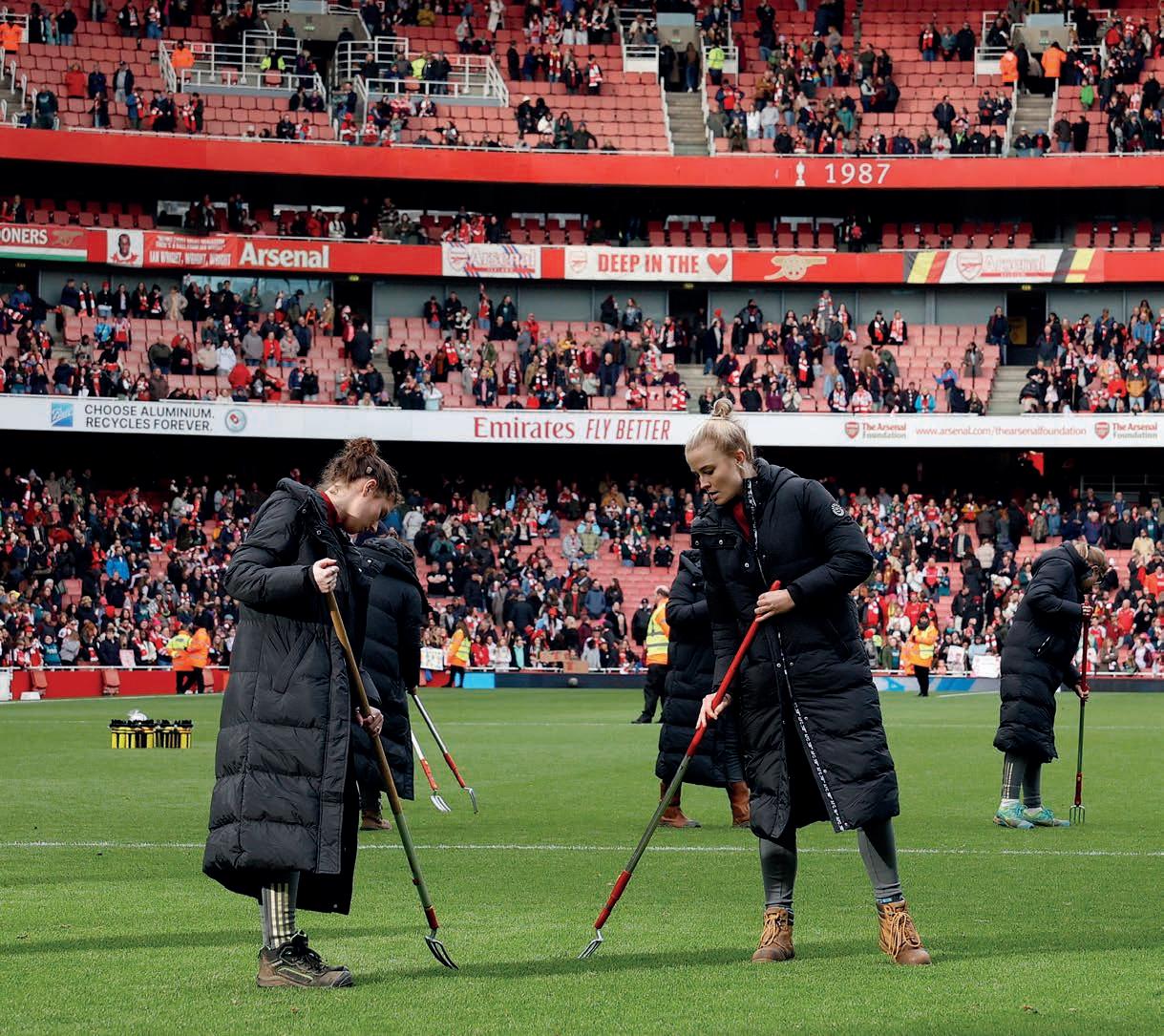
Geoff Webb – In his own words
Iwas always interested in sports but, growing up in the 1960s and 70s, a career in sport was not really seen as a profession. I always knew, however, that I’d somehow pursue a way to secure a role in sport.
After leaving school at 16 with few qualifications, I worked in insurance within accounts for seven years, while also gaining a tennis coaching qualification. I spent five summers coaching in the USA and, returning to education in between, I completed A-levels and earned a BSC degree in Recreation Management at Sheffield Hallam University, funded by the tennis coaching.
Following my graduation, I managed a health club and, having also completed a placement at the LTA during my degree, secured a full-time role in their facilities team during the 1990s (as part
of the LTA’s Indoor Tennis initiative). Together, we developed 53 public tennis centres across the UK.
I then became Head of Major Projects at the LTA, before joining the Football Foundation as Director of Facility & Stadia Development, establishing and setting the multimillion capital grant programme. In 2005, I became CEO of the Institute of Groundsmanship (IOG), where I’ve led the organisation’s growth into what is now the Grounds Management Association (GMA).
My early years developed a range of soft skills that enabled me to progress a career without necessarily the formal training which I have subsequently had and developed. What I still like to do is develop others and this stems all the way back to starting out coaching tennis and latterly football as a volunteer.

A council has used a popular grassroots running event as a platform to deliver its physical activity strategy at scale
The hugely popular Durham City Run Festival was launched by Olympic silver medallist and World Champion, Steve Cram CBE, in 2016. Attracting thousands of runners and spectators, the four-day festival comprises a 5K and 10K race, as well as Paula Radcliffe’s Families on Track, where families complete a 10K distance together in a continuous relay.
Durham County Council has supported the event since its launch but, this year (2025), the council took its support to the next level. With its leisure brand, thrive, as headline sponsor, the council

harnessed the excitement of the festival to develop a community-wide campaign, Together We Move. The campaign focused on movement and wellbeing, resulting in almost 10,000 residents engaging in physical activity over three months. It also supported the wider physical activity partnership strategy, Moving Together in County Durham, which launched in 2023 to embed movement into everyday life and tackle health inequalities across the county.
“All movement contributes to a healthier life, whether that’s cycling to the shops, walking to school, doing some gardening or playing in the park,” says Deborah Holmes, the council’s Strategic Manager for wellbeing, sport and leisure.

It’s so good to see families enjoying being active together


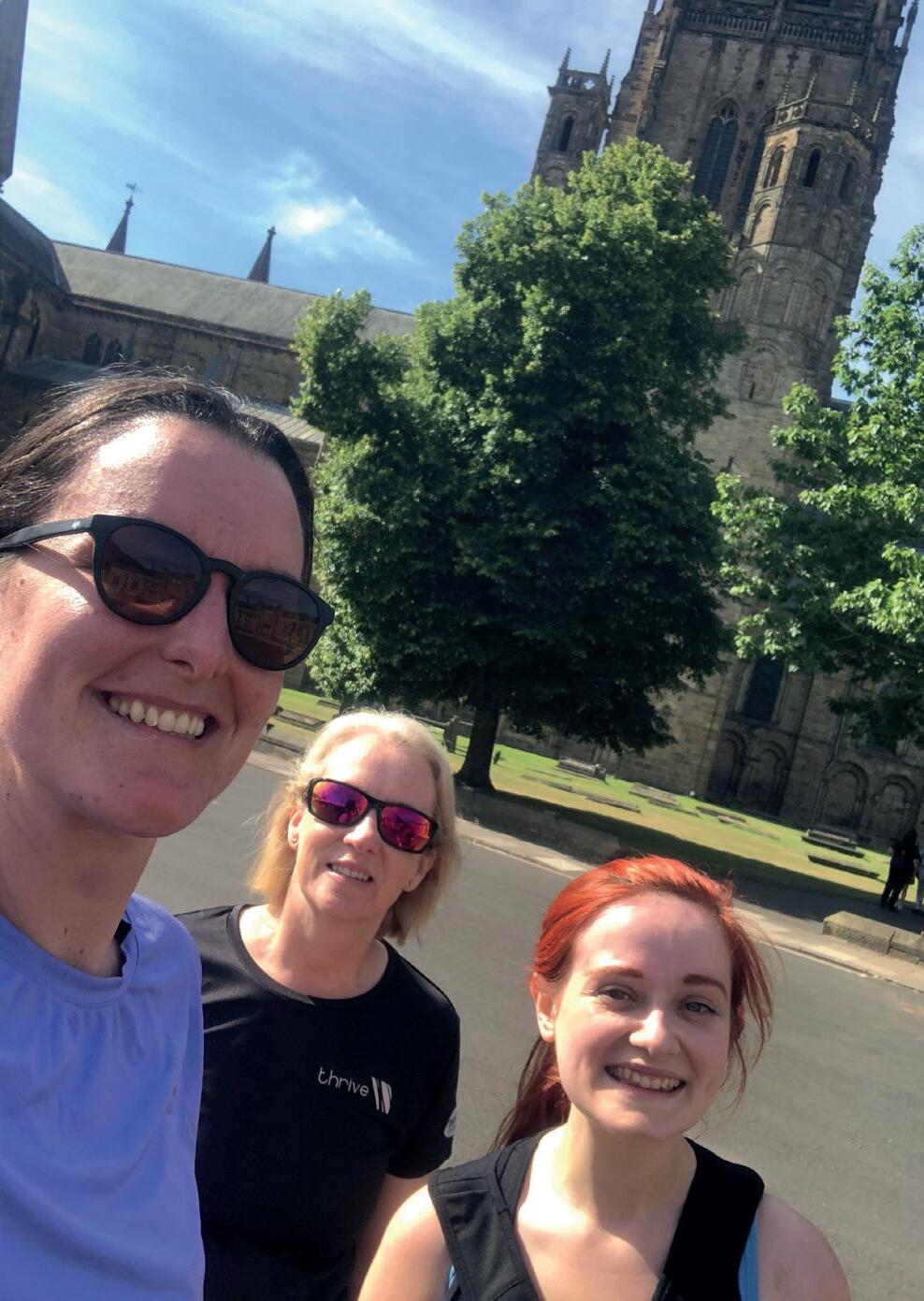
“We used the Durham City Run Festival to promote movement at all levels by creating a series of activities leading up to the event.”
Running from May to July, Together We Move delivered an extensive programme of inclusive activities and events designed to support everyday movement across a variety of settings.
The campaign’s digital fitness challenge, run through the Technogym app, encouraged residents to track all kinds of movement, from gym workouts to climbing stairs.
Promoted through Facebook and the council’s thrive leisure app, the challenge attracted 320 participants and logged an impressive 12.5 million moves, the council’s highest ever engagement for a digital campaign. Prizes included gym memberships, Technogym equipment and free Durham City Run places.
“We’re really pleased with the level of engagement we attracted during this digital fitness challenge,” Holmes says. “It shows the strength of our community and is a great example of how technology can help make activity accessible and inclusive. We aim to launch more challenges in the future.”

To create pathways into the festival’s 5K event, the council delivered 14 Couch to 5K programmes across the county, engaging 160 people. The 10-week programmes were led by qualified run leaders and hosted at community venues. WhatsApp groups provided peer support, accountability and motivation between sessions.
The council also ran four Start Me Up events. These free and friendly sessions helped new and returning runners become familiar with the Durham City Run course, allowing them to build confidence and reduce any anxiety about taking part ahead of the race events. Jess, one of the participants – who was also recovering from surgery – said: “The Start Me Up runs were a great way to get back into
running following a few months out. Seeing and experiencing a new route with the idea of completing the full 5K drove me to attend. I will definitely be joining more events in the future.”
At the same time, more than 70 families took part in Paula Radcliffe’s Families on Track, the popular family relay event launched by the long-distance running legend. 2025 marked the year that the event returned to Durham, the city where the concept made its original debut.
“Having fun is a core objective of Families on Track,” Radcliffe says. “It’s so good to see families enjoying being active together, especially in such a beautiful setting. I’ll always have a soft spot for Durham and I love coming back up here with my own family to be part of the festival.”
May’s National Walking Month saw 455 people join 52 weekly wellbeing walks
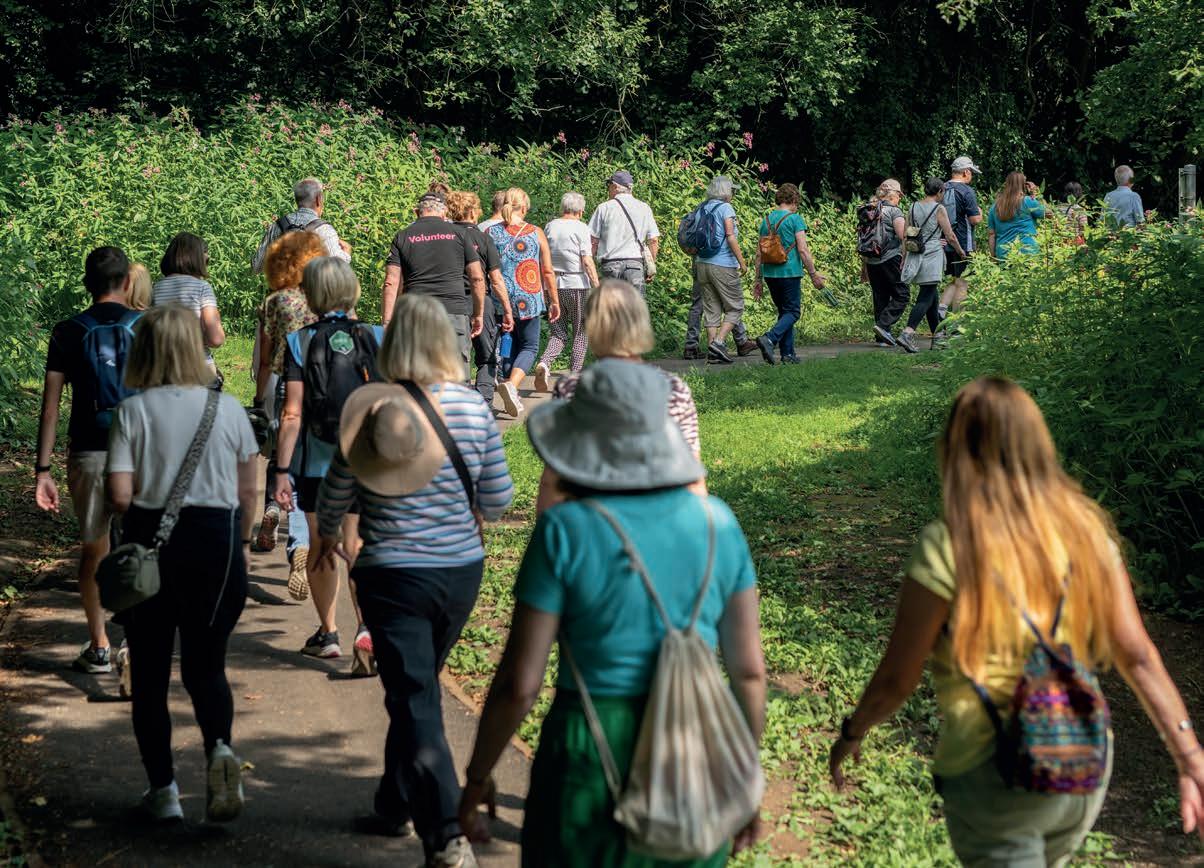
Following the Families on Track event, the council welcomed Fireride Local, a pop-up cycling event that gave children and adults the chance to test their skills on a purpose-built track, try out different bikes, and enjoy cycling in a safe, friendly environment. The event also featured professional riders performing spectacular stunt demonstrations.
Driving participation beyond fitness spaces
Together We Move reached beyond traditional leisure settings and tapped into other initiatives to encourage residents to move more. During national Walk to School Week, the council’s wellbeing team and travel planning unit worked with schools to encourage participation.
Supported by information packs and incentivised through a prize draw offering £250 vouchers for school sports equipment, around 5,200 children from 22 schools got involved in the initiative.
May’s National Walking Month saw 455 people join 52 weekly wellbeing walks, while July’s Together We Move Big Walk brought around 80 participants together for a 90-minute walk through parkland near Lumley Castle. A Gentle Steps version offered a shorter, more accessible option, followed by a community picnic to encourage connection and social wellbeing.
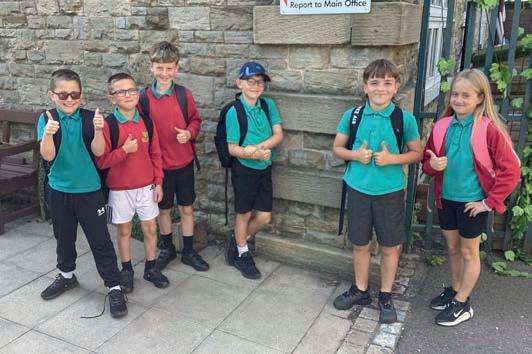
The council’s wellbeing team and travel planning unit worked with schools to encourage participation
5,200 children from 22 schools got involved in the initiative

The council also encouraged workplace activity. As part of its Better Health at Work programme, it staged its first seven-a-side football tournament for council staff during festival week. Hosted at Meadowfield Leisure Centre, the mixed-ability competition drew 20 teams and 200 employees across departments, from traffic management to licensing.
The tournament brought staff together in a new way, said community wellbeing coordinator Dean Tinkler, who organised the event.
Tinkler said: “I didn’t expect the tournament to be as popular as it was - teams were still enquiring after the deadline. It was great to see staff come from different departments and have fun competing for the trophy. We’ll be looking to do it again next year with more time and planning to make it bigger and better.”
During Volunteers’ Week, the council recognised and celebrated those who give up their time to support the delivery of its physical activity programmes and services. Events were held across parks, libraries, museums and community spaces to thank walk leaders, run leaders and leisure volunteers for their dedication.
Volunteer walk leader, Jane Whitall, said: “Wellbeing walks are important, especially for getting people out and moving. Some people may

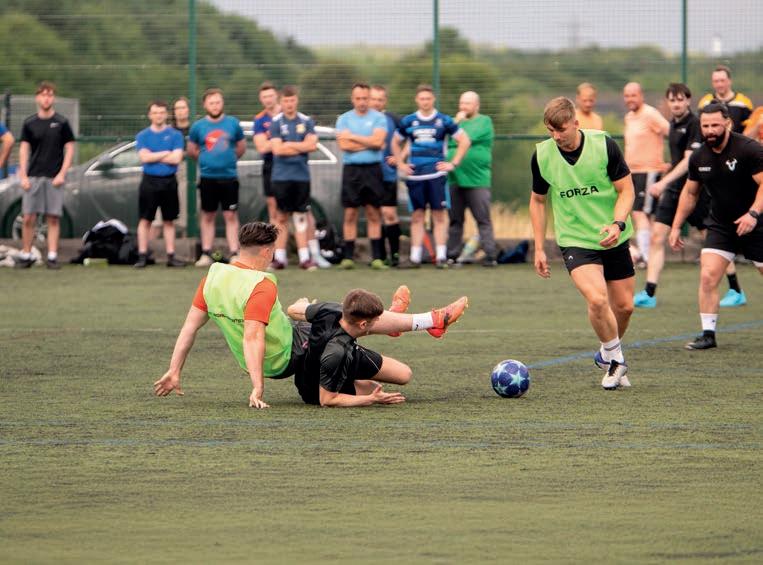
not see anyone from one week to the next. The thank you walk at Derwent Manor was amazing. It was lovely to meet other volunteers, discuss our different walks and get to know each other. It gave me a real sense of appreciation from the council and an understanding of just how many people give up their free time to do these things.”
By aligning Together We Move with the Durham City Run Festival, Durham County Council has shown how local authorities can harness the excitement and enthusiasm of popular community events to deliver their health and wellbeing goals. Rather than simply sponsoring the festival, the council used it as a springboard for inclusive, county-wide participation, reaching new audiences and helping to create sustainable behaviour change in the process.
“This was so much more than a race,” says Holmes. “It was about making movement feel relevant, fun and accessible, for all residents wherever they are in their fitness journey.”
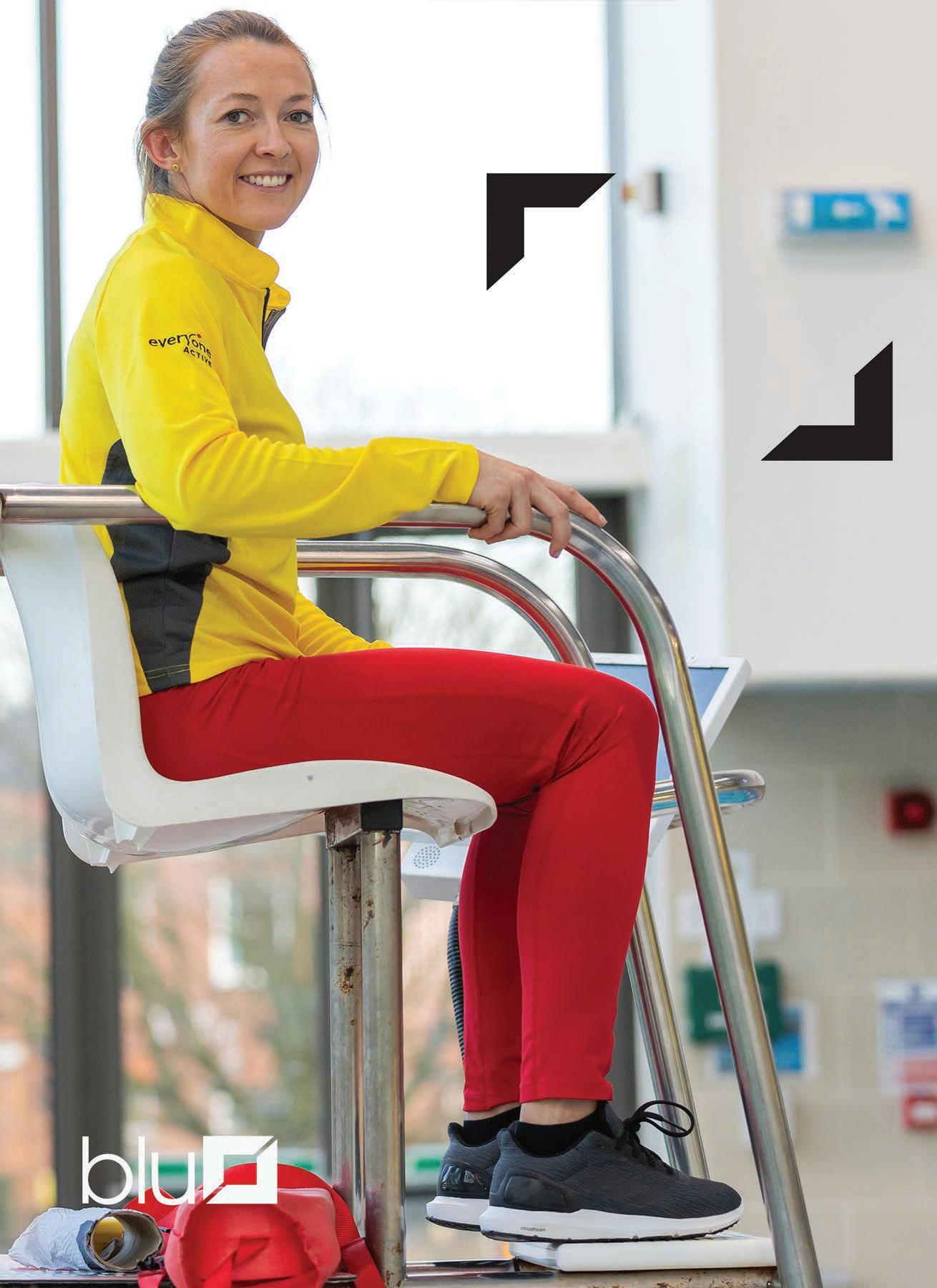


Comprehensive new analysis by Activity Alliance has revealed regional and demographic disparities in disabled people’s experiences with sports and physical activity across England
Only half (51%) of disabled people across the country feel they have the opportunity to be active.
Yet, there is clear demand for opportunities, with 80% of disabled respondents expressing a wish to be more active. There are also significant regional differences to disabled people’s experiences of physical activity, while the type of disability and other demographic factors also play a big part. The insights come from disability sports charity, Activity Alliance, which published the latest findings from its Annual Disability and
Activity Survey in August 2025. Drawing from five years of data, the survey’s Secondary Analysis provides vital insights into the barriers disabled people face when it comes to being active.
The latest data and insights from the survey explores the regional differences in disabled people’s lived experiences of being physically active, as well as the demographic influences on sport and physical activity. A total of 10,411 people were surveyed between 2019 and 2024 for the report, including 5,113 disabled and 5,298 non-disabled respondents.
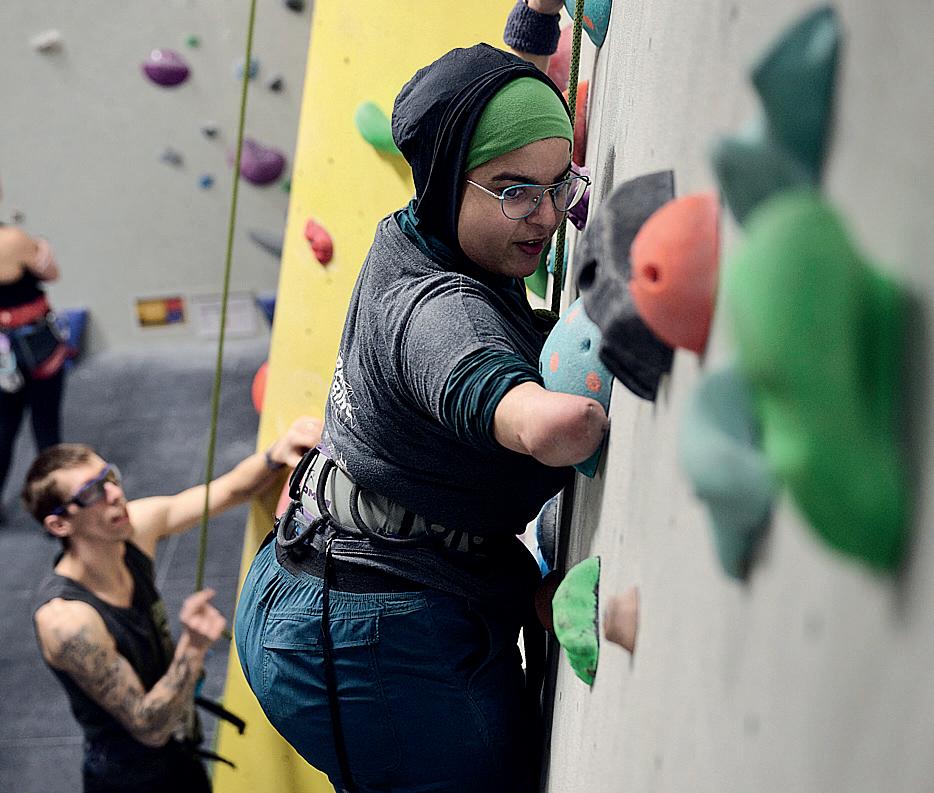
Each year, the survey is completed by different participants from Sport England’s Active Lives Survey and a pooled representative sample from research agency IFF, providing a comparable dataset rather than tracking the same individuals over time. The data was then analysed and compiled in two separate reports – a Demographic Report and Regional Report. Values are reported as percentage points (pp). This means the difference between two percentages e.g. a value of 20% compared to 5% is a difference of 15 percentage points.
For the report, Activity Alliance worked with Rose Fawcett, a data analyst, to explore what demographic factors – such as ethnicity, socioeconomic status and impairment – are most associated with positive or negative experiences in sports and activities among disabled and non-disabled people. Another aspect analysed was to see which demographic factors are most

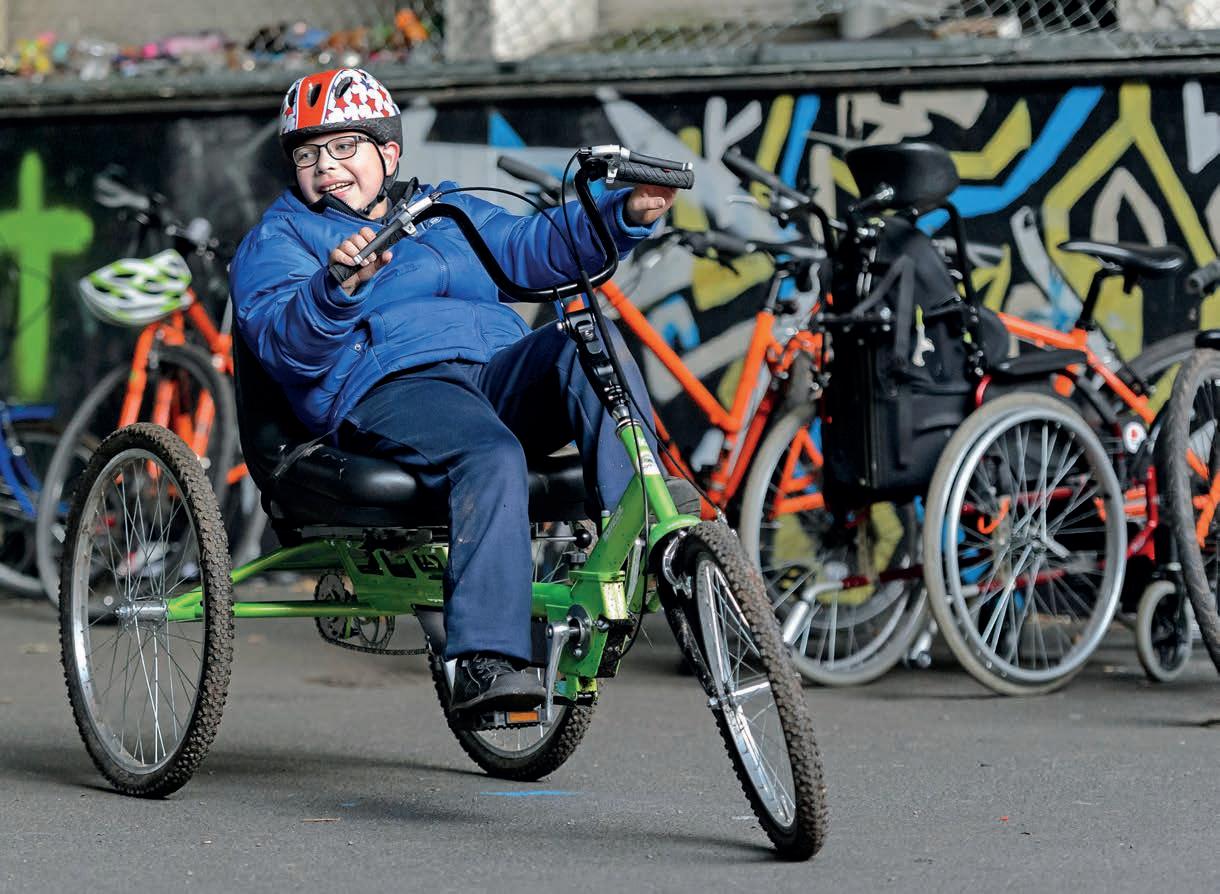
associated with disabled people’s perceptions of representation in participation, employment and volunteering in sport and physical activity.
Among the key findings is that impairment type influences disabled people’s opportunity to be active. For an example, disabled people with mental health problems are 13.6pp less likely to have the opportunity to be active, when compared to other disabled people without a mental health problem. Similarly, disabled people with long-term pain or a mobility impairment are 9pp and 8.6pp less likely to have the opportunity to be active compared to other disabled people. Those with breathing or stamina impairments, or a dexterity impairment, are only 4.3pp and 3.1pp less likely to have the opportunity to be active than other disabled people without these impairments, respectively.
Age is another factor associated with people’s opportunity to be active. Disabled and non-disabled adults aged 65+ are 8.2pp and 12.7pp more likely to have the opportunity to be active than disabled and non-disabled people aged 35-64 respectively. At the same time, disabled people aged 16-34 are 6.8pp more likely to have the opportunity to be active than other disabled people aged 35-64.
Impairment type also influences disabled people’s desires to do more activity. While those with a
Only half of disabled people feel they have the opportunity to be active – yet 80% want to do more
mental health problem are 9.8pp more likely to say they would like to do more activity – compared to disabled people without a mental health problem –those with a social or behavioural impairment and a visual impairment are 5.5pp and 5.6pp less likely to say they would like to do more physical activity.
“For disabled people, factors most attributed with having negative experiences in sport and physical activity are having a mental health problem, being female, or having a mobility impairment,” the report states. “In contrast, factors most

Activity Alliance intends to use the insight from the reports to support its work
attributed with having positive experiences in sport and physical activity are younger disabled people aged between 16-34, older disabled people aged 65+ or having a speech impairment.
“Social grade is another factor which impacts disabled people’s perception of participating in sport and activity. Disabled people in a lower social grade are 6.7pp less likely to see themselves participating in sport and activity, whereas disabled people in higher social grades are 9.1pp more likely to see themselves participating in activity compared to disabled people in medium social grades.
“Meanwhile, ethnically diverse disabled people are 9.4pp more likely to see themselves participating in sport and activity compared with white disabled people.”
The report found no regional differences in opportunities to be physically active – half (51%) of disabled people across all regions feel they have the opportunity to be as active as they want.
However, disabled people in Scotland, the East Midlands and Yorkshire and Humber are more likely to enjoy physical activity, while those in the West Midlands are less likely to say they enjoy being active.
There were also regional variations in the way people looked for advice and information
on physical activity. For example, disabled people in the West Midlands are less likely to go to healthcare professionals for advice on being active than any other region. The data also shows that disabled people in the North East (42%) and Scotland (43%) are more likely to look for information at sports, leisure and community organisations, while those in Northern Ireland (31%), East of England (33%), West Midlands (34%) and London (35%) are less likely to use these sources.
Activity Alliance intends to use the insight from the reports to support its work to ensure that sports and activities meet disabled people’s needs in all regions across the UK. It also hopes for the recommendations to extend to the wider sport and activity sector.
The three recommendations are to:
● Use the insight to explore the local barriers and opportunities
● Further develop intersectional insight and learning
● Equip health and social care workers and ensure online activity information is relevant.
For a more detailed look at the recommendations, see page opposite...
The three recommendations to bring down barriers and to help disabled people get more physically active
Use the report’s insight and learning across regions and place
Activity Alliance will use the insight in its work at a regional level, working with partners to advocate for disabled people and address barriers to being active. Partners and organisations in different regions should also use the insight to explore the local barriers and opportunities that may influence disabled people’s experiences of enjoyment and want to be more active in their respective areas. Organisations should work with Activity Alliance and together across regions to share best practices and develop insight that underpins disabled people’s experiences at a local level.

Develop intersectional insight and learning
Activity Alliance will share findings with its partners to continue to address gaps in the knowledge base. It will also work across regions to listen to the needs of disabled people and organisations to ensure that the insight it gathers adds value to the sector, resonates with disabled people’s experiences and creates lasting impact in their local areas. Organisations in all regions should work with other committed partners across the sport and activity sector to adopt the insights to address inequalities. Where possible, partners should collaborate with Activity
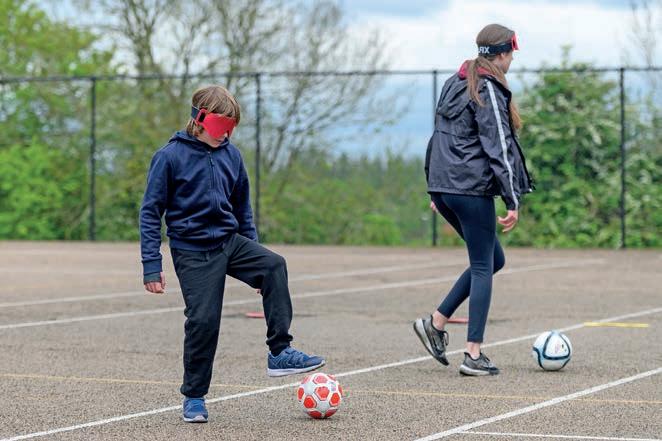
Alliance to further explore disabled people’s experiences in sport and activity in their local areas, with a clear focus on demographic factors that highlight stark inequalities.
Equip health and social care workers and ensure online activity information is relevant
Health and social care professionals are the most likely source of advice for disabled people looking for information on being active. Activity Alliance will share learning across regions of work that has effectively supported disabled people to access sport and activity opportunities.
Health and social care workers need to be equipped with better processes to support disabled people to use physical activity in ways which work best for them. Partners and other organisations, especially across the health and social care sector, must recognise the importance of their professions in being preferred sources of advice about physical activity for disabled people across regions and ensure they have the skills, resources and confidence to effectively promote sport and activity. Information about how and where to be active, especially online, must be relevant and kept up to date so disabled people know where to access local opportunities.
SportsNation reports from a special, one-day conference that charted the future of sports facilities in Northern Ireland

SAPCA and Sport Northern Ireland partnered to host a one-day conference at Galgorm Spa & Golf Resort in September. The event – titled Promoting Excellence in Sports Facilities –attracted more than 120 delegates and provided an opportunity for sports facility stakeholders to engage and discuss the issues around the provision of fit-for-purpose sports facilities in Northern Ireland.
The conference programme featured a number of topics and key speakers, ranging from the sports facility funding, testing, recycling and construction sectors.
Chris Barry, Football Foundation’s Head of Technical, gave an insightful talk on the foundation’s test site in Sheffield, where pitch systems of the future – utilising alternatives to rubber crumb infill – are being studied. Having opened in November 2023, at a project cost of around £3m, the test hub features seven pitches with seven different
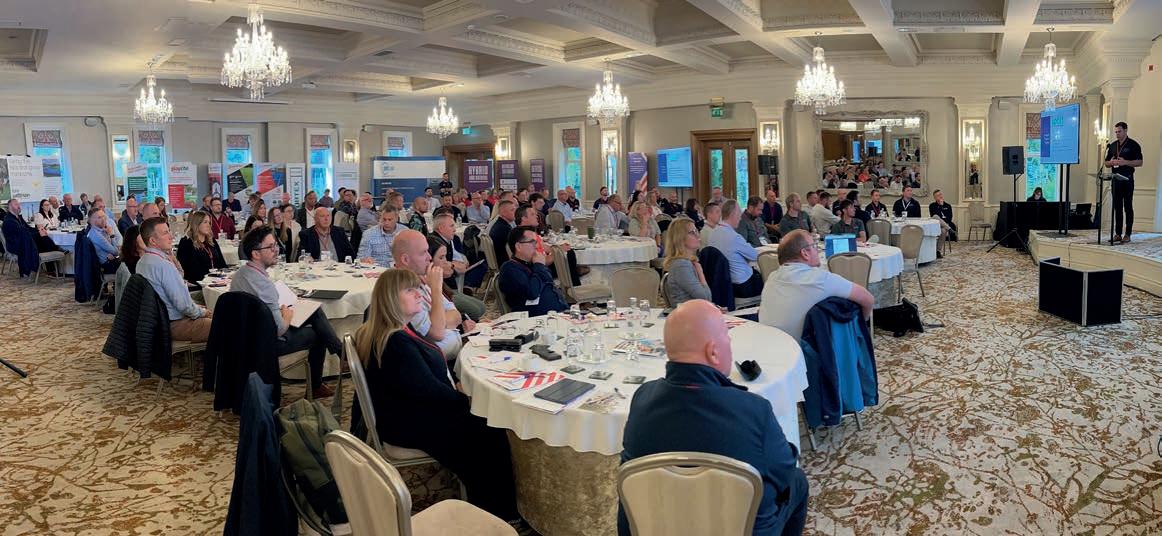
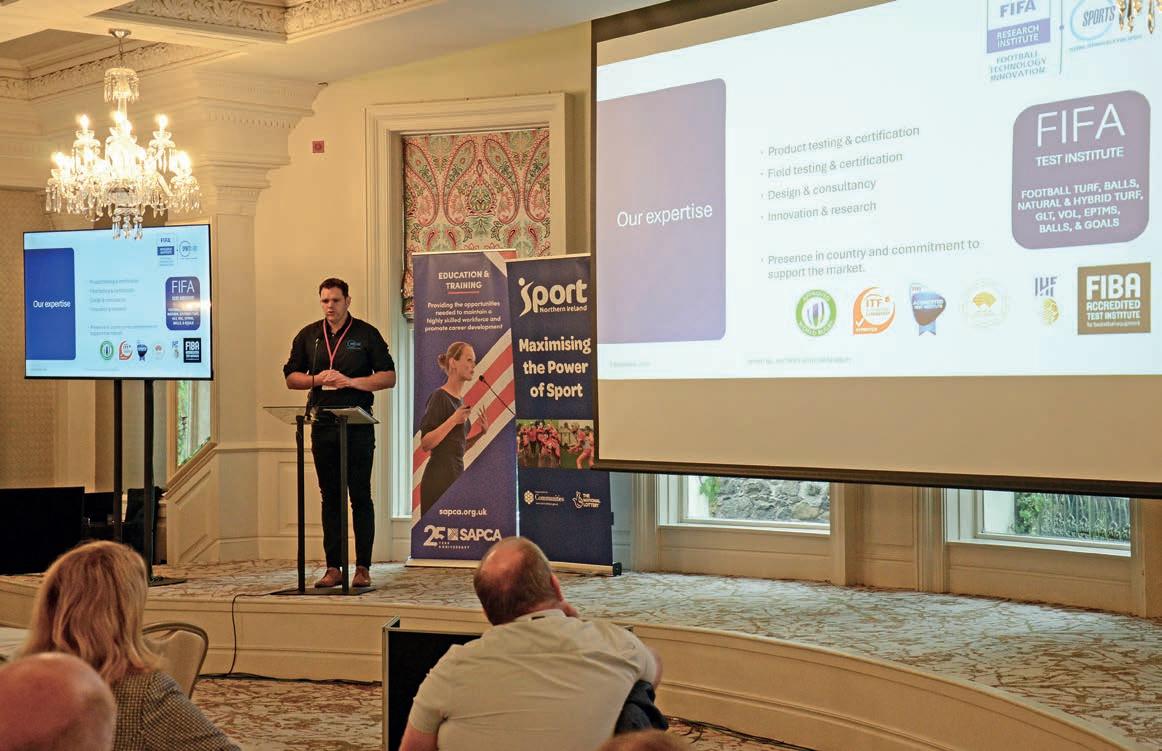
At She eld’s £3m test hub, seven new pitch systems are being trialled with alternative infills such as corn, olive, cork and wood systems. The systems being tested feature alternative infills such as corn, olive, cork and wood.
The three-year research programme looks to evaluate player experience and evaluate durability and longevity of the new systems, as well as determine their economic viability and assess their environmental footprints. Barry told delegates how the next stage of the process will see two full-size pitches being built, using pitch systems which have been deemed most suitable to be tested in an 11-a-side format.
Niall MacPhee, Director at Sports Labs, then presented some of the data that the company had compiled on Northern Ireland’s 3G pitch facility stock. According to Sports Labs, there are a total of 72 3G pitches in the region and the average age of a pitch is currently 6,5 years.

The projected investment to upgrade the full, current stock of 241 pitches, is around £41m.
Luke McGeechan, Group Commercial Director of Sportex Group, then offered his views on the advances made – as well as challenges faced – in recycling synthetic turf. Delegates learnt how Sportex has become the first (and so far, only) UK company offering a full 360-degree service,

Two thirds of girls felt there was nothing for them to do in parks, while 59% felt unwelcome as spaces were dominated by boys
from providing a playing surface and maintaining it to, ultimately, replacing and recycling it. He also explained how recycling processes are being developed further, including coming up with solutions to deal with new types of pitch systems.
McGeechan also outlined the challenges faced by the industry when recycling synthetic pitches. These include the variability of end-of-life turf materials, the degradation and contamination from usage and poor maintenance practices, as well as the somewhat limited knowledge of recycling technologies in a developing market.
There was also a thought-provoking session on making facilities more inclusive, featuring two speakers – Kevin O’Neill, CEO of Disability Sport NI and consultant Susannah Walker from In Her Place.
Walker argued that much of the facility provision is currently designed and provided for sports and predominantly caters for men and boys. She then provided data that showed how two thirds (68%) of girls felt there was nothing for them to do in parks, while more than half (59%) felt unwelcome because the spaces were dominated by boys.
Walker said that, to bring down barriers for girls to take part, those developing facilities should “seek people out at the design phase, not just talking to existing users”.
“Women and girls are experts in their own spaces and needs,” Walker said. “But, at the same time, they need to understand the possibilities. The way to do that is to talk to them – engage with the groups you want to become the end users of facilities.”
O’Neill then told delegates how the inclusive design of sports facilities had improved greatly in Northern Ireland in recent years, with some excellent facilities catering for disabled people.
“However, many sports facilities do not meet the sporting needs of disabled people, particularly smaller community facilities,” O’Neill added, emphasising the need for further improvement in the planning and design processes.
The event was the latest in SAPCA’s programme of events, which look to cater for regional audiences. Previously, the association held a similar, one-day conference at Hampden Park in Scotland. For more about SAPCA events, visit: sapca.org.uk/events















































Secondary spend and maximising passive income were among the topics discussed in detail at this year’s active-net Scotland event
The picturesque Crieff Hydro played host to active-net Scotland 2025, a one-day networking event designed exclusively for the fitness and leisure sector. Known for its highly focused format, active-net once again delivered a unique opportunity for buyers and suppliers to connect through a combination of seminars, structured meetings and informal networking. Bringing together decision-makers from across Scotland’s leading leisure organisations, including Edinburgh Leisure, Inverclyde Leisure, New College Lancashire and University of Glasgow Sport, the event provided suppliers with direct access to those who shape the industry. Companies such as HireBOB.ai, Taylor

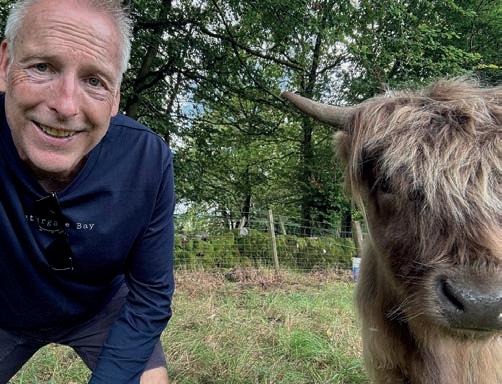
Made Designs, Future Fit for Business and The ASA showcased innovative products and services designed to help operators enhance performance, efficiency, and customer experience. The day began with a Keynote Panel chaired by David Monkhouse, which set the tone for the event. The discussion centred on the crucial theme of “Generating recurring income and secondary spend”, a topic increasingly vital for leisure operators navigating financial pressures and evolving customer expectations. Panel contributors included Active Insight’s Julie Allen, CIMSPA’s Megan Richardson, ukactive’s Claire Place, The Scottish Leisure Network Group’s Alan Cunningham and Community Leisure UK’s Kirsty Cumming. Each brought their own perspective on sustainable growth and diversification of


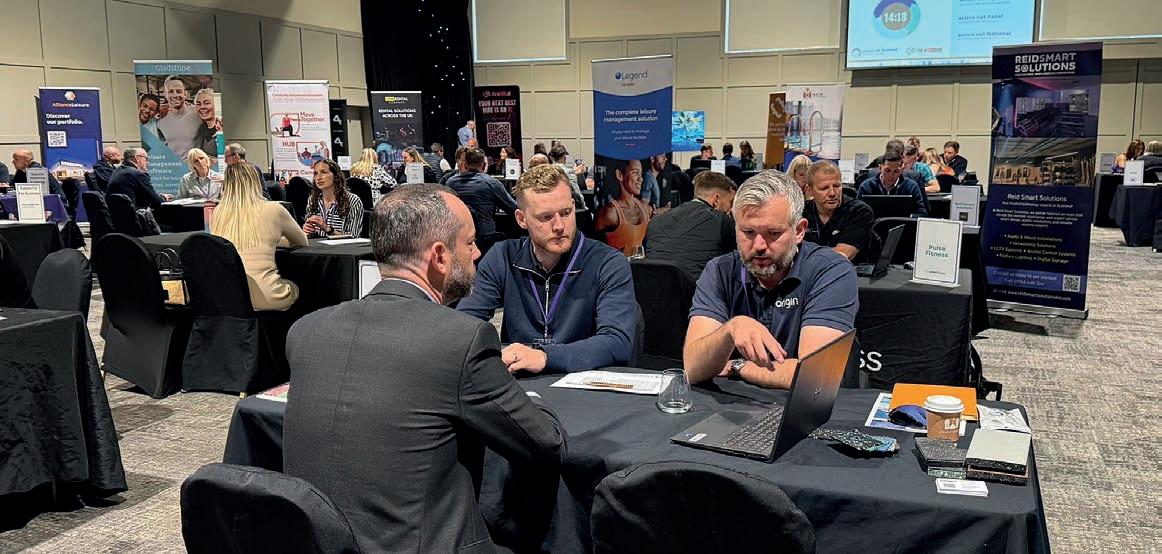
The quality of discussion and the efficiency of the format continue to set active-net apart from other networking events
income streams, providing delegates with both inspiration and practical takeaways.
From there, attendees split into two parallel workshops, each designed to dig deeper into the themes of the keynote. The first, also led by David Monkhouse alongside James Taylor (Taylor Made Designs) and Ross Black (Sportmax), focused on “Passive income and secondary sales”. Delegates explored innovative approaches to driving revenue that enhance the member experience.
Running alongside this was a session chaired by Julie Allen on “Data and insight to inform passive income and secondary sales”. This workshop, supported by Claire Place of ukactive and Inverclyde Leisure’s Robert McVitie, highlighted the increasing role of data in shaping customer engagement and improving decision-making.
After a morning of learning, delegates embarked on what makes active-net truly distinctive, a schedule of one-to-one meetings between buyers and suppliers. These pre-arranged conversations allowed suppliers to showcase solutions tailored to the exact needs of operators, while buyers gained access to new ideas and partnerships with minimal time wasted…it is effectively business speed dating! The quality of discussion and the
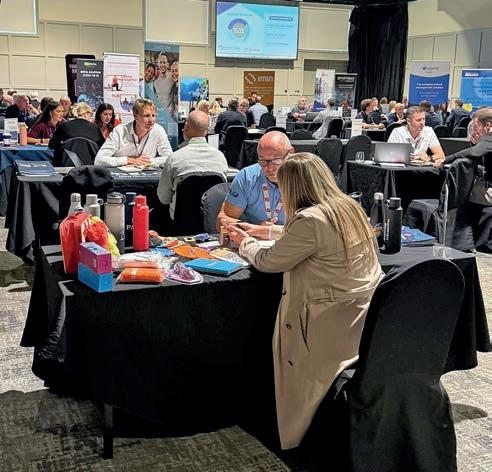
efficiency of the format continue to set activenet apart from other networking events.
The day concluded with a relaxed open networking session, followed by an always lively group exercise class, a fitting way to end the event. Delegates then enjoyed an evening meal and overnight accommodation, ensuring plenty of opportunity to strengthen the new connections made throughout the day.
After a strong mix of education, structured meetings and informal networking, delegates left with actionable insights, valuable contacts and fresh opportunities to enhance their organisations. Attention now turns to upcoming events, active-net Open Water at Holme Pierrepont Nottingham on 15th October, and active-net Padel (North) at Bolton Arena on 3rd December. To find out more visit active-net.org.

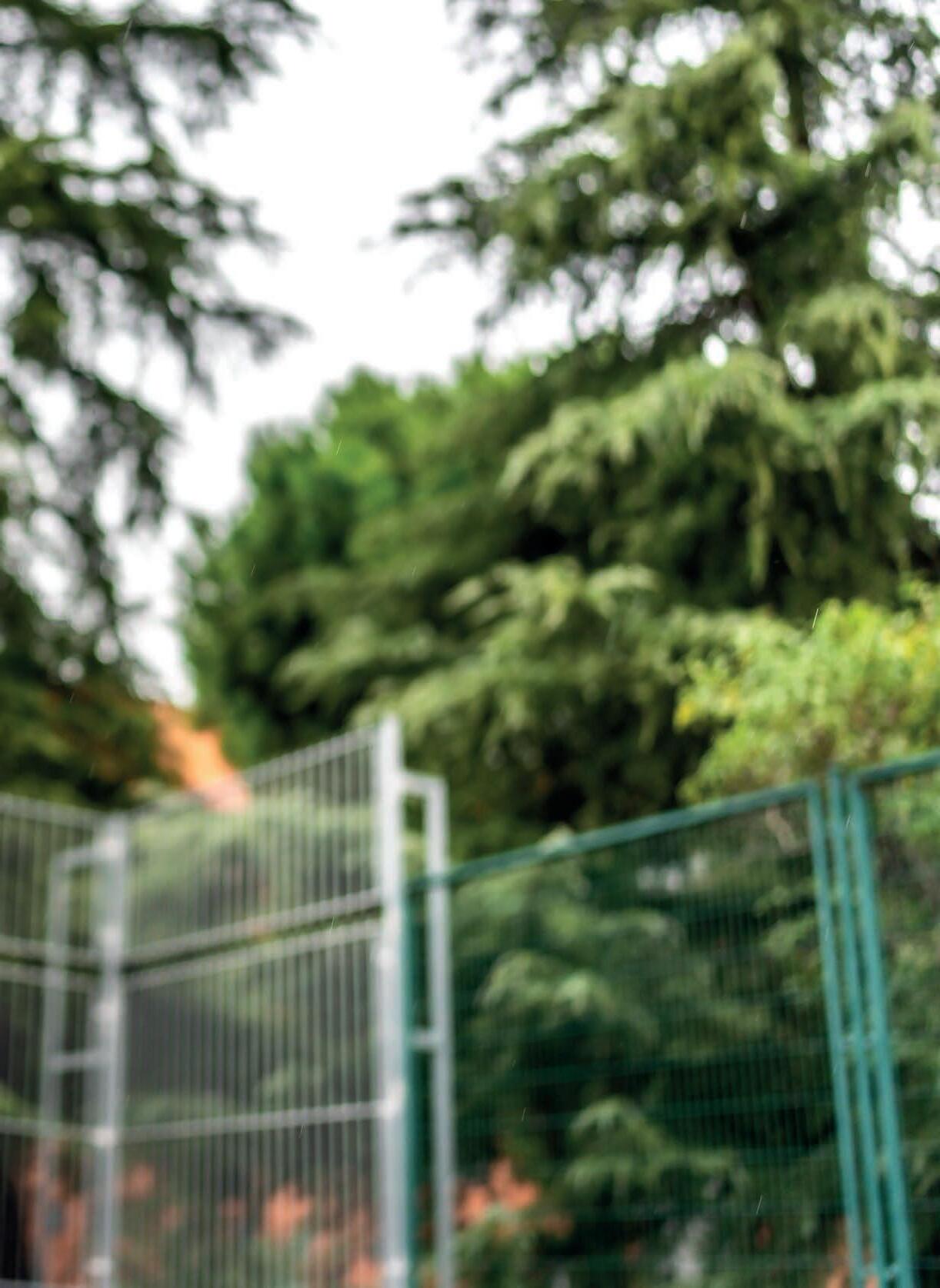
is so
A garden game created by two bored men has developed into one of the fastest growing racquet sports in the world. SportsNation looks into how pickleball is challenging padel as the most exciting new sport on the block
Pickleball is growing rapidly across the UK. The sport’s national governing body, Pickleball England, estimates that there are now more than 60,000 regular players in the country, of which 52,000 are in England, and the number is fast increasing. The popularity is partly down to the low barrier to give the sport a go – pickleball can be played on any existing badminton or hard court tennis court. The sport itself combines elements of badminton, tennis and table tennis – and there is a good reason for that.
On a warm summer afternoon in 1965, two friends had gathered their families together at a house near Seattle, US. As the day went on, they found themselves sitting around with little to do. The property they were at – belonging to one of the friends, future US congressman, Joel Pritchard – had an old badminton court but not enough rackets. It led Pritchard and his guest, entrepreneur Bill Bell, to improvise and start playing with pingpong paddles and a perforated plastic ball. At first they placed the net at badminton height of 60 inches and volleyed the ball over the net. As
the weekend progressed, more games were played and the players found that the ball bounced well on the asphalt surface – so the net was lowered to 36 inches. The following weekend, a third friend, Barney McCallum, was introduced to the game at Pritchard’s home. Soon, the three men created rules, relying heavily on badminton. They kept in mind the original purpose, which was to provide a game that the whole family could play together.
Fast forward 60 years and the founding ethos of pickleball – being a game that the whole family can enjoy, regardless of skill level – is at the heart of the sport and is one of the main factors behind its success. No special equipment is required and any comfortable clothing and pair of trainers are fine.


While pickleball’s initial growth took place purely in the US and at a slow burn (the US Amateur Pickleball Association, USAPA, wasn’t set up until 1984), the sport has made up for lost time by explosive growth in recent years. When it rebranded in 2013, the USAPA had 4,071 members. Two years later, in 2015, it surpassed 10,000 members. By 2017 the figure had more than doubled to 22,000 and then to 40,000 members by the end of 2019.
In the UK, the first pickleball clubs emerged in 2011. From there, similarly to the US, the sport spread slowly at first, but has since gathered pace and is now expanding at a phenomenal rate.
Karen Mitchell, chair of Pickleball England, says that the sport is now growing significantly.


“The birth story for UK pickleball is that people saw the game being played in
“The birth story for UK pickleball is that people saw the game being played in Florida in 2011,” Mitchell says. “They then brought the sport over to several places
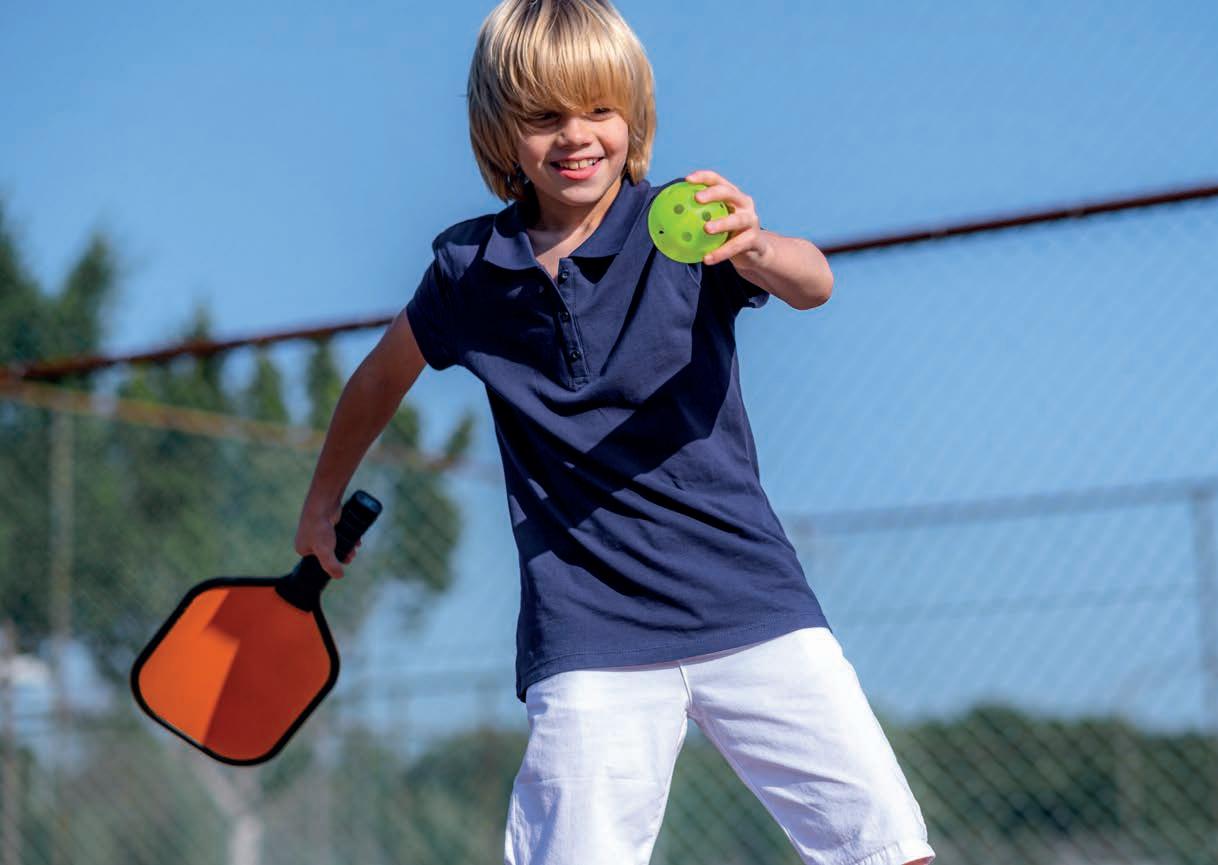
There are an estimated 60,000 regular pickleball players in the UK


in the UK. By about 2015, there were around 200 players. Pickleball England was launched in January 2019 and by the end of that first year we estimate there to have been 2,000 regular players – of which 1,115 had become members. We also had 94 clubs signed up. Since then, things have grown quickly. Last year (2024), there was a 73% increase in the number of members. During the first eight months of this year, we have already seen a 30% increase on last year’s number.
“In terms of places to play, we have added 310 new clubs. We now have 685 clubs providing sessions in a total of 927 venues.”
Pickleball England was recognised as the sport’s national governing body in 2024. According to Mitchell, the recognition has enabled the sport to flourish. “Pickleball is no longer seen as ‘not a real sport’,” Mitchell says. “Pickleball England’s recognition also means that we can now apply for Sport England and National Lottery funding – something we haven’t been able to do before.”
Pickleball is played both outdoors and indoors on a badminton-sized court (6.1m x 13.4m) with a 36inch net at the sidelines and 34 inches at the centre. Just like the Pritchard and Bell families did during those first games in 1965, players use solid paddles and a perforated plastic ball. This means that it is suitable for both indoor or outdoor play. Pickleball can be played both as single or double games.
The exact number of pickleball courts is hard to estimate. Partly because courts originally built for other racquet sports are being converted to pickleball ones by private individuals.
“Our best estimate is that there are currently around 100 dedicated pickleball courts, with many of them being private courts,” Mitchell says. “But there are more than 22,000 badminton courts and another 20,000 hard court tennis courts that pickleball can be played on.”
As the sport grows, there are plans to define and set standards for some of the technical aspects
Number
of facilities. “When it comes to facilities, a 40ft x 64ft court is the ideal space requirement,” Mitchell adds. “We are now discussing the possibility of creating a facility development/technical guide for the building of courts with The Sports and Play Construction Association (SAPCA).”
Defining standards and to ensure consistency will become increasingly important, as the sport grows its reach. Especially as Pickleball England has set some ambitious targets for both active players and facilities.
“We have set a target of 1 million players by 2030,” Mitchell says. “We initially set a target of 25,000 by 2025 and smashed it with over 50,000, so we are being even more ambitious this time!”
She adds that getting young people to play is at the heart of the plans: “We are currently working on our schools strategy. To date, we have had a very reactive response to school enquiries, so our new strategy will be much more pro-active. We

are looking to equip PE teachers with the skills to teach pickleball, with a full curriculum they can leverage, alongside access to affordable equipment and the creation of competition and pathways.
“Over the past few years the average age of our members has reduced from 60 (in 2019) to 56 today. The average age of new members is 52.”
For facilities, the plans are less defined. “We don’t have a specific target for the number of pickleball courts built in this timeframe, but 1,000 seems like a good initial target,” Mitchell says.
Age distribution of regular pickleball players
4,500 4,000 3,500 3,000 2,500 2,000 1,500 1,000 500 0
Pickleball is no longer seen as
‘not a real sport’

“The beauty of pickleball is that it is so accessible. You can chalk a court on a car park or drive, you can leverage existing badminton or tennis courts and even MUGAs and ball courts.
“However, we do see the next phase being the development of dedicated facilities. We are aware of indoor and outdoor facilities in the planning phase, so we’re confident that even more dedicated facilities will become a reality in 2025 and beyond.”
While pickleball is very much about inclusiveness and playing for fun, there are also elite competitions. In fact, Pickleball England is responsible for staging the largest pickleball tournament outside the US.
“Our English Open in Telford had more than 2,300 registered players this year,” Mitchell says. ”If we didn’t have capacity constraints, we would have exceeded 3,000. Our English Nationals tournament sold out many of its events within 2-5 minutes of registration opening.”
The growing number of active pickleball players and facilities – alongside the demand for competition play – shows that the sport is experiencing healthy growth. There are also signs that commercial operators are taking note, with a number of projects now featuring pickleball courts alongside padel courts.
“Initially, pickleball in this country was the domain of the retired,” Mitchell says, “But that is changing. We are now seeing pickleball hotspots growing around the country.”
219 Sports was launched in 2020 to change the way talented UK athletes earn scholarships in the US. SportsNation spoke to founder, Tom Baker, about how the company looks to deliver on its promise of “turning dreams into a reality” for young sportsmen and women
What is 219 Sports and what does it do?
219 Sports exists to open doors for student-athletes, particularly from the UK and Europe, by connecting them with US university scholarship opportunities. We specialise in college football (soccer) placements and have successfully placed hundreds of athletes across more than 30 US states. Our model is deliberately hands-on: we only represent a select number of athletes each year to ensure every client gets the attention and strategy they deserve.
On top of our consultancy and placement service, we run Showcase Tours. These are week+ long trips where squads travel to the US, visit campuses, experience world-class facilities and play matches against university teams. It’s a once-in-a-lifetime opportunity to not only see college life up close, but also get recruited directly by coaches. This October, for example, we’re taking a squad to Orlando, Florida for an eight-day tour.
Where did the motivation to launch 219 Sports come from?
The motivation was simple – I absolutely love US college sport. I believe it’s the best environment in the world for 18–23-year-olds. You’re able to be treated like a professional athlete in your sport while simultaneously working towards a degree – it’s life-changing.
When I went through the process myself, I saw some gaps – the lack of guidance, support and personalisation. I knew there was a better way. That’s why, at the start of 2020, I launched 219 Sports:
to give young athletes the chance to chase both their sporting and academic dreams in the U.S., but with proper guidance every step of the way.
For those unfamiliar with the US scholarship model, how does it work?
The US college system is a unique sporting landscape. Athletes from around the world can be recruited to play full-time for a university team while earning a degree. Financial scholarships can come in two forms: athletic scholarships awarded by the coaches, and academic scholarships awarded by the university itself based on grades and admissions criteria.
Importantly, US degrees carry the same academic weight as those from UK universities — so student-athletes graduate with both a world-class degree and an incredible sporting experience under their belt.
What does the company offer to young people looking for a scholarship?
Quite simply, we offer them the chance to change their lives. Our process is comprehensive. We help build their recruiting profile, market them to coaches, negotiate offers, and guide them through admissions, visas, and eligibility requirements. Beyond that, we offer something that really sets us apart: aftercare. Once a student is in the US, our support doesn’t stop. We stay with them right through to graduation, offering advice, reassurance, and guidance whenever they need
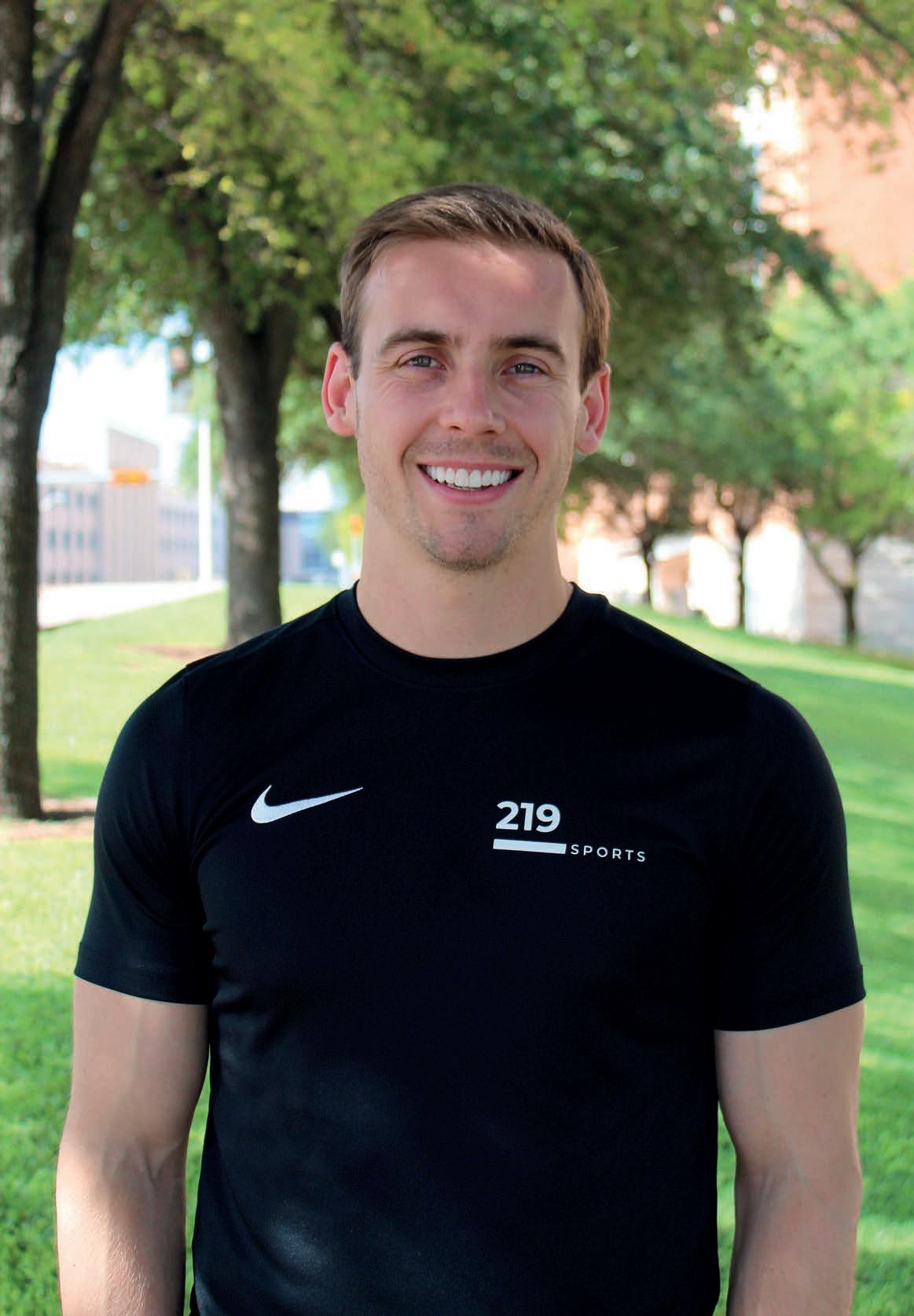

“Like many 16- and 17-year-olds, I wasn’t entirely sure what I wanted to do after school, let alone for the rest of my life. Then I stumbled across the concept of “college sport” in the US – student-athletes competing in front of 50,000, 60,000, sometimes even 100,000 fans. I was hooked.
That discovery led me to the University of Charleston in West Virginia, where I spent four years on a soccer scholarship while earning my business degree. After graduating, I returned home and started a career in sales. It wasn’t a long-term calling, but it gave me invaluable grounding in communication, relationship-building, and persistence.
I always knew I wanted to start my own company, and with my personal experience of the U.S. college system plus growing connections in football across the North West, I took the leap and launched 219 Sports.”
We’re not a conveyor belt –we’re hands-on, selective and invested in every single placement
it. Having been through the process ourselves, we know how valuable it is for both athletes and families to have someone on the other end of the phone who understands the ins and outs of college life in the U.S.
What are the requirements for a young person looking for a scholarship?
It’s not easy, and the bar is only getting higher as the US continues to attract global talent. That’s why we have a thorough assessment process.
First, we look at intent: does the student truly want to pursue this path? Then we assess their academic ability – are their grades strong enough to gain university admission? Finally, we evaluate their athletic level, either by watching them live, reviewing game footage, or through our own 219 Sports events.
Only after careful assessment and conversations with the family do we invite athletes to join 219 Sports.
Which partners do you work with?
We’re fortunate to be well-connected on both sides of the Atlantic. In the UK, we’re a verified partner of the League Football Education (LFE) and also collaborate with academies, independent clubs, schools, sixth forms, and colleges.
In the US, we work with hundreds of universities and colleges from the west coast in California to the east coast in New York – including household names, like UCLA, UCF and WVU – ensuring our athletes have every chance to find the right fit for them both academically and athletically.
Since launching in 2020, we’ve placed more than 200 student-athletes across the U.S., securing more than $5m in scholarships and financial aid.
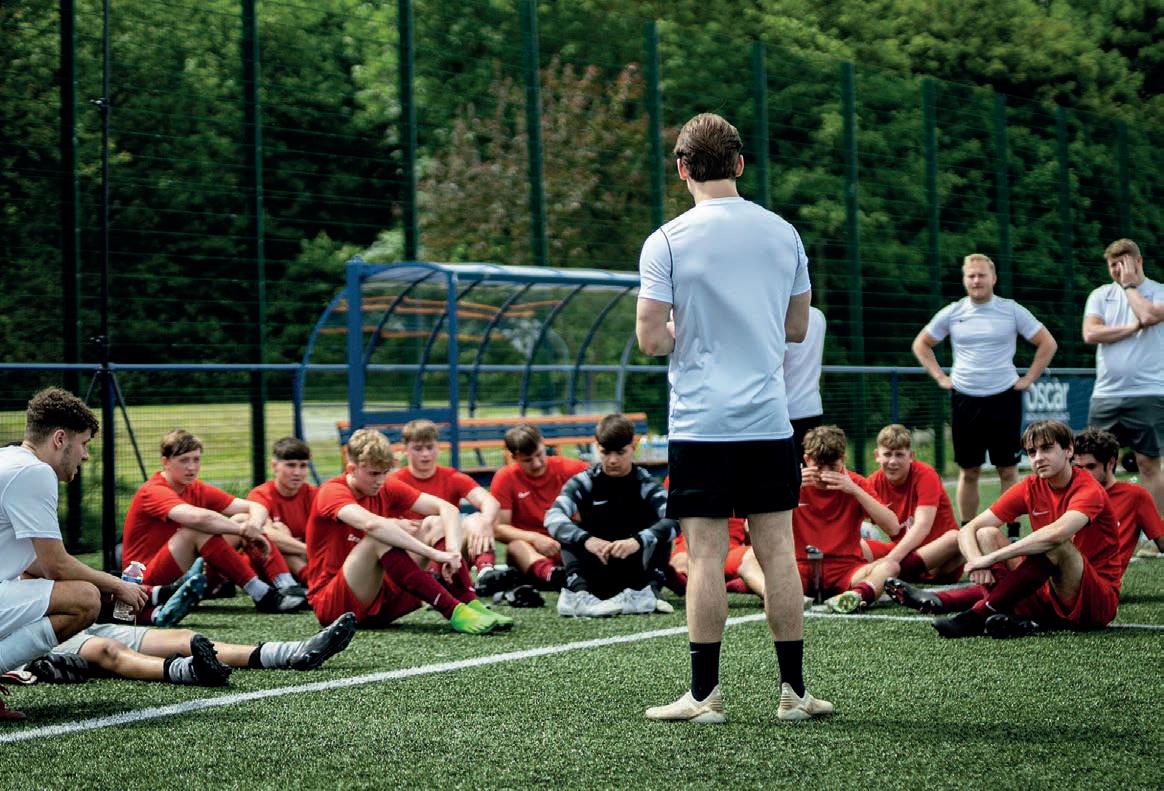
What is your business model – where does 219 Sports make its money?
On the placement side, we typically work with 65–75 athletes a year. We offer two packages: ● Gold Package: our full consultancy service, completely hands-on.
● Express Package: an online platform providing all the resources and guidance athletes need while giving them more control of the process. We charge fees for these services, with pricing varying by package. Alongside placements, we run Showcase Tours, which are priced based on length and location. Non-219 athletes who attend a tour are also automatically enrolled onto our Express platform, giving them ongoing support and opportunities beyond the trip.
Our USP is personalisation. We build genuine relationships with athletes and their families, tailoring the process to their goals. We’re not a conveyor belt — we’re hands-on, selective, and invested in every single placement. That approach consistently delivers the best scholarship outcomes and, more importantly, the best experiences for our athletes.
What are the future plans for the business?
We’re in a strong position, growing year-onyear in both placements and revenue. I moved
to the US 18 months ago, which has opened huge opportunities for us stateside.
This year we launched our first Showcase Tour on the men’s side, with the inaugural trip to Florida in October. We have some really exciting projects in the pipeline for our 2026 tours that we’re looking forward to announcing soon.
With a presence now firmly established on both sides of the Atlantic, we’ll also be expanding our reach to U.S.-based athletes. We’ll not only help them secure scholarships domestically, but also open pathways to opportunities in the UK and Europe.
Do you see the UK ever developing a scholarship model like the US?
Honestly, it would be difficult to replicate. In the US, college sport has a cultural significance that’s hard to overstate – it’s closer to Premier League football in England than it is to UK university sport. Stadiums with 100,000+ fans, national TV deals and billions of dollars in investment fuel that system and that’s what allows universities to offer such substantial scholarships.
That said, I do think the UK and Europe could build more effective, desirable systems to retain some student-athletes who might otherwise go abroad. It won’t ever be on the same scale as the US, but there’s room for growth and innovation here.
The government has pledged a “game changing” £400m investment in grassroots sport. But where should the funding be directed to, in order to maximise its impact?
Grassroots sport across the UK is set to benefit from more than £400m in funding, as part of the government’s Plan for Change. Designed to deliver facilities that will “inspire people of all ages to get active”, the £400m will be invested in new and upgraded facilities in communities across the country. The funding commitment, which was outlined in the Spending Review in June, has now been set out by Culture Secretary Lisa Nandy.
Among the priorities identified for the funding will be to remove barriers to physical activity for underrepresented groups – such as women and girls, people with disabilities and ethnic minority communities. This will, according to the government, include the building of new pitches and changing rooms and installation of floodlights, solar panels and goalposts.
Announcing the investment, Nandy said: “At least £400 million will be invested in new and upgraded grassroots sport facilities across the UK that support and improve access to better health, active lifestyles, wellbeing and community cohesion. We will prioritise underserved places, working closely with sporting bodies, devolved government and local leaders to establish what each community needs, and then set out further plans.
“This will include a stronger focus on removing the barriers for groups such as women and girls, people with disabilities, ethnic minority communities and those in the most deprived neighbourhoods.”
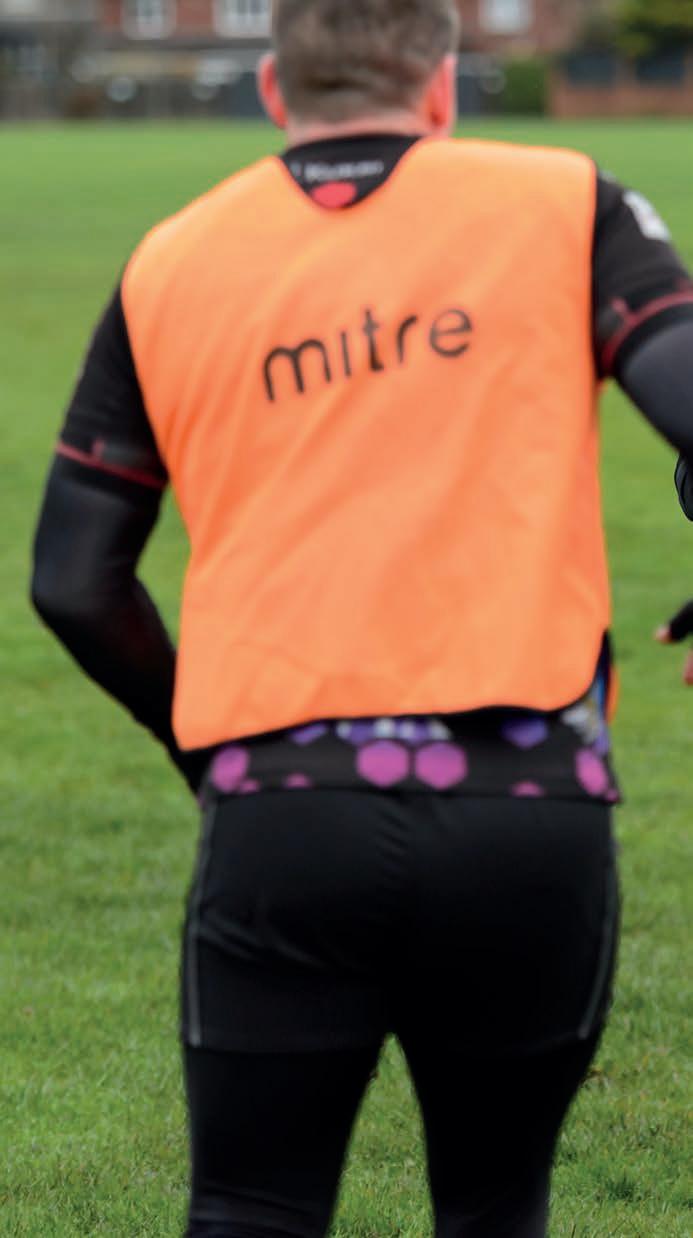
It is part of a larger, £900m investment in sport, which will also see more than £500 million committed to supporting the delivery of a host of world class sporting events being held in the UK over the coming years. These will include the men’s and women’s Tour de France Grand Départs in 2027, the men’s UEFA EURO 2028 tournament and the European Athletics Championships 2026 in Birmingham. The events are expected to deliver significant economic benefits, with EURO 2028 alone projected to generate up to £2.4 billion in socio-economic value across the UK.
According to Nandy, the strategic investment in both facilities and major events has been designed to “reduce barriers to opportunity, bring communities together through shared national moments and showcase the best of the UK to the world”.
“Sport tells our national story in a way few other things can – uniting communities, inspiring millions, and showcasing our nation on the global stage,” Nandy said.
“This major backing for world-class events will drive economic growth across the country, delivering on our Plan for Change. Coupled with strong investment into grassroots sport, we’re creating a complete pathway to allow the next generation of sporting heroes to train and take part in sport in communities across the UK.”
The government’s commitment to invest in sport has been universally welcomed by the sports and physical activity sector. However, while there is clarity on where a large chunk of the £500m on events will be spent – delivering specific competitions – there is less information and detail on how and where the
£400m on grassroots facilities will be directed. This has encouraged many to speak up and to highlight where they see the biggest need is. SportsNation lists the industry’s response – and how leaders and professionals would like to see the money spent.

Robert Sullivan CEO Football Foundation
“The government’s joined up approach – of investing in new and upgraded grassroots sports facilities alongside plans to supercharge major sporting events – places sport at the very heart of communities up and down the country.
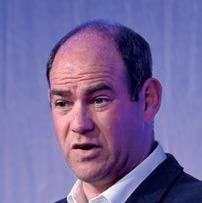
“Thanks to funding from the Government and the Premier League and The FA, the Football Foundation has invested £1.2 billion to improve grassroots facilities across England. However we know there is still more that needs to be done. In partnership with local authorities, County FAs and other community stakeholders, we have created Local Football Facility Plans for every local authority in England. These Plans act as a blueprint for providing the grassroots football facility improvements that each community needs and deserves.
“The government’s funding announcement will help us to activate these plans and ensure every community in England has access to a great place to play.”
Liz Green Chair Local Government Association’s Culture, Tourism and Sport Board

“Local communities rely on sport and leisure facilities every day, whether it is swimming for the family or going to the gym. The benefits to both physical and mental health can be lifechanging. Yet without urgent investment we risk losing these altogether.
“It is positive the Government has announced £400 million for grass roots sports facilities. But for this funding to be truly transformative, we are calling for this to be invested via councils, so it can have the impact that delivers the ambition the Government has to improve our nation’s health.”













Geoff Webb CEO Grounds Management Association
“This significant funding package recognises the vital role that high-quality sports infrastructure plays in supporting participation in communities across the country. It also reflects the collective efforts of the wider sporting sector, including the often-unsung work of grounds management professionals and volunteers.

“The GMA is at the forefront of improving the quality and safety of playing surfaces across the UK. Since the launch of the Pitch Advisory Service in 2014, the GMA has carried out over 50,000 pitch inspections in England, working alongside National Governing Bodies (NGBs) as well as local authorities and volunteers to raise standards and improve playing surfaces. This funding allows us to continue that vital work, ensuring clubs and communities benefit from wellmaintained facilities that inspire more people to play and stay in sport.”
Huw Edwards CEO Ukactive
“With this level of investment, the Government has a unique opportunity to help shift the dial on the nation’s physical activity levels and significantly improve the nation’s health, but it must ensure it is targeted in the right areas.

“It must avoid repeating the mistakes made by previous governments of the past – of focusing investment in facilities that have not delivered a healthier nation – and instead invests in facilities that match the needs of communities. The government must work with the sport and physical activity sector to channel funding into the facilities and programmes that are meeting consumer demand. Investing strategically in gyms, pools and leisure centres will demonstrate the Government’s commitment to the major drivers of physical activity and help address the market failure of public sector facilities so they can fulfil their essential role.”
Richard Shaw CEO SAPCA

“Sports and play facilities are essential for getting people more physically active and it is great to see the government recognise that. What is also crucial is that those facilities are of high quality and then maintained so they remain available for people – and not fall into disrepair.
“We encourage the government to ensure that the investment will result in high-quality sports and play construction projects that are designed with longevity and sustainability at the heart of them. That way, the government can ensure that the £400m funding will fully benefit the people and communities who need them the most.”
Donna Pentelow Chair Chief Cultural and Leisure Officers Association (CLOA)

“Council leisure centres, swimming pools and outdoor spaces are on the frontline of local health and wellbeing. We see every day how vital these facilities and spaces are to support active wellbeing for residents of all ages. A place-based investment approach ensures funding reaches the communities that need it most. By directing grassroots sports funding through local government, we can support its appropriate use to truly tackle health inequalities and deliver on the Government’s long-term health ambitions.”

Andy Salmon CEO Swim England
“We have long been making the case for the need for investment to deliver a network of sustainable pools for the future and so it is welcome to see this investment from the government. In its announcement the government talks of delivering ‘new grassroots facilities that can drive economic growth and inspire people of all ages to get active’.

“We know swimming is a huge part of the answer to delivering on those objectives. Swimming remains an incredibly popular activity for people of all ages, but particularly amongst older age groups (two million adults aged 65+ go swimming each year) and those with long term health conditions (17 per cent of adults with three or more health impairments swim each year) – many of whom may struggle to be active out of the water. That’s why we need to see this investment targeted at the pools and leisure centres the nation needs.”
Kirsty Cumming CEO Community Leisure UK
“Public leisure is at the heart of communities across the country, offering opportunities for communities to be physically, mentally and socially active. We urge the Government to invest in public leisure facilities, from single site community run pools to large leisure venues, supporting them to be sustainable and enabling people to live healthier and happier lives.”

Chris Boardman Chair Sport England
“The government’s continued investment into grassroots sport facilities is welcome news; the nation’s pitches, pools and leisure centres play a pivotal role in keeping people moving.

“With every £1 invested in community sport and physical activity generating £4.20 in value for our economy, supporting grassroots facilities isn’t just good for public health – it’s a smart investment in the nation’s social and economic wellbeing.”
The 29th IAKS Congress will take place in October. One of the main threads for this year’s edition is the importance of designing energy-efficient and environmentally friendly sports facilities
The 29th IAKS Congress – organised by the International Association for Sports and Leisure Facilities (IAKS)
– will take place as part of the FSB 2025 event in Cologne, Germany in October. The theme for this year’s congress is “Creating high-performing facilities for an active future”, with a number of sessions discussing the ways to design and build environmentally sustainable and energy efficient sports facilities.
“Owing to the increasing demands on sports and leisure facilities, this year’s IAKS Congress is focusing on the performance of facilities,” says Dr Stefan Kannewischer, President of IAKS.
“With fewer resources, they have to generate greater benefits for users and society while, at the same time, reducing their environmental footprint. High performance is, therefore, demanded not only of the top athletes among their user groups, but also of the facilities themselves.


“Owing to growing financial pressures, both the economic efficiency of facility operation and the benefits generated by sports infrastructure for society are becoming increasingly critical. This is why ascertaining and communicating the ‘social return on investment’ (or social value) is so important.”
The congress programme features four days of sessions and discussions. The opening day, Tuesday 20 October, features three 90-minute slots. The first two, titled “Strategies towards netzero sports and leisure facilities” and “Reducing the embodied carbon”, will have a focus on the environment, with speakers including Dr Anne Pfeil from the Davos Baukultur Alliance and Mike Hall from architects FaulknerBrowns.
The third session of the day will look at social value and return on investment of physical activity and recreation infrastructure. It will include a discussion on the public value and Social Return on Investment (SROI) of sports facilities, with the aim of “reshaping the way we understand, measure, and communicate the


true impact of physical activity infrastructure”.
Speakers include Prof. Takanori Fukuoka from Tokyo University and Emma Bernstein, the Strategic Projects Lead at Sport England.
Other highlights of the four-day programme include a presentation featuring fresh insights on inclusiveness and circularity. Taking place on Wednesday 29 October, the workshop will showcase practical approaches to designing for inclusion across age, gender, and background. It will also present delegates with examples of how activating the “urban fringe” and embracing informality can extend the reach of sport beyond traditional facilities.
In addition to the educational programme, the Congress will also see the revealing of the winners of the IOC IAKS Architecture Prize during a gala dinner on 28 October.
“This year’s IAKS Congress is all about action – showing how the sports and leisure industry gets things done,” adds Silke Baltzer from the IAKS event management team.
“The congress programme explores innovative venues and forward-thinking concepts that are already transforming active communities. Delegates will be able to dive into realworld solutions that address current trends and challenges shaping the way facilities are designed and planned for the future.”
28-31 OCTOBER 2025
Architects, engineers, designers, scientists, and operational managers from around the globe will share high-quality insights into best practices, emerging trends, practical solutions, and cutting-edge technologies.
500+ participants from 40 countries
A unique opportunity to gain diverse perspectives, exchange experiences, and learn from a wide range of cultural and professional backgrounds.
Engage in a dynamic mix of presentations, discussions, panels, workshops, and more — all focused on the future of sports and leisure facilities.
● For the full programme of sessions, visit: https://iaks.sport/congress-programme
● For the official brochure for the event, visit: https://bit.ly/3IqJbgY
● To book your space, visit: https://iaks.sport/congress-tickets
The artificial sports turf sector is undergoing an evolution that has environmental sustainability at its heart. SportsNation looks at the latest developments
With EU legislation phasing out rubber crumb infills used in 3G pitches by 2031, the industry is busy looking for alternative products. As a result, a range of organic infill alternatives, such as cork, pine and birch wood, olive pits and corn, are growing their market share. While it is currently uncertain whether the UK will follow the EU’s lead and adopt a ban of rubber infill, an increasing number of pitch systems are being developed without the need for it. This evolution of artificial grass pitches brings new questions and challenges around their maintenance for consistent and long-life performance. Unlike rubber crumb, the long-term behaviour of organic infills is not yet fully studied or understood. Factors such as rate of infill loss, compaction, material durability and breakdown – as well as coldweather performance (frost and freezing) – all have implications for player safety, play performance and capital and running costs for owner/operators.
To address these challenges, a new knowledge transfer partnership (KTP) was launched between SAPCA member, Technical Surfaces (a Sportex Group Company), a leader in artificial pitch
maintenance and Loughborough University’s Sport Surfaces Research Group, based at the university’s Sports Technology Institute.
The collaborative initiative, part funded by Innovate UK, is led by KTP Associate Zach Morley. The 30-month project is focused on developing evidence-based maintenance and performance monitoring frameworks for these next generation of organic infilled artificial pitches.
Building on many insights and innovative analysis techniques from a previous KTP, analysing rubber crumb systems, the KTP team is combining standard and modified on-site testing with novel laboratory analysis of these natural infill materials; which exhibit a wide variety of physical properties and more complex behaviour relative to rubber infills.

As an example, it has developed an innovative method for precisely measuring how the particle size distribution of installed organic infills may degrade in service, allowing for more accurate monitoring of infill breakdown. The potential degradation of infills is a key factor in the longevity of a pitch – and organic infills are generally considered as less durable than rubber-based ones.
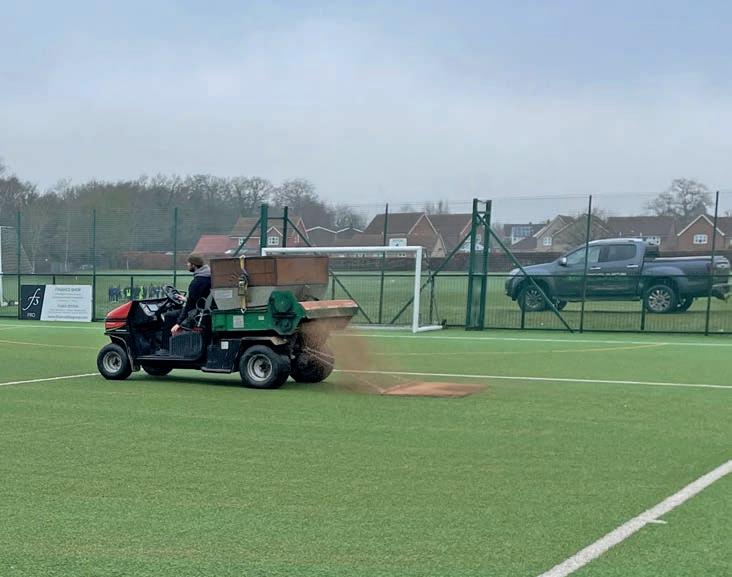
Field testing is key for data-driven evaluation of the effectiveness of different maintenance techniques and the need to adapt their nature and frequency on these non-rubber infill systems. The collected data helps to model the expected degradation in performance of organic infill pitches and for Technical Surfaces to successfully design tailored asset management maintenance packages for the specific organic infill systems installed.
As the industry embraces and drives greater sustainability practice, it is concomitantly vital that the sector evolves effective maintenance management practices for the high cost and high value playing field assets, benefitting all the many stakeholders impacted.
Organic infills open the door to more sustainable pitches
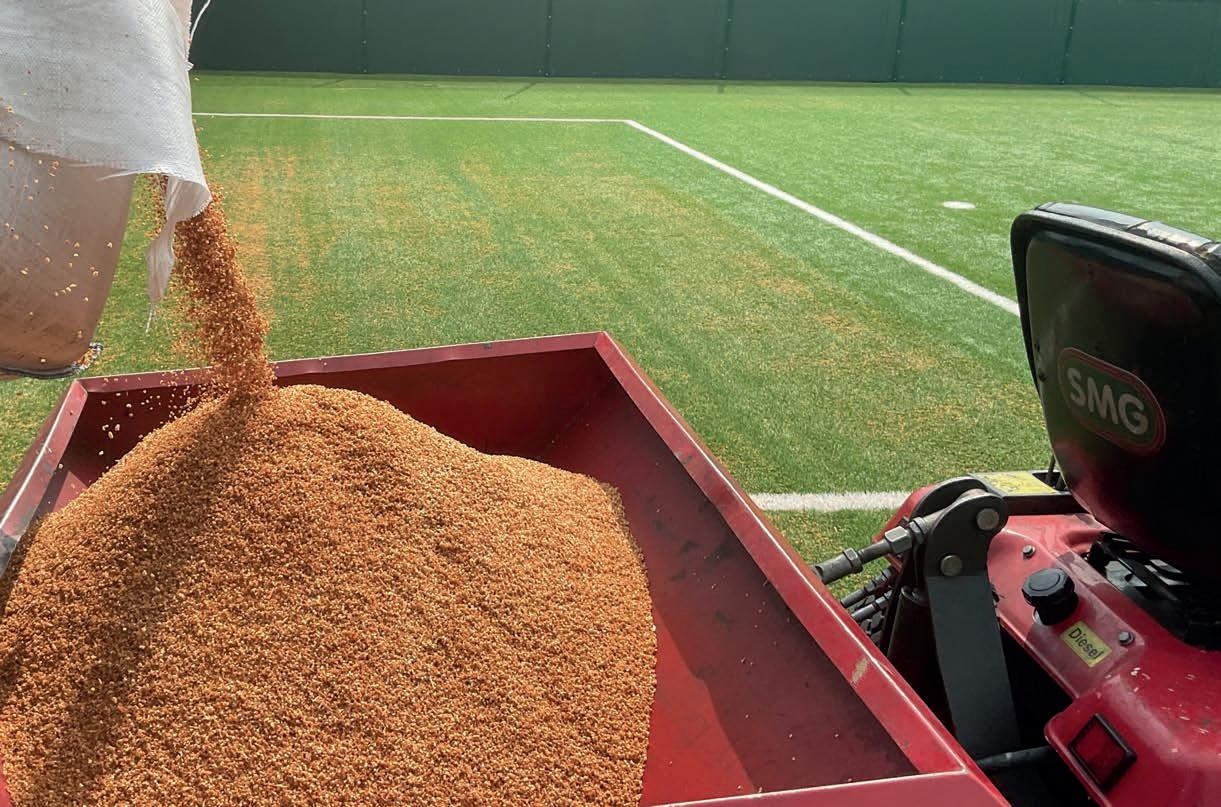
A round-up of the latest developments in the artificial sports turf sector
EnviroStik launches Eco-Fix adhesive made out of recycled pitches
SAPCA member EnviroStik has launched its new Eco-Fix adhesive range, a groundbreaking development in adhesives, where innovation meets sustainability. Eco-Fix is manufactured using recycled synthetic grass, reducing impact on the planet while providing superior bond adhesion.
Helping to close the loop on the sports and play construction industry for a circular economy, it is the first product of its kind on the market, produced from end-of-life synthetic grass carpets. As a result, Eco-Fix helps projects meet sustainability targets and reduce their environmental footprint. Its innovative recycled content formula meets or exceeds all governing body standards, such as FIFA.








Based on the average-sized football pitch, Eco-Fix eliminates a minimum of 5 million microplastic particles from inevitably polluting ecosystems. The innovation looks to redefine environmental sustainability for sports and leisure surfaces, with a unique blended formulation designed to be an essential industry resource.
Rob Edge, Sales and Technical Development at EnviroStik, says: “We’re proud to lead the way in sustainable innovation. Eco-Fix is a game-changer, turning old synthetic grass into a high-performance adhesive that helps reduce waste and meets green targets.”
Africa’s first World Rugby-certified 3G pitch features organic infill
Africa’s first synthetic rugby pitch certified by World Rugby features a natural cork infill developed by SAPCA member company, Amorim Sports. Installed at Curro Windhoek School in Namibia, the project marks a major milestone in sustainable sports infrastructure for high-temperature regions.
With average daytime temperatures reaching 35 °C (95°F), the school required a surface that could ensure both player performance and safety under extreme conditions. Amorim Sports’ Infill Nature, a highperformance cork solution, was chosen for its exceptional thermal resistance, reducing surface temperatures by up to 12°C (53.6°F) when compared to some traditional synthetic infills.
Beyond heat mitigation, the cork infill delivers outstanding

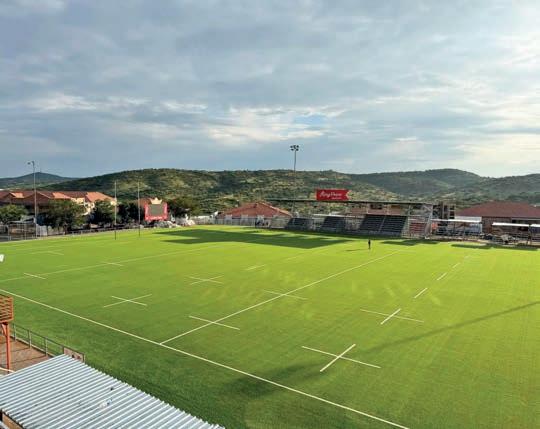
shock absorption, UV resistance and long-term durability, providing a consistent playing experience while supporting athlete wellbeing. Made from renewable raw materials, Infill Nature is 100% recyclable, microplasticfree, and carries a carbon-negative footprint of –72.5 kg CO2e/kg.
Stoke City invests in maintenance regime as part of synthetic pitch strategy
English Championship football club, Stoke City FC, has implemented a strong synthetic surface care programme at its training ground with the help of the new Syn-Pro SVR 1500 by SAPCA member company SISIS, a division of Howardson Ltd.
The SVR 1500, a two-in-one deep cleaning and decompaction machine, has been a trusted part of the maintenance regime for two years, impressing Andy with its ease of use and results. “It’s robust, simple to use and gives us the finish we need. It cleans, distributes rubber evenly and removes a surprising amount of debris.”
Used mainly during dry months, the SVR 1500 ensures a smooth, consistent surface while supporting Stoke’s sustainability goals, including its long-standing pesticide-free approach.
Stoke City’s Grounds Manager, Andy Jackson, who has spent more than 30 years at the club, knows that artificial pitches demand meticulous upkeep.
“Synthetic surfaces require around eight to ten hours of maintenance every week,” he says.

Our aim is to get beyond a pitch’s expected lifespan. Having the right equipment, like the SVR 1500, is key to achieving that
“If you stay on top of it, you’ll dramatically extend the life and quality of the pitch.”
“Our aim is to get beyond a pitch’s expected lifespan. Having the right equipment, like the SVR 1500, is key to achieving that.”



































The days of soaking hockey pitches before every match could soon be over, with the arrival of an innovative, waterless artificial turf pitch. Domo Optimum Dry – from SAPCA member company, Domo Sports Grass – is described as a breakthrough surface able to deliver elite, water-based playing performance without using any irrigation water.
Already making waves in Europe, including a landmark installation in Vlissingen, the Netherlands, the pitch is now available for the UK market. Its patent-pending yarn technology features ultra-fine, round fibres with a unique smoothness-enhancing additive, creating a surface that offers the same consistent glide and grip as a watered pitch, while reducing injury risk and maintenance demands.
Engineered for speed, control, and safety and aimed at UK hockey clubs, schools and local authorities, Domo Optimum Dry dramatically cuts
A landmark project in South Africa is highlighting how synthetic turf can be used to enable freshwater recycling. Two ‘Cruyff Courts’ are simultaneously providing a high-quality playing surface while integrating an advanced water collection and filtration system under the field, providing the local community with fresh potable water.
The installation of the courts is part of a wider initiative by the Cruyff Foundation, supporting various sports endeavours for children, and young people with special needs. The two new fields in Orange Farm, near Johannesburg, bring the total number of Cruyff Courts to 10 in the country.
The project was headed up by sustainable sports specialist, Dutchblue, which provided an advanced water collection and filtration system through its partners Project GreenSource SA.
The ‘Catch-Store-Reuse’ sports system captures rainwater, stores it in its sub-base, and purifies it in a GreenSource container next to the field. Runoff collected by the system is filtered to remove contaminants, including bacteria and metals, before being pumped to a fountain for use as potable water. The purified water can then be used via a tap on the outside of the container.
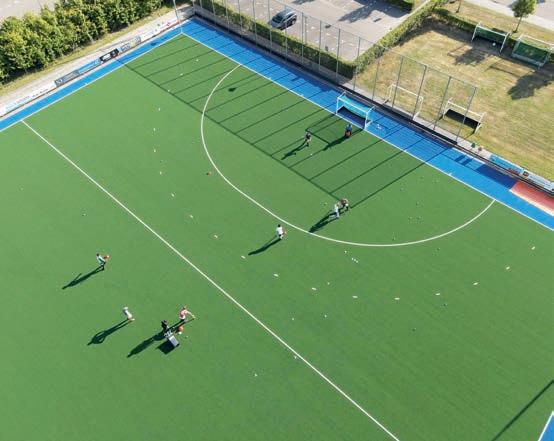
operating costs, supports year-round play and features the Domo Infinitum recyclable backing –meaning it’s as sustainable as it is high performing.
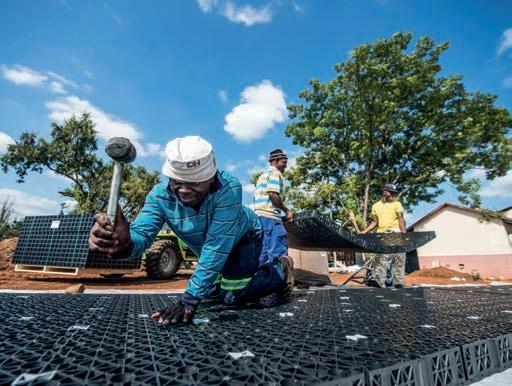
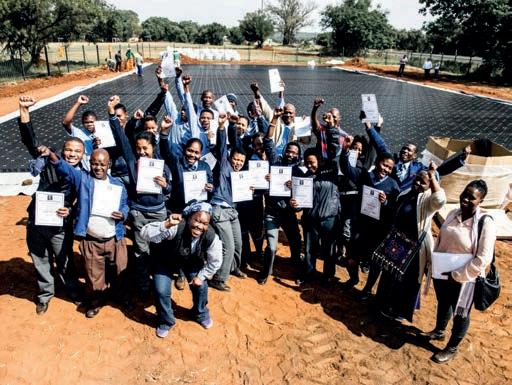












































































































































Two landmark projects are showcasing how Pure PT by TenCate Grass, delivered in the UK through TigerTurf, the industry’s leading non-infill synthetic surface, is transforming the game from grassroots to elite academies

ith Bangor City Stadium and Sheffield Wednesday both embracing TigerTurf’s Pure PT technology, the new surface is setting a new benchmark for performance, safety and sustainability across football.
Bangor City Stadium in Wales has become the first site in the UK to install a full-size Pure PT pitch. Delivered by Sportex with support from the Cymru Football Foundation, this £350,000 project is part of the FAW’s Fit-For-Future Facilities Programme. The pitch offers world-class playability without the need for rubber infill, combining durability with a lighter environmental footprint. For Bangor, it’s not just about a surface, it’s about creating a hub for the


community, with upgraded changing rooms, catering and more to follow. Meanwhile, Sheffield Wednesday has invested in Pure PT at its Middlewood Road Training Facility as part of its biggest training pitch upgrade since 2015. As the first professional football academy in the UK to adopt the surface, the Owls are backing their long-term vision for player development and performance. The surface improves player comfort, safety and ball control while reducing maintenance demands, a strategic investment that will benefit generations of players.
Pure PT is no experiment. It is the result of years of development at the Centre for Turf Innovation (CTI), TenCate Grass’s global R&D hub dedicated to advancing surface technology. Since 2019, Pure PT has been refined through more than 50 design iterations, shaped directly by feedback from elite players, coaches and performance experts. Validated at PSV Eindhoven’s FieldLab,



For Bangor, it’s not just about a surface, it’s about creating a hub for the community


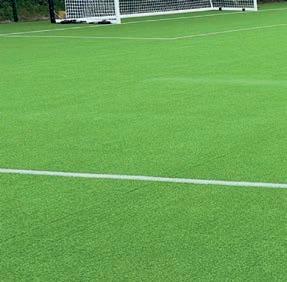



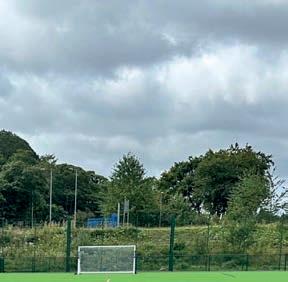



Pure PT feels like natural stadium turf, with softer fibres, greater stability and superior ball control

the process involved extensive on-field testing and player evaluations to create a surface that feels and performs like natural stadium turf. The result: softer fibres, greater stability and superior ball control.
Beyond performance, Pure PT delivers major sustainability gains and significantly lowers total cost of ownership over its lifetime. As it is 100% non-infill, it avoids issues of microplastic pollution and requires less maintenance. This means no infill top-ups, no decompacting and fewer cleaning cycles. Transport emissions are drastically reduced: a full-size Pure PT field needs only about six vehicle moves for installation. Over a decade, that means lower fuel use, fewer replacement parts and fewer resources spent.
Pure PT’s lifespan is around 30% longer than typical infilled turf, meaning reduced replacement frequency, reduced waste and a better environmental footprint. At end of life, Pure PT’s material composition makes recycling more straightforward and cost-efficient.
At both Sheffield and Bangor, the decision to install Pure PT is about more than performance, it’s about
building for the future. By removing rubber infill, Pure PT reduces environmental impact, cuts maintenance, and extends pitch lifespan. These benefits deliver long-term savings while ensuring facilities remain at the highest standard for years to come.
From elite academies to community grounds, Pure PT is reshaping how football thinks about artificial surfaces. At Sheffield Wednesday, it’s about creating the right environment to nurture talent. At Bangor, it’s about raising the bar for facilities and inspiring future generations. Together, they represent the beginning of a shift where innovation, sustainability and performance come together to support the next era of game changing fields.
As Aled Lewis, Director at the Cymru Football Foundation, puts it: “We are passionate about testing and trialling innovative approaches and embracing new technology to deliver the best facilities for our communities—and this project represents a significant milestone in the development of artificial pitch technology.” Find out more:tigerturf.com
On 12th and 13th November, thousands of grounds sta , turf managers and decision-makers will again come together in Birmingham for SALTEX 2025 - the show built by the industry, for the industry
Why is SALTEX special?
Because, unlike commercial exhibitions driven by profit, SALTEX is owned and run by the Grounds Management Association (GMA), with every surplus reinvested back into the sector through training, education, career development and membership. That’s why, for more than seven decades, SALTEX has stood as the trusted platform. It’s where the industry meets progress.
The world of grounds management is evolving at pace. From the rise of electric and autonomous machinery to the urgent need for sustainable practices that respond to climate change, today’s professionals are under pressure to adapt and deliver more than ever before.
Learning LIVE is a cornerstone of SALTEX, presented across three stages: the Main Stage, Spotlight Stage and Community Sport Stage. Together, they deliver a programme


shaped around the real challenges and opportunities facing today’s professionals.
Sessions draw on expertise from across the grounds management sector, including elite sport, community facilities, estates, education, local authorities, horticulture and landscaping. This creates a rare chance for genuine cross-sector knowledge sharing, where everyone can learn from each other.
Attendees will gain insights from James Williams (London Stadium) on hybrid and stitched pitches, and Karl McDermott (Lord’s) on the global standards and challenges of cricket surfaces, hearing directly from leaders who manage some of the world’s most demanding venues.
Beyond elite sport, Dr Denise Ludlam of Sport England will address how climate change is reshaping participation and the strategies required to protect play for future generations, whilst Will Brierley brings insight into grassroots facilities and Matt Pottage of the RHS connects the conversation to estate and horticultural management. Every session is built to offer practical takeaways you can bring back to your own surface the very next day.

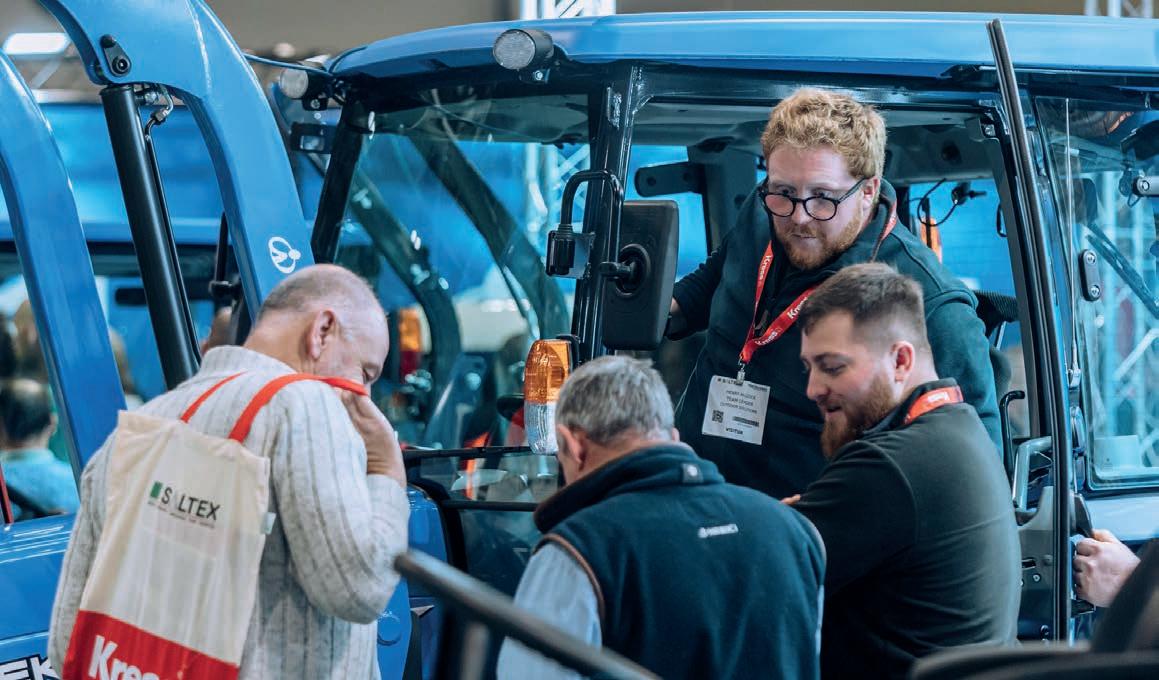
On the exhibition floor, innovation takes centre stage. Returning powerhouses Dennis, Husqvarna, Cramer, Kubota and ISEKI will showcase cuttingedge equipment and solutions, whilst firsttime exhibitors like Fendt, LEDture, Holcim and Cleveland Alliances bring fresh ideas and smart technologies into the mix.
Whether it’s the latest in battery-powered machinery, autonomous mowers, or nextgeneration turf solutions you’re after, SALTEX is where you can see, test, and compare it all under one roof. With 400+ industry-leading brands, its Europe’s cutting-edge marketplace dedicated to grounds management.
What makes SALTEX unique is its DNA. It’s not just another trade show. It’s the one event that exists solely to advance the sector. Owned and delivered by the Grounds Management Association, every aspect of SALTEX is designed with practitioners at its heart: from cross-sector networking opportunities to
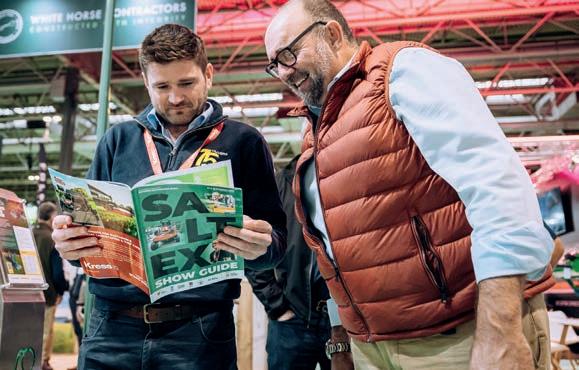
career and skills initiatives, to providing a launchpad for the very latest innovations.
That means when you attend or exhibit at SALTEX, you’re investing in your own performance but also in the future of the entire industry.
If you’re ready to discover smarter solutions, learn from the best and connect with the entire industry under one roof, there’s only one place to be this November.
SALTEX 2025 takes place on 12-13 November at the NEC, Birmingham. Visitor registration is free at saltex.org.uk


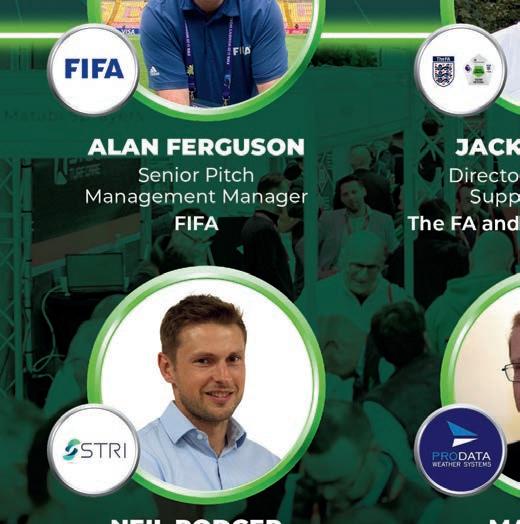





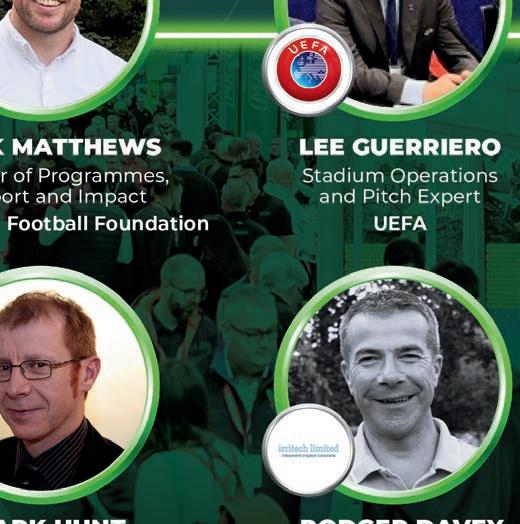

























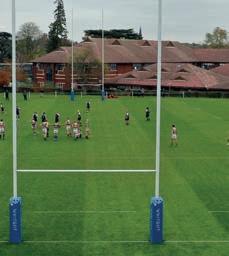









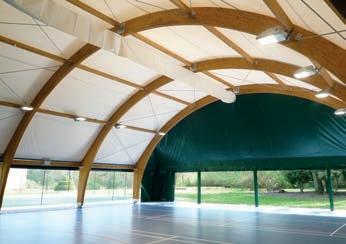















































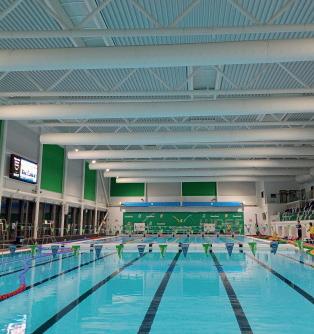
































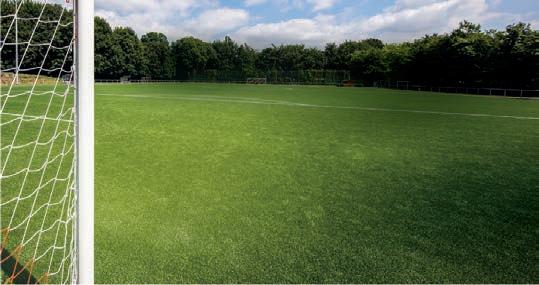


















































































































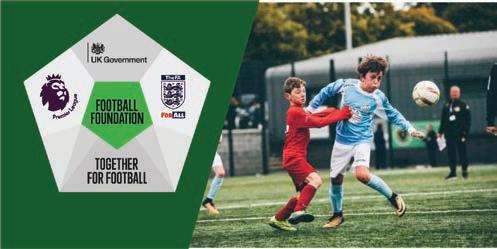



















































Animation inspired by real childhood adventures


Play in parliament on ground-breaking day

Indoor play
Highlights from AIP Conference
Play England campaigns for all children and young people to have freedom and space to play throughout childhood.
We work with national partners and other organisations with shared aims to raise awareness about the importance of play. We lobby government to make fundamental policy changes to protect and promote play, and encourage everyone who has an impact

on the lives of children and young people to recognise and plan for children’s play.
Play England has also built up considerable experience and resources to help support individuals and organisations that work in these particular areas:
Government
Local Authorities
Schools
Playwork

We need your support
The new UK government is making positive noises about understanding the importance of play. However, against this positive backdrop, Play England is suffering from a lack of funds to pay for our essential work campaigning for children’s right and freedom to play. Donate today to support our work. www.playengland.org.uk/donate

www.playengland.org.uk




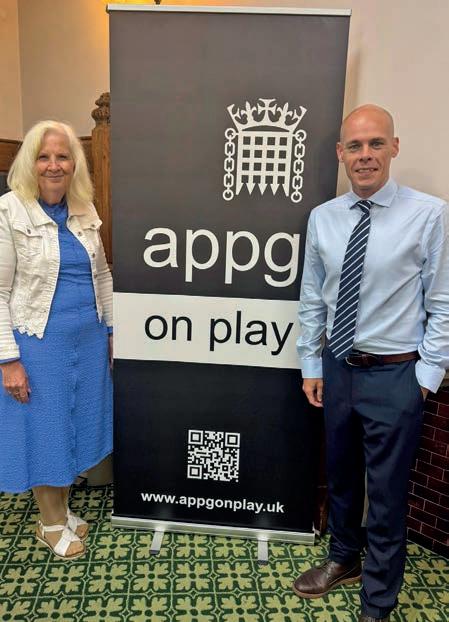
The latest news from around the play sector
104 AIP Conference 2025 review
The Association of Indoor Play’s 2025 Conference brought together operators, suppliers and industry experts for a day that was equal parts inspiration and reality check
108 Policy moves
Highlights from the inaugural meeting of the All-Party Parliamentary Group on Play, which took place on 2 September




112 In full sail
Work has begun on one of the UK’s largest city centre play spaces in Plymouth – inspired by the city’s location
116 Let play lead the day
A new animation film has been published to inspire families to find ways to play
122 Listening to your audience
PlayNation finds out that designing well-loved play spaces comes down to two steps – listen to the end-users and then deliver on their wishes



John Challinor
Publisher
PlayNation
john@nationmedia.uk



Maria Cantarella CEO
AIP
@AsscIndoorPlay

Eugene Minogue
Executive Director, Play England
@ EugeneMinogue

Tom Walker Editor
PlayNation
tom@ nationmedia.uk
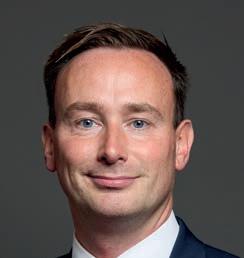
Tom Hayes MP
Chair, APPG on Play @ TomHayesBmouth

OgunsanyaWilliam Playworker @ playworkeramber










PlayNation, in partnership with Play England and SAPCA (the Sports And Play Construction Association), is dedicated exclusively to the dynamic and growing sector of play and physical activity for children and young people. Published bi-monthly, the magazine focuses on the policies, people and places that help young people to play and be more active. Subscribe now and we will email you a complimentary copy of the magazine every two months.
http://www.playnation.uk
Advertising opportunities
Contact John E: john@nationmedia.uk http://www.linkedin.com/ company/playnationmag @PlayNationMag FOLLOW US:
PlayNation is published by SportsNation Ltd in association with Play England (www.playengland.org.uk) and the Sports And Play Construction Association (www.sapca.org.uk) This publication is protected by copyright and no part may be reproduced, transmitted or stored in any print or electronic format without the written permission of the publisher. Every effort has been made to ensure the accuracy of the contents of this publication and PlayNation accepts no responsibility for any error or misrepresentation. Opinions expressed by the contributors and advertisers are not necessarily those of the publisher and we do not accept responsibility of losses or damages arising from them. Printed by Bigwave Marketing Ltd.
Play England is looking to strengthen its governance and leadership by adding to its senior leadership team.
The organisation is seeking to recruit and appoint an Independent Chair and two independent directors.
“We are looking for people primarily from outside the play sector who can bring fresh perspectives, expertise, and constructive challenge,” Play England said in a statement.
“These roles will help us deliver our mission to re-norm play in England, champion children’s right to play, and influence the systems and structures that shape childhood.”
Earlier this year, Play England published its 10-year strategy, It All Starts with Play!. According to Eugene Minogue, Play England’s Executive Director, the move to appoint independent professionals marks the increasing importance of play in national policy discussions.

The move shows how play remains firmly on the parliamentary agenda

“It is an exciting time to be part of Play England,” Minogue said.
“With play increasingly recognised in policy debates and public life, we need talented people who can bring independent perspectives, expertise and strong networks.
“For the independent roles, we aren’t looking for ‘play experts’ — we already have those on our Board. Instead, we are looking for people who share our values and can bring skills in areas like governance, law, finance and risk.”
In a major win for the play sector, the Play Sufficiency Amendment (NC82) has been reintroduced to the Planning and Infrastructure Bill during Committee Stage in the House of Lords.
Baroness Natalie Bennett tabled the amendment following sustained leadership from Play England.
According to Eugene Minogue, Play England’s Executive Director, the move marks a “critical step” forward in Play England’s objective to restore a play-based childhood for every child in England by 2035.
“This reintroduction in the Lords ensures that play remains firmly on the parliamentary agenda,” he said.
The city of Salford will be turned into a giant game as part of Beat the Street, a novel way of increasing activity levels across a population.
People of all ages are encouraged to ditch the car and walk, cycle or scoot as part of a drive to take children away from screens and back into nature.
An expected 27,000 children and adults, including 76 primary schools, are due to take part as the event gets communities connecting and exploring, and off their phones.
Around 250 beeping and flashing sensors called ‘Beat Boxes’ will be placed on lampposts around the city. Players score points by placing cards on the boxes and, the further players travel, the more points they score for their school, community, charity, or workplace team. Beat the Street encourages people of all ages to be active in their daily lives. It was devised by GP, Dr William

Bird, to make exercise and physical activity fun through gamification.
NHS research links too much screen time with sitting still and not being active — leading to weight gain and affecting sleep and concentration. Research in 2024 by ukactive also stated that two-fifths of
children want to be more physically active than they currently are.
Beat the Street has now been played by more than two million people in 200 towns and cities across the UK and beyond and, typically, 13% of the population of an area takes part.

The UK Playwork NOS Consortium has published a new information sheet that gives an update on the progress of the National Occupational Standards (NOS) on Playwork review. The information sheet (number 3) reports on activities and key achievements made since January 2025. These include the establishment of expert groups, the development of a functional map and the review and drafting of NOS. The information sheet aims to ensure the playwork sector is kept well informed, consulted and engaged throughout the NOS review process.
The UK Playwork NOS Consortium comprises Play Wales, Play Scotland, PlayBoard NI, Play England and The Playwork Foundation.
It is expected that the final NOS will be published to the UK Standards in Autumn 2025.
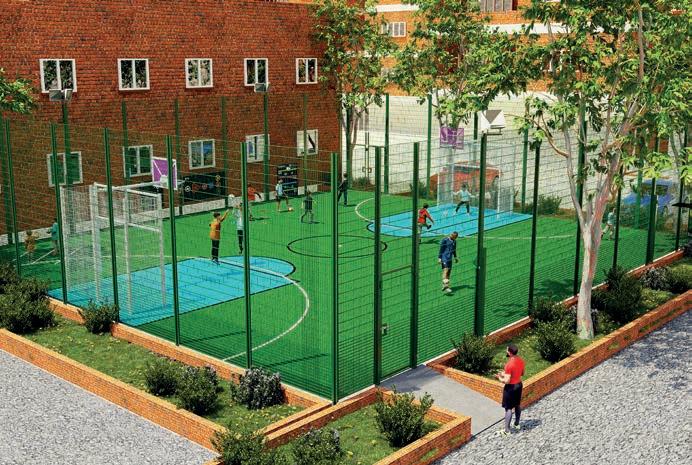
Two of Westminster’s most tired ball courts – at Churchill Gardens Estate and Church Street – are getting a new lease of life this autumn, thanks to an ambitious refurbishment project led by Play Innovation.
Work began in mid-August and the sites will soon showcase Play Innovation’s signature familyinclusive games, including Street Snooker X, Corner Skills, and the vibrant Funky Hype Multi Goals. The games have been designed to get children, young people, and families moving together in fun, creative ways.

The upgrades also include the installation of a new playing surface, Matchplay 2 – a durable, synthetic sports surface by Playrite – new fencing, floodlighting and roof netting to ensure safe, year-round play.
Marco Boi, founder of Play Innovation, said: “We’ve worked closely with the team at Westminster and taken a holistic approach to the entire project. Each location will be activated with inclusive activity workshops with local charity SportWestminster to maximise the investment by our client.”
PlayBoard NI is looking to add to its senior management team as it looks to grow its reach across the region.
The lead organisation for the development and promotion of children’s play in Northern Ireland is seeking to appoint a new Director of Corporate Services & Finance.
Playboard NI said: “We are looking for a highly motivated and experienced individual to take up the role in which they will hold strategic and operational responsibility for finance, human resources and administration – ensuring strong governance, effective systems, and robust financial controls are in place to support PlayBoard’s continued growth and impact.
“They will also oversee all financial and management accounting and play a key role in organisational planning and the future strategic direction of PlayBoard.”
For more information on the role, visit: www.playboard.org
The UK’s leading play organisations came together during this year’s Playday to call for more inclusive and welcoming spaces where children can play freely and feel part of their communities.
Play organisations of the four home nations urged the government and local authorities
to maximise opportunities for play in schools, childcare, youth settings and public spaces which are shaped by the voices, needs, and experiences of children and young people themselves.
The theme for this year’s Playday, on 6 August, was to highlight the importance of quality spaces for play.



A project that worked with residents and used a scientific movement model to transform an underused play area in central Portsmouth into a colourful, interactive space, has celebrated its first anniversary, having recently won an award.
PLAYCE Pompey opened in July 2024 and is a versatile and colourful activity space, designed to get the community moving.
The multi-activity playground was a joint project between Portsmouth City Council and the University of Portsmouth. The design is based on a

pioneering scientific model for movement developed in the Netherlands, with a focus on being accessible for people of all ages and skill levels, including those with disabilities. There are no separate play areas for different groups, but an integrated activity space for all.
The council’s Portsmouth Homes landlord service and the University worked with local residents to make sure the space would be welcomed and used – particularly by those living in the council homes that surround the area.
Work to replace and create a new playground at Hamble play area in Belgrave, Tamworth, has been completed. Designed by Wicksteed, the £35,000 plans will incorporate a multi-play unit with towers, connecting bridge and pole slider, swings, sensory panel, seesaw, basket seat and a rock n bowl.
The new playground – which is owned by Tamworth Borough Council – includes low level access, hand holds, plus a wider variety of new play equipment.
Councillor Lewis Smith said: “The new Hamble play area will provide a bigger playground and new equipment. The area will now provide a multitude of play experiences and imaginative play opportunities for children to enjoy.
“A local playground is a wonderful way for parents to introduce young children to playground equipment and new friends. It will be far more exhilarating than the previous play area and more inclusive too.”
Work has begun to transform Homefield Park playground with new play equipment chosen by the community.
Last year, Worthing Borough Council asked residents what play equipment they would like to see included as part of planned improvements to the popular park.
Thanks to the participation of more than 110 playground users sharing their views in person – as well as nearly 600 online consultation responses – the council has chosen play equipment specialist Eibe Play to design an inclusive play area that will appeal to children aged between two and 12.
The Association of Indoor Play’s 2025 Conference brought together operators, suppliers and industry experts for a day that was equal parts inspiration and reality check
With 24 Association of Indoor Play (AIP) trade suppliers in attendance at this year’s AIP Conference 2025 – and with food sampling available throughout the day – delegates had plenty of opportunities to connect, discover and experience what the wider sector has to offer.
The event opened with The WonderWorld Story, presented by Narinder Singh Baryah, Managing Director of the WonderWorld Group. He shared the remarkable growth journey of Scotland’s fastestgrowing family-owned leisure brand. From the first site in Falkirk in 2013 to the brand-new Southampton opening in 2025, WonderWorld has continually evolved. The group has diversified into trampoline parks, inflatables and even crazy golf with Electric Thrill, proving that variety really is the spice of life.

Attention then turned to the looming Employment Rights Bill, with Dominic Cooper, Professional Support Lawyer at Citation, giving delegates a timely employment law update. He warned that the sector must prepare for the most significant overhaul in employment law for decades. Sick pay from the first day of absence, unfair dismissal rights from the first day of employment, a ban on fire and rehire and tighter harassment duties will all require careful planning. Further reforms include new rules for zero-hours contracts, stronger family leave rights and the creation of a Fair Work Agency with real enforcement powers. The message was clear: operators cannot afford to wait until 2027 when the final wave of reforms is due. Preparation must begin now.
“Always have a plan B, surround and strategy must evolve in
Singh Bariyah was candid about the challenges along the way. The pandemic nearly broke the business model but strong funding relationships, creative pivots and sheer determination ensured the business emerged stronger. His advice to delegates was straightforward: “Always have a plan B, surround yourself with the right people and accept that leadership and strategy must evolve in a world of wage inflation, rising costs and increasingly demanding customers.”


The focus then shifted to marketing, with Matt Baker, Chief Executive of Destination Marketing, delivering a no-nonsense review of how customer perception is shaped. Parents do not just read adverts; they interpret the quality of a business from the way it presents itself. A slow website, broken social media links or sluggish responses to enquiries create a poor impression long before a family even arrives at the door. His tongue-in-cheek “how to lose a customer” checklist drew knowing smiles but his point was serious. Operators must strip out friction,
Parents do not just read adverts; they

media links or sluggish impression the



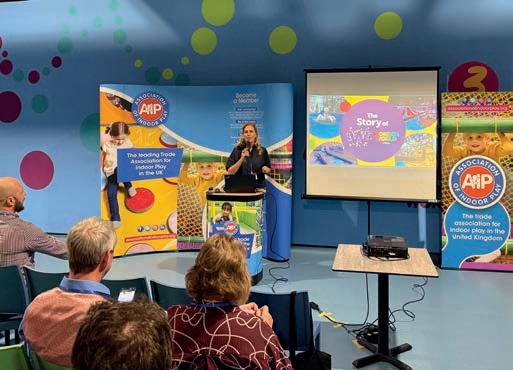


ensure consistency across every channel and embrace storytelling, video and new tools such as artificial intelligence. In a competitive market, the businesses that own their narrative will be the ones that stand out.
Finally, Ken Lunn, Chartered Accountant and owner of Jack in the Box (and AIP’s Finance Director), addressed the topic “where has all the profit gone?”. With inflation, rising wages and the cost-of-living crisis biting hard, many operators are finding that revenue may be up, but profit is slipping away. Ken reminded delegates that profit, not revenue, must be the measure through which every decision is made.
He provided practical tools to help operators tighten margins and encouraged businesses to know their numbers in detail by drilling into profitability per square foot, per head and per activity. He urged operators to challenge costs, from insurance and utilities to consumables and to review pricing more bravely. For example, moving away from blanket discounting and focusing instead on well-packaged experiences such as premium parties, quality food and beverage and loyalty-driven bundles.
Ken also advised the industry to think more like airlines or hotels, using yield management rather than chasing revenue. He closed with a reminder that summed up the day: “Turnover is vanity. Profit is sanity. Cash is reality. Do not just be busy, be profitable.”
Where has all the profit gone?
Key takeaway from Ken Lunn’s session
● Know your costs. Understand the difference between direct, fixed, variable and capital costs. Use break-even analysis to see how many families you need through the door.
● Focus on contribution. Not every pound is equal. Entrance fees usually deliver the strongest contribution, while F&B margins vary. Hot drinks and homemade food can be excellent profit drivers.
● Smart pricing. Fear of price increases often outweighs the reality. Regular reviews are essential. Without them, standards slip and profit disappears.
● Customer value. Success comes from clean, wellkept facilities, friendly staff, good quality food and drink and the right atmosphere. It is rarely about being the cheapest.
● Events and parties. Parties can be powerful profit drivers, sometimes outperforming general admissions.
● Cost savings. Small changes in staffing, heating, cleaning products and food preparation can have a big impact.
● Keep reinvesting. Fresh equipment, wellpresented facilities and quality experiences keep customers coming back.
Called Getting it Right for Play, the updated guidance supports the implementation of Play Scotland’s framework for children’s right to play in Scotland.
Shaped by engagement with families, communities and organisations – and informed by recent legislation – the toolkit is packed with useful tips and relevant case studies, giving step-by-step advice and tools to assess and improve play spaces.
Organisations – including local authorities – are encouraged to use the toolkit to engage with children and communities during the assessment and development of any play spaces and projects.
Paul Liddell, Chair of Play Scotland, said: “Getting it Right for Play has been shaped by extensive engagement with families, communities and organisations, with a strong focus
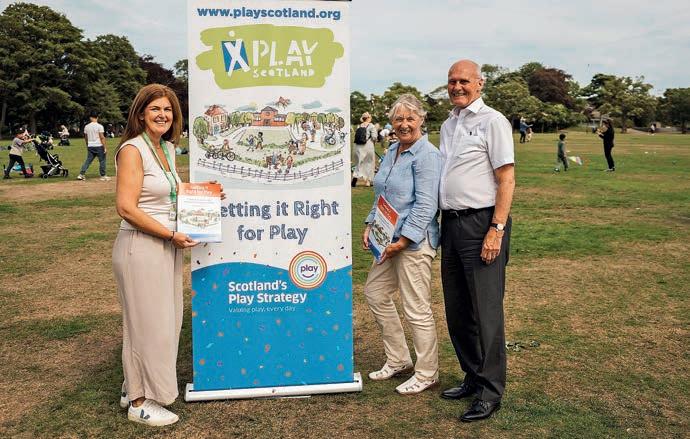
on the voices and experiences of children and young people with additional support needs.
“This guidance acknowledges the specific needs and barriers specific groups of children face and provides local authorities and community groups with
practical assessment tools to help them evaluate and improve play opportunities and spaces.”
To view and download the toolkit – and Play Scotland’s other resources – visit the dedicated toolkit page on the Play Scotland website: www.playscotland.org/resources/

The government has committed to investing £88m in youth services and after-school activities –including capital grants for upgrading youth clubs.
The Building Creative Futures package is part of the government’s National Youth Strategy, which is due to be published this autumn, and includes five major areas of investment.
These include the launch of the Better Youth Spaces programme, a £30.5 million fund to improve youth club infrastructure in areas with the highest levels of child poverty. This will go towards smaller capital projects such as new gym equipment and climbing walls.
A further £22.5 million will be invested over three years to create a tailored enrichment offer in up to 400 schools.

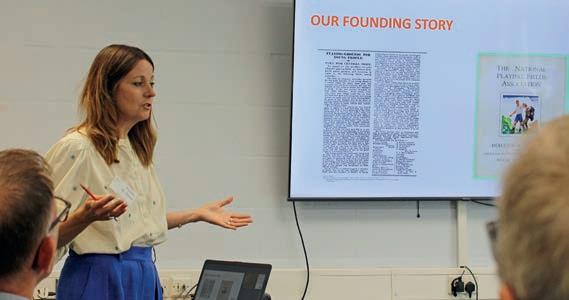

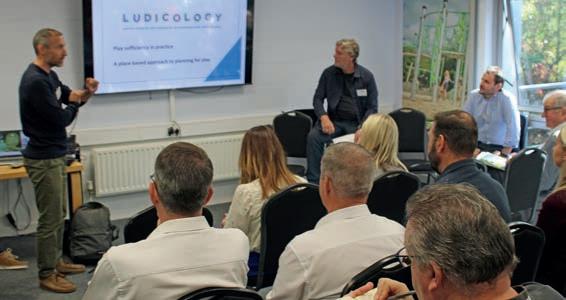
In early September, Sutcliffe Play were delighted to welcome guests from across the country to West Yorkshire for their annual Home Show exhibition. The event, now in its 12th year, brought together representatives from a range of parish, town, district and borough councils, as well as a number of playground installers, at the company’s headquarters in Upton, near Pontefract.
Across the two-day gathering, guests enjoyed informative seminars from leading play influencers including Eugene Minogue, Executive Director of Play England, who discussed the organisation’s new 10year national strategy – ‘It All Starts With Play!’. The strategy sets out a bold vision to restore a play-based childhood for all children by 2035, and his attendance marked another successful collaboration with Sutcliffe Play, following their sponsorship of the strategy’s launch in the House of Commons in May 2025.
Meanwhile, Ben Tawil and Mike Barclay – co-directors of Ludicology – conducted a hands-on interactive workshop, full of practical advice to help local authorities consider the full range of spaces, freedoms, and conditions that shape children’s capability to play where they live.
The speaker line-up was completed by Helen Griffiths, the CEO of Fields In Trust (currently
Sutcli e hosts its 12th annual Home Show exhibition – and it’s a playful success
celebrating the centenary year of its formation), who oversees the charity’s vital work in protecting our parks, playgrounds, and green spaces.
In addition, Sutcliffe Play’s team of Area Sales Managers led guests on a guided tour around the company’s factory, which produces thousands of pieces of high-quality play equipment every year. Visitors also explored the on-site playground, and enjoyed a close-up look at the newest addition: Unicorn, a dynamic multi-play unit which forms part of Sutcliffe Play’s brand-new Fantasy range for toddlers.
The guests weren’t the only ones to benefit from the Home Show, however, as catering throughout both days was provided by The Caring Kitchen, a local business whose profits directly fund a hospice in neighbouring Pontefract.
Sutcliffe Play Managing Director Rob Speirs said: “Our annual Home Show continues to go from strength to strength, and as this is my first as Managing Director, it’s a fantastic opportunity for me to meet our customers and talk to them about our business - in particular our fabulous new Fantasy product range. I’m looking forward to getting a real behind-thescenes insight into their needs and views on Sutcliffe Play and the play industry, whilst creating many fruitful new relationships with first-time guests.”
Two signi cant events took place in Westminster on 2 September – the inaugural meeting of the All-Party Parliamentary Group (APPG) on Play and the latest session of the DCMS Select Committee’s State of Play
Asignificant moment for the play sector, the launch of the All-Party Parliamentary Group (APPG) on Play brings together MPs, peers from the House of Lords and industry experts. The group, which met for the first time at Portcullis House in Westminster, will work towards ensuring that play is recognised, protected and embedded in policy, planning and public life.
Co-founded by Play England, the group includes 42 MPs and peers and is chaired by Tom Hayes MP – with Lord Greville Howard, Natasha Irons MP and Vikki Slade MP acting as vice chairs. Among the group’s aims is to push for a National Play Strategy and champion play sufficiency legislation. It will also advocate for a long-term funding settlement for play, with an annual target of £125m.
During the first meeting, the group heard an overview of Play England’s new strategy, It All Starts with Play!, which was launched in May. Tom Hayes MP also provided those present with additional context, highlighting that the first parliamentary
debate on play in eight years took place in January 2025 and, at an hour, the longest in 17 years.
“Play is essential for every child’s development, health, and wellbeing,” Hayes said. “But it is too often ignored in policy decisions.
“The APPG on Play will change that — working in Parliament to champion all children’s right to play and to ensure play is prioritised in communities and national decision-making. As parliamentarians we need to be the voice of children in Westminster.”
During the meeting, the APPG also defined its strategic objectives. These were defined as:
● Establish the APPG as Parliament’s cross-party voice for play
● Champion a new National Play Strategy
● Support Play Sufficiency legislation through the NC82 Amendment to the Planning and Infrastructure Bill
● Advocate for a long-term funding settlement for play (£125 million annually)
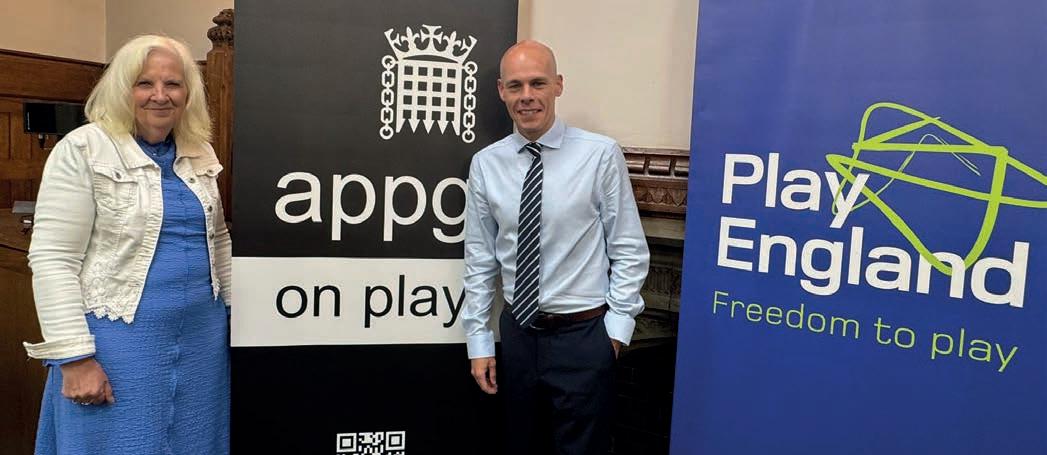
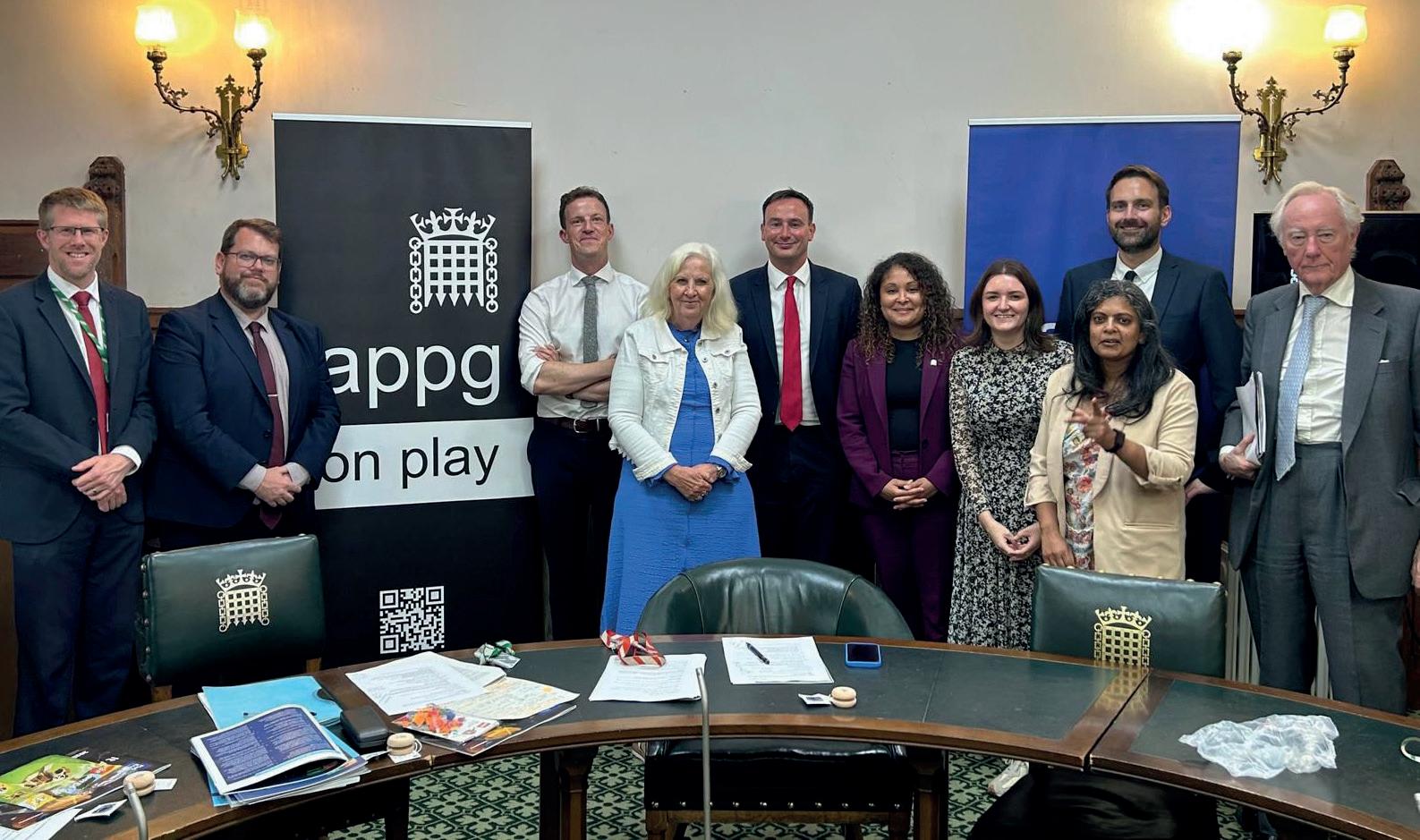
During the meeting, the APPG defined its strategic objectives
● Support the creation of a Minister for Play
● Align with sector strategies and amplify voices of children, families, and communities
● Reinforce legislative levers including National Planning Policy Framework (NPPF) Reform and the NC82 Amendment
The second meeting of the APPG has been scheduled for Autumn 2025 and the group is likely to meet bi-monthly thereafter. Play England’s executive director, Eugene Minogue, said: “Children’s freedom to play hasn’t just declined – it’s been squeezed out. Earlier this year, we highlighted the scale of the challenge for policymakers when we launched our 10-year strategy, It All Starts With Play
“To truly increase children and young people’s opportunities and guarantee them a right to play necessitates a rethink on how we plan, govern, fund and design for play – across streets, schools, services and society.”
Play was also on the agenda on another important meeting earlier the same day in the form of the The Culture, Media and Sport Select Committee’s
State of Play Inquiry. During the session – which included two hours of oral evidence – MPs explored the value of play and informal outdoor physical activity for children and young people, heard about the barriers that limit access and considered how Government can better support and promote opportunities for play.
The session was suggested by stakeholders, including the Centre for Young Lives and Playing Out, which invited ideas from across the sector on what MPs should be examining.
The first half of the hearing explored the recommendations in the Raising the Nation Play Commission’s report on the benefits and barriers to play in England, which was published in June. The Committee is likely to explore the role of the planning framework in the provision of play facilities and the level of Government funding for play. The second panel focused on issues related to outdoor play, including its inclusion in the curriculum, and how to tackle disparities in access to play. The session was chaired by Natasha Irons, the MP for Croydon East, who is also a vice chair for the APPG.
Children do not just need a home; they need a childhood, and their childhood starts on their doorstep
Those giving evidence on the day included chair of the Play Commission, Paul Lindley OBE. He highlighted some of the reasons why play has been “ousted” from the planning process.
“Play is what children do for their work, it is how they enjoy their childhoods and how they learn the skills that they will need for the rest of their lives,” Lindley said.
“Over recent years, there have been two pressures on planners, local authorities and developers that have relegated children’s voices within what is being built. One is around efficiency and the need ultimately to maximise the number of houses on a piece of land, resulting in small gardens or no gardens – one in eight children grows up with no garden. Secondly, around risk, there is the risk of providing something as a result of which a child is going to get hurt or that is deemed not safe in some way.”
When asked what facilities and designs he would like to see adopted in new developments, Lindley responded: “There are things like the London Plan Policy S4, which requires all new residential developments to provide at
least 10sq m of good-quality, accessible play and informal recreation space per child.
“There are non-cost things too, like removing “No ball games” signs and traffic-calming measures, which do pitch the rights of different people in the community against each other, but they are small costs. There are those sorts of things, together with training and working on ways for children and their families to have the appropriate voice when planning decisions are being made.”
The second panel of the session looked in more detail at outdoor play and education. Those giving evidence were Ingrid Skeels, co-founder of Playing Out – a parent and resident-led movement restoring children’s freedom to play out in the streets and spaces where they live – and Playing England’s Eugene Minogue.
Describing the success of Playing Out, Skeels said: “We had the idea of closing the road briefly for a time after school – remove one of the main barriers, which is traffic – so that children could reclaim the street for some play.
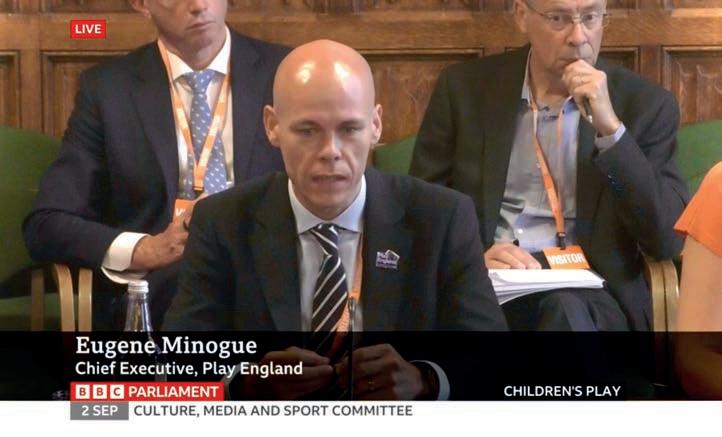
Children’s freedom to play hasn’t just declined – it’s been squeezed out

The reception was amazing. Children came out who did not know each other. Some of them were at the same school and they did not even know they lived on the same street. That is how indoors and separate we have all become. They met other children, played with children of different ages and neighbours came out who had not met each other.
“From that, the idea started to spread in Bristol and around the country and to other countries, because it tapped into something that parents feel and that we were feeling. So far more than 1,600 street and estate communities have regularly organised Playing Out sessions, with 50,000 children benefiting regularly. Those are the absolute bare minimum numbers, because we do not always get answers from councils as to how many roads they have closed.”
Eugene Minogue then made the case for policymakers to begin to rethink how the UK’s built environment is created – so that every aspect of it could encourage outdoor play.
“Currently, we build our whole built environment around the car,” he said. “The infrastructure for children has been decimated, and we need to treat play in the same way that we do utilities. It is critical infrastructure. Children do not just need a home; they need a childhood, and their childhood starts on their doorstep.
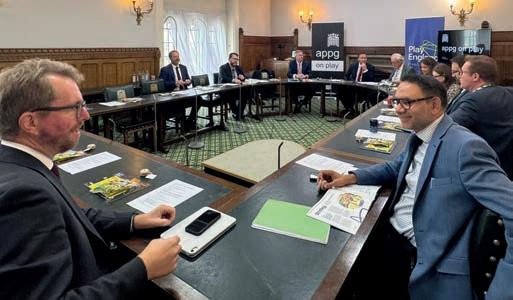
“That is why we need things like play sufficiency legislation. We have started to move towards it with the changes we secured in the national planning policy framework last December. Although policy is progress, it is not protection. We need play sufficiency legislation so that local authorities have a duty to consider children in the built environment. It is not just around more playgrounds, although those would be welcome because we have lost well over 800, and we have lost over half of our adventure playgrounds in my lifetime, since 1980.”
The APPG on Play has a dedicated page on the Play England website, where details of forthcoming meetings, agendas, minutes and key updates will be published. To access the site, visit: playengland.org.uk/appg

Work has begun on one of the UK’s largest city centre play spaces in Plymouth

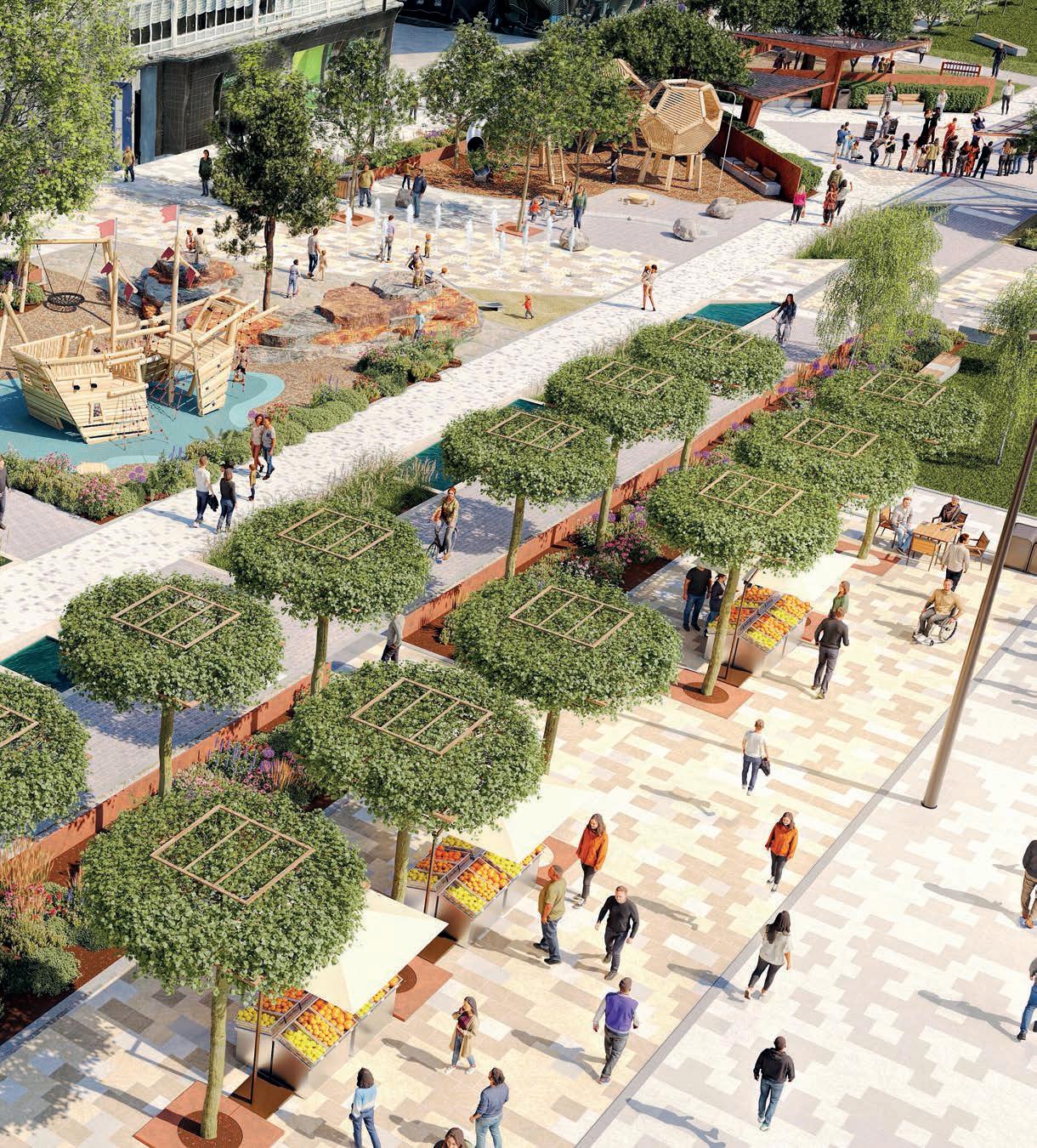

It’s set to be one of the biggest city centre play spaces in the country and – with a key feature wooden ship – Plymouth’s Armada Way play village is ship-shaping up to be a destination in its own right. Measuring 1,120sqm – the size of nearly five tennis courts – the development will put play into the heart of the city’s massive regeneration project as part of a deliberate move to change how people use the post-war city centre.
The play area is part of a larger regeneration project of Armada Way, driven by Plymouth City Council. Councillor Mark Lowry, Cabinet Member for Finance and city centre champion, said: “The High Street has changed dramatically. Online shopping is here to stay but we still want
our city centre to be alive and buzzing with people. This regeneration programme is about bringing people back into the city centre – not just to shop but to play and to meet up.”
Earlier this year, Plymouth City Council set out a vision to create 10,000 new homes in the city centre, so somewhere for children to play on their doorstep will be crucial to families having a happy, healthy life. The Armada Way play village goes a long way to cater for the need.
Martin Ivatt, the council’s Regeneration and Placemaking Manager, said: “There’s a lot riding on this, with more families expected to live in the city centre, we want to create something special.

“It’s going to be a fun and fantastic place for kids – but this is about more than play – if just a few more people spent £5 on a coffee and cake watching their little ones, that’s money going into our businesses. Kids playing there after school means more people out and about in the city centre, it feels safer and busier.”
The play village was designed by city-based Studio Agora Architects and was based on biomes. Themed into zones – desert, mountain, aquatic, forest and grasslands, the village is about encouraging young explorers to use their imagination.
As well as swings and slides, the desert island section for toddlers will have a pirate ship for wannabe sailors from Britain’s Ocean City. There’s circular wooden seating for story telling – handily close to the Central Library.
A large mound of rocks with a slide is planned for the mountain section while there’s lots of wet play in the aquatic zone, with water jets and a shallow rill for damming and scooping water. In a nod to Plymouth’s history, this part will have studs on the ground marking where the Plymouth leat ran – a water course dating back to Drake’s era.
The forest section will have giant dodecahedron shaped tree houses that link
to each to each other with slides, cargo nets and monkey bars to swing from.
There will be a quieter, calmer sensory play zone separate to the main play area for children who are neurodiverse. Based on the grasslands theme, it will have varied surfaces, levels of grass for texture and interest, bark mulch and sand areas. Special attention is being paid to sound with a sound stone, windpipes, impulse spheres and tubular chimes.
The selected features have taken into account access and usability by children with disabilities.
Among the play companies supplying equipment for the project are KOMPAN, Richter, Duncan & Grove. Installation work began 24 September.
Lee Ferris from Studio Agora said: “The concept is based on Get Set Explore. The design references Plymouth’s maritime heritage and its role in exploration.
“As children we are at our most inquisitive, so wanted them to explore all different areas within the play village and ignite sparks of interest in travel and different habitats through play.”
The project’s principal contractor is Morgan Sindall, with LARC construction as groundworkers and OCMIS delivering the water feature and dancing jets. The Rathbone Partnership are working as landscape architects, Ridge as structural engineers and WSP as project managers.


Retail-ready grip socks Drive secondary spend













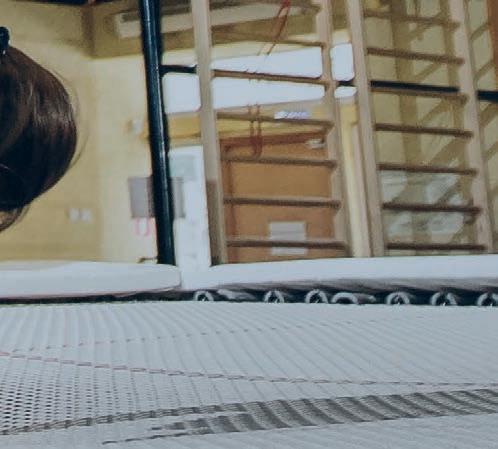













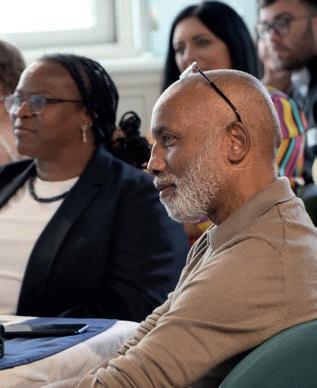





Childhood education platform
Tapestry and Amber OgunsanyaWilliam, aka Playworkeramber, have joined forces to launch an animated film called Let Play Lead the Day.
Aimed at families, the film and accompanying resource pack celebrate the joy and importance of children’s play, as well as telling the story of Amber Ogunsanya-William’s own experience of growing up in an adventure playground.
Amber Ogunsanya-William’s childhood was spent in Tower Hamlets in London which had very limited access to parks and green spaces. Her father, however, managed an







My father was a magician of imagination who transformed ordinary space into extraordinary adventures
adventure playground and this gave her an imaginative wonderland in which she thrived.
“I literally grew up in the adventure playground,” Ogunsanya-William says. “My father was a magician of imagination and a storyteller who transformed ordinary space into extraordinary adventures. I took it for granted but now I realise my experience of play was quite different to my peers.”
Figures from Play England highlight how play – and opportunities for play – continue to be under threat. According to Play England data, there has been a dramatic drop in children’s access to play compared to previous generations. Just 27% of children said they regularly play outside their homes, compared to 71% of the baby boomer generation. For those aged specifically between 55 - 64, it was 80% showing that rates of play have declined steadily in just a few generations.
Tapestry collaborated with Ogunsanya-William on the animation in order to help champion children’s freedom to play. The company works extensively within early years and with primary schools.
Dr Helen Edwards, co-founder of Tapestry and a former nursery owner, said: “We hope all the settings and schools that use Tapestry will share the animation with the families in their learning communities, helping to spread the message about the essential role of play.”
A recent survey by Tapestry showed that early years settings are using a variety of ways to share ideas and resources for play at home, Dr Helen Edwards explained: “We found they were providing newsletters with ideas for play at home, modelling play in class and using tools like Tapestry to share ideas.”

Play doesn’t require expensive toys – it’s everyday magic that can happen anywhere
Angela Carter, Head of Community Services at Lloyds Park Children Charity – which runs a nursery in Walthamstow, London –highlights the central role of play in children’s development and in creating community. “At LPCC, we know play is more than fun, it’s how children learn, connect, and grow,” she says.
“Through play, families build understanding, empathy, and stronger bonds. It’s a shared language that brings us together across generations and cultures.”
The film is supported by an accompanying free resource for families, which encourages families to repurpose materials for play and to think about play in the everyday. Written by Ogunsanya-William, it offers practical, real-world examples, playful prompts and gentle encouragement for parents and carers who might feel overwhelmed or unsure about how to bring more play into their homes.
“Let Play Lead the Day isn’t just a resource, it’s a celebration of everyday magic, a rallying cry for joyful connection and a powerful invitation for families to rediscover the transformative power of play,” Ogunsanya-William explains.
“Together with Tapestry, we’ve crafted something that’s not only visually beautiful but emotionally resonant, practical and deeply rooted in the lived experiences of families, playworkers, and childhood advocates. At the heart of the project is a vibrant, heartwarming animation that brings play

Amber Ogunsanya-William is an awardwinning international inclusive play worker, consultant, and play advocate who believes that play is a universal superpower. Her vision is to change how the world sees plays, redefine the role of play in education and community development, while driving positive behaviour change and elevating performance through purpose-driven solutions. Her work has earned her the honour of being named the first-ever NSPCC Champion of Childhood.
to life in the most accessible and inspiring way.
“Based on my own story, growing up surrounded by play and guided by my dad, a legendary playworker and now adventure playground manager, the animation shows how imagination can transform even the simplest moments into extraordinary adventures. It’s a joyful reminder that play doesn’t require expensive toys or elaborate setups. It can happen anywhere, in the kitchen, on the bus, in the garden - using repurposed materials, storytelling, and a little bit of wonder. It invites parents and carers to see play not as a task, but as a powerful tool for connection, creativity, and emotional growth.”
Let Play Lead the Day will be shared with 14,000 families across the UK and is supported by a number of organisations – including NSPCC, Play England, Eureka Children’s Museum, PlayBoard NI and PlayNation magazine.
“This project is a love letter to childhood, to caregivers, and to the playful spirit that lives in all of us,” Ogunsanya-William adds.
● To watch the animated film and to download the accompanying resource pack: https://tapestry.info/let-play-lead-the-day/
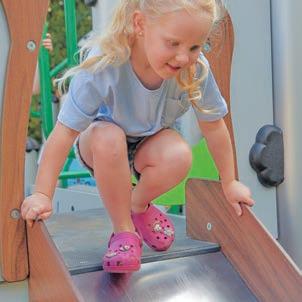
We design play equipment and play spaces that open up play to all abilities.







Sourcing and manufacturing locally is the most sustainable solution for all.











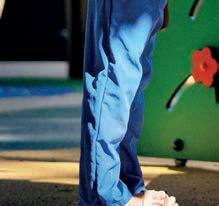
















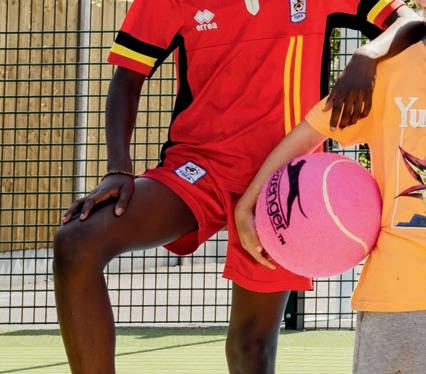




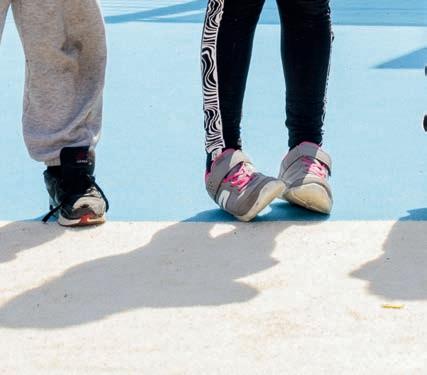




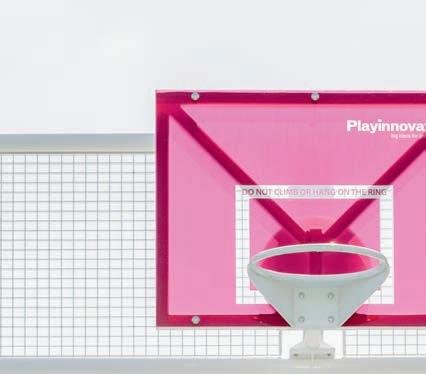

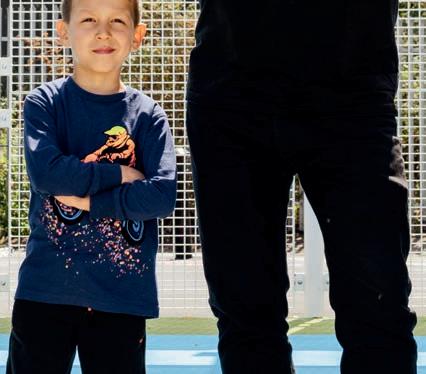
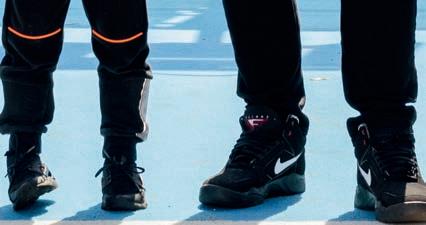










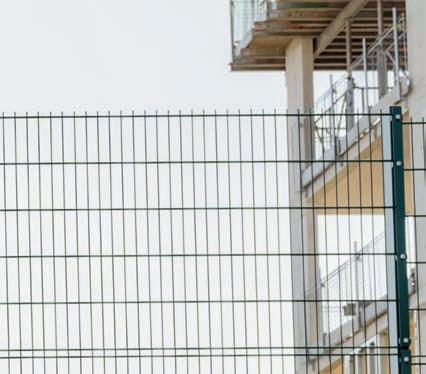




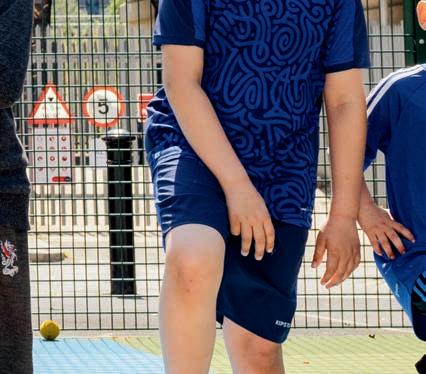


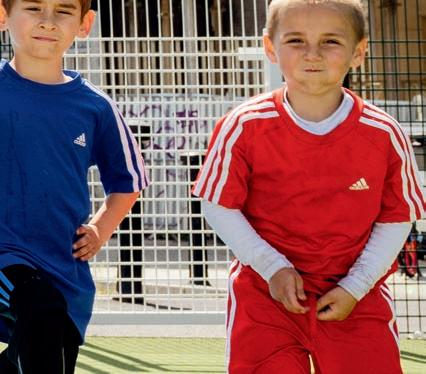

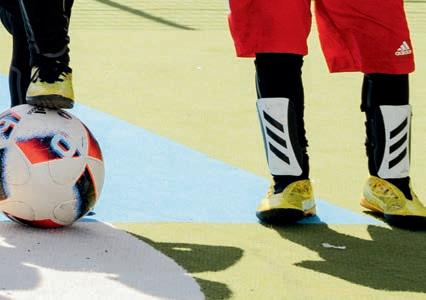
& builders of beautiful sports courts.






PlayNation nds out that designing well-loved play spaces comes down to two steps – listen to the end-users and then deliver on their wishes

No one wants to see schoolyards with unused play equipment in them.
The success of a play area – in other words, its popularity – is usually down to two aspects: a design that takes into account the different age groups that will use it and a selection of inspiring equipment that delivers to the design’s brief and intentions. Therefore, choosing age-appropriate playground equipment is the key to an engaging and buzzing schoolyard design. Get it right and the result can deliver a huge positive impact on pupils’ overall wellbeing, classroom performance and learning skills. To achieve results, however, requires a little bit of clever planning – which is why it is always
a good idea to speak to specialists in play.
One of these specialists is the play equipment company, Kompan. “School playground planning holds immense potential for promoting physical activity, fostering social interactions and encouraging imaginative play,” Kompan says.
“School-age children seem able to do and learn almost anything. They master basic coordination skills such as running, climbing and balancing; however, because their range of skills is so broad, offering skill development within a wide range of challenges is essential when planning a school playground.”
To help schools choose age-appropriate equipment Kompan has compiled a guide, outlining some design ideas for playgrounds. The guide is
When deciding on your new playground, you need to engage with your ‘consumers’ – the children

divided into three categories – primary school, secondary school and special needs. For more info, visit the Kompan website: kompan.com
Another company that specialises in a partnership-led approach when it comes to designing play spaces is Jupiter Play and Leisure.
“Our work is a result of a collaboration, understanding a space, a community and our client’s requirements,” Jupiter says. “Whether it is a landscape-led approach to connect children to nature, or a playground project to activate a community, our diverse portfolio of play projects showcase the innovation we deliver every day.”
Marco Boi, founder of Play Innovation, has a similar approach.
“When deciding on your new play ground, you need to engage with your ‘consumers’ – the children,” Boi says.
“What would they want to see included? Which sports would they like to play? While it’s impossible to please everyone, a well-managed consultation will give you an overview of what they would love to have – and end up spending hours on.
“This is the part of a project journey that I, personally, am most passionate about. Listening to, understanding and considering children – and ensuring their needs are at the heart of the project.”
So, what do well-designed, thoughtful and innovative school play areas look like? PlayNation has a closer look.
Clapham Manor Primary School, nestled on the edge of Clapham Common in Lambeth, South London has transformed its outdoor space with a brand-new Proludic play area designed to bring children closer to nature while encouraging active, imaginative play.
The centrepiece of the playground is Proludic’s focal Origin’ Robinia Multiplay Unit, a striking wooden structure featuring slides, a tunnel, climbing wall, elevated playhouse and wobbly walkways. With 29 different play functions, the structure can accommodate up to 34 children at once, fostering both adventure and teamwork.
Alongside it sits the Monkey Bars Wooden Trail, a horizontal ladder module crafted also from Robinia wood and stainless steel, designed for up to four players to challenge their balance and coordination.
The play area is completed with soft wetpour surfacing utilising a leaf design in parts, combining safety with natural inspiration. Using Robinia
Earlier this year, Playdale Playgrounds completed the installation of a new playground at Croft Community School in Durham. The project was part of the school’s expansion and focused on turning a blank outdoor space into an inspiring environment for play, learning, and sensory development.
Designed with inclusivity and creativity in mind, the playground combines physical challenge, imaginative play, and outdoor learning. Equipment such as the Inclusive Orbit Roundabout, Team Swing, themed multi-play, and sensory play panels encourages children of all abilities to play together, develop key skills, and explore at their own pace.
The new playground has transformed the school grounds into a vibrant hub where pupils can build confidence, stay active, and enjoy learning outdoors – all while celebrating the school’s unique identity.
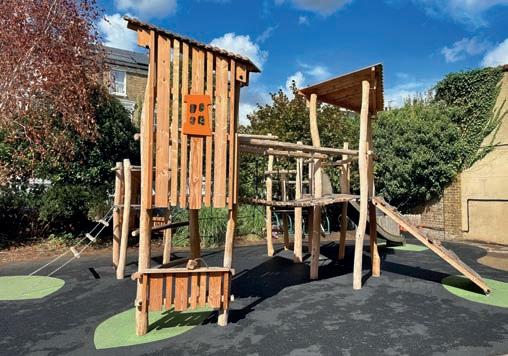
wood throughout, the Origin’ range recreates the feel of a forest trail, encouraging children to climb, balance and explore in a setting that blends seamlessly with the surrounding trees.
“Teachers report that playtime is now greeted with even greater enthusiasm, while pupils have praised the new equipment,” Proludic said. “The school community has welcomed the installation as a valuable investment in both fun and learning.”
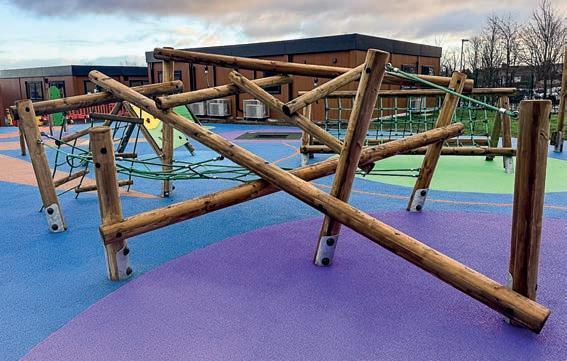

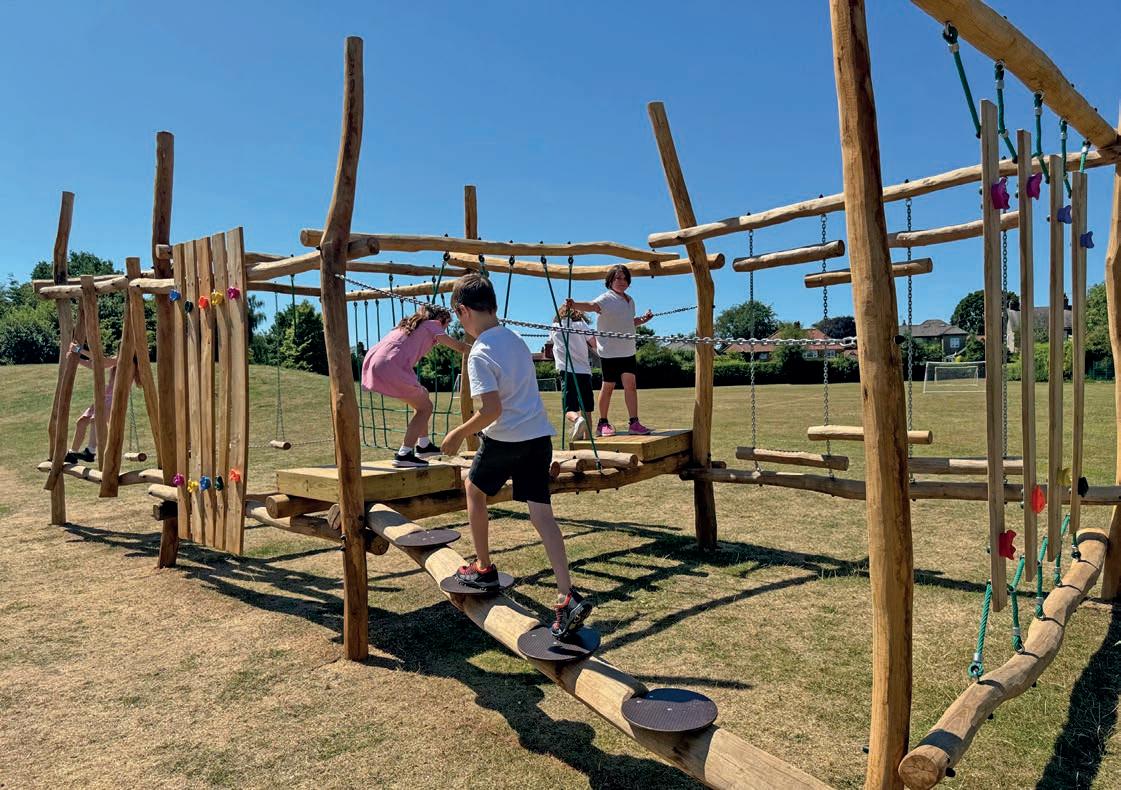
Before joining Playscheme as member of the salesteam, Michael Carr was the Deputy Head at Acomb Primary School, and is still close friends with the Headteacher there. So, when the school approached Playscheme to help transform its playground, Carr knew the company had to create something truly special.
The brief was clear: a space that worked both for children wanting to be active and for those who prefer a quieter playtime. As a result, Playscheme installed one of its innovative Scramble Stax adventure trails, a dynamic climbing and balancing challenge that encourages children to develop strength, coordination and confidence.
For the quieter corners of the playground, Playscheme replaced an old tarmac surface with soft artificial grass and added welcoming booth-style seating. These spaces have quickly become a haven for children who want to sit, read, play games, or simply relax. Due to the design, the playground has something for everyone – opportunities to be physically active and social, but also for some calmness.

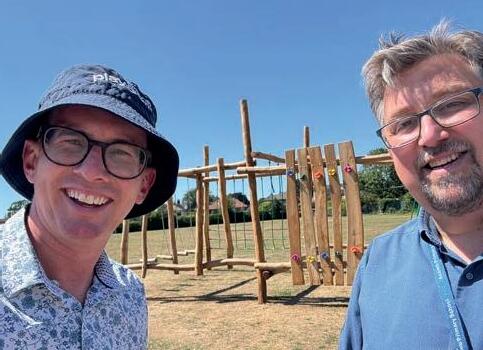
Ustigate Waterplay worked with the team at Cliffdale Primary Academy in Portsmouth to establish an allyear-round water play on the school’s playground. The project was brought to life by a unity of collaboration and fundraising between the school and its community. The project was launched in honour and memory of a “shining star” pupil, called Hayden-Jay Archbold, who had sadly passed away.
Cliffdale Primary Academy is a primary special school for approximately 220 pupils aged 2-11 years who have complex learning difficulties; the vast majority of pupils have autism and severe learning difficulties.
Thanks to the project, the school now has a water play favourite for all ages and abilities. There is an award-winning Vortex Astra with its gentle halo of cascading water streams and




360-degree rotation, several round sprays and a puddle with an activator, because Cliffdale pupils love rainy days and a puddle to splash in.
There is a giraffe bench to sit and enjoy the view and a monkey glockenspiel to enjoy a tune or two. Also included are aided language boards designed by Cliffdale Primary Academy, to help children to communicate. Plant room insulation has been installed to ensure water play can be enjoyed all year round.
Wicksteed has delivered an inclusive playground project for Co-op Academy Brierley in Leeds. The play area is designed to meet the diverse needs of pupils aged between four and 16 with special educational needs and disabilities.
Working closely with the school, Wicksteed created a tailored Sensory Integration Area and submitted a complementary plan for their Autism Suite, which was accepted and went above and beyond the original brief. Every element was chosen with inclusivity at its heart – focusing on variation in difficulty, movement, colour, and layout to support a wide range of physical and sensory needs.
The space features low-maintenance, high-quality equipment offering climbing, swinging and spinning opportunities – including two swing types, two roundabouts, sensory engagement points and the showstopping Treetop Towers. With dual deck heights, slides and interactive panels, this imaginative centrepiece promotes fine and gross motor development, sensory exploration, and collaborative play.
“It’s more than a play area — it’s a space that supports learning, exploration and joyful experiences for every child, no matter their ability,” Wicksteed said.




















